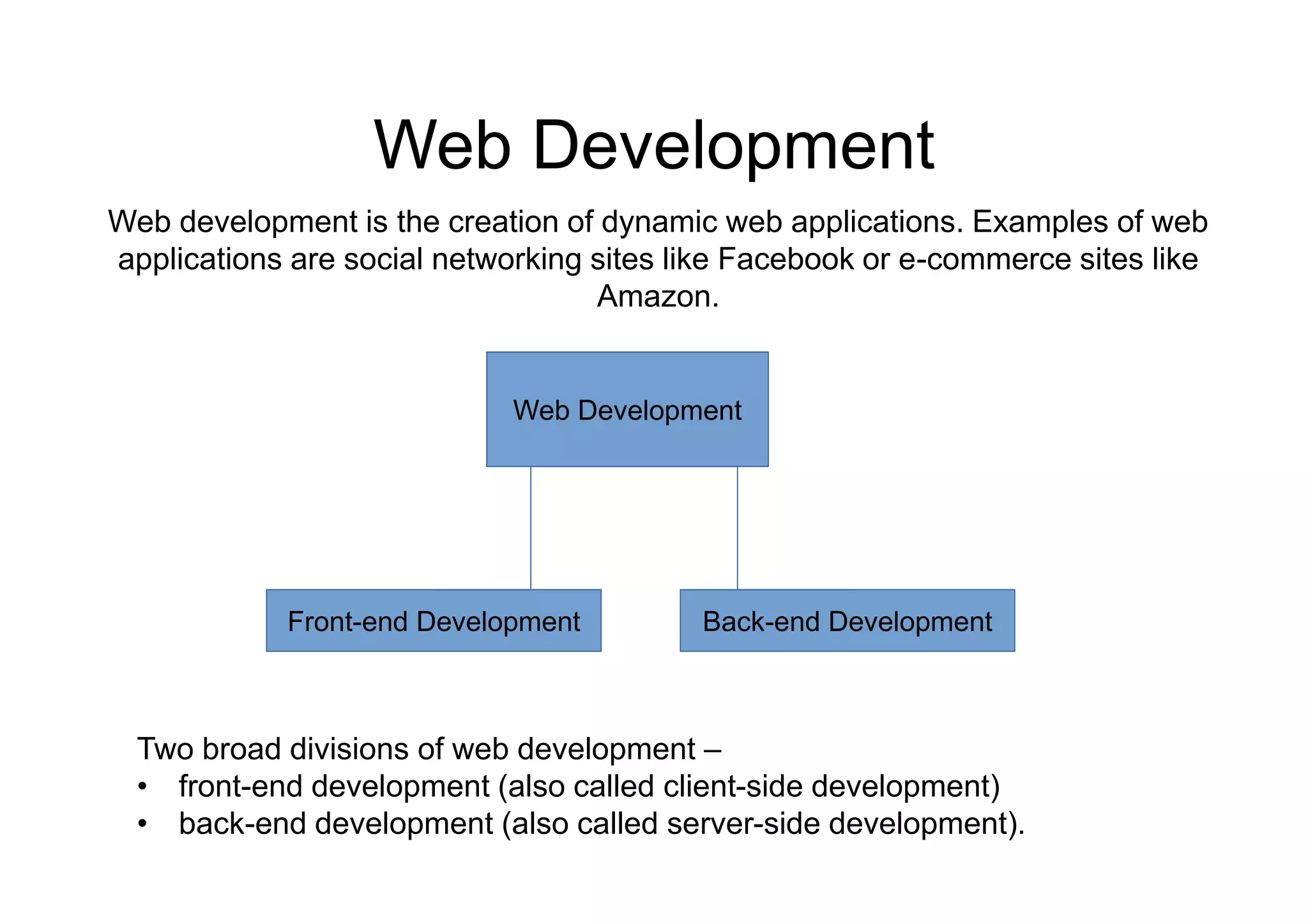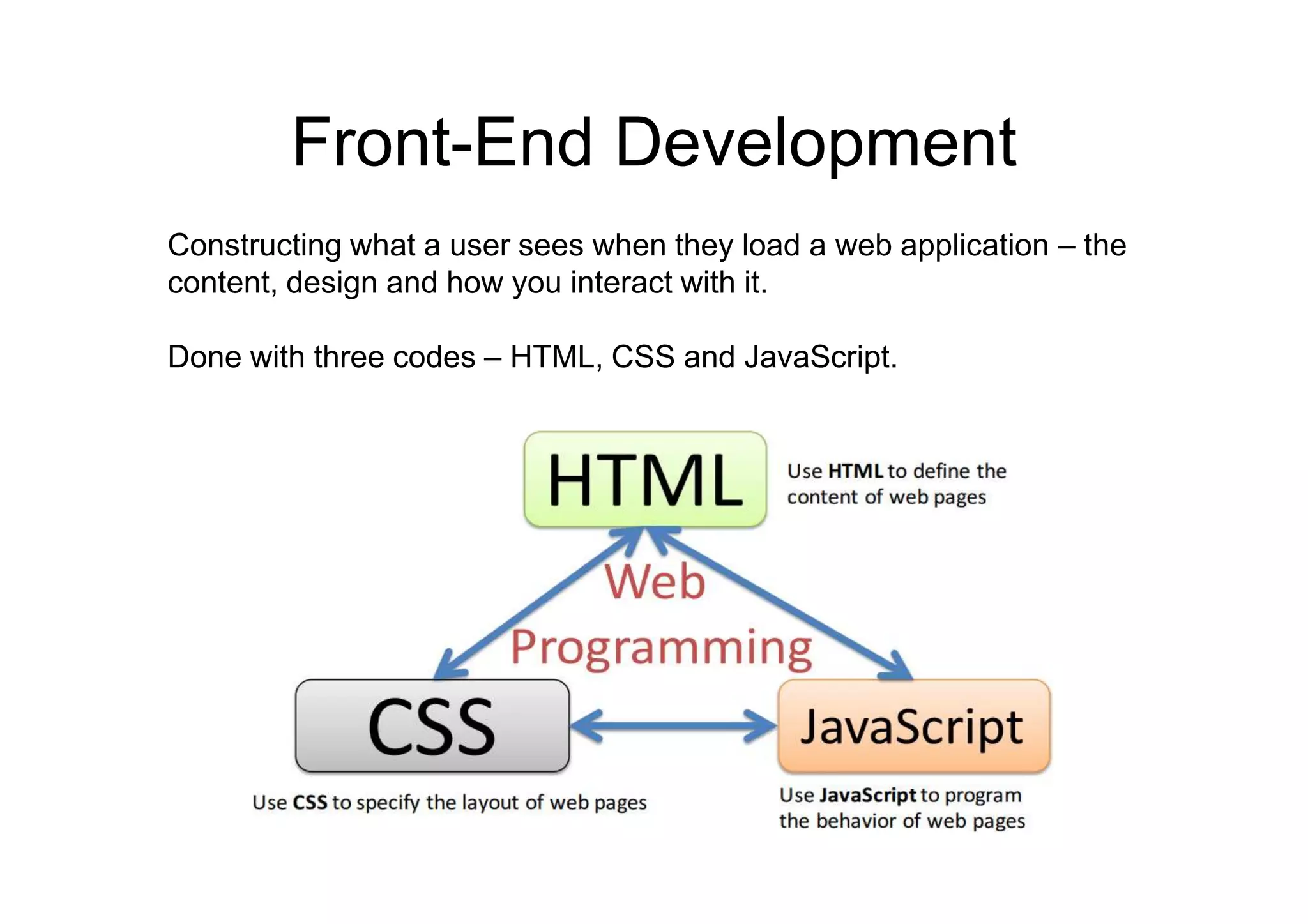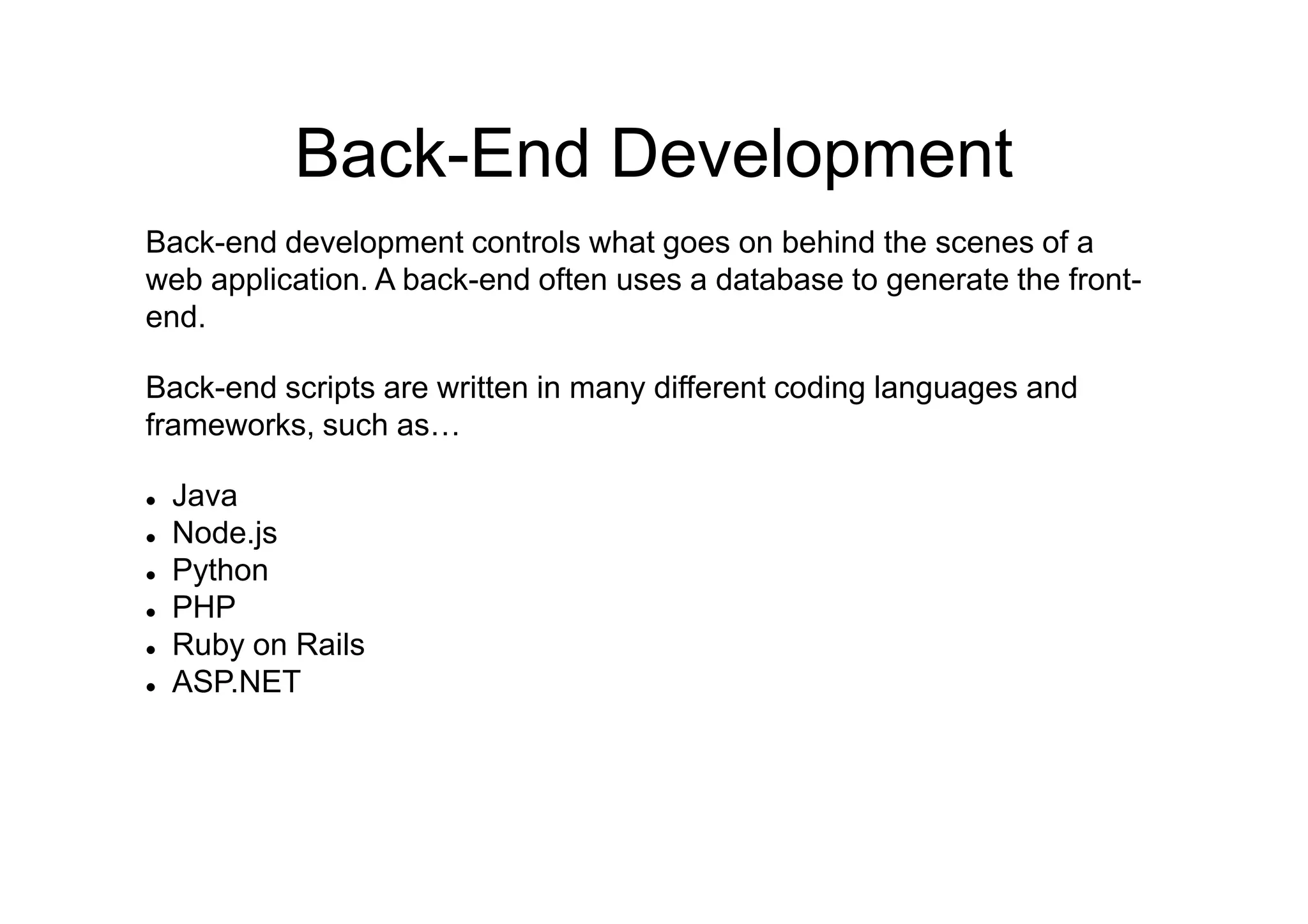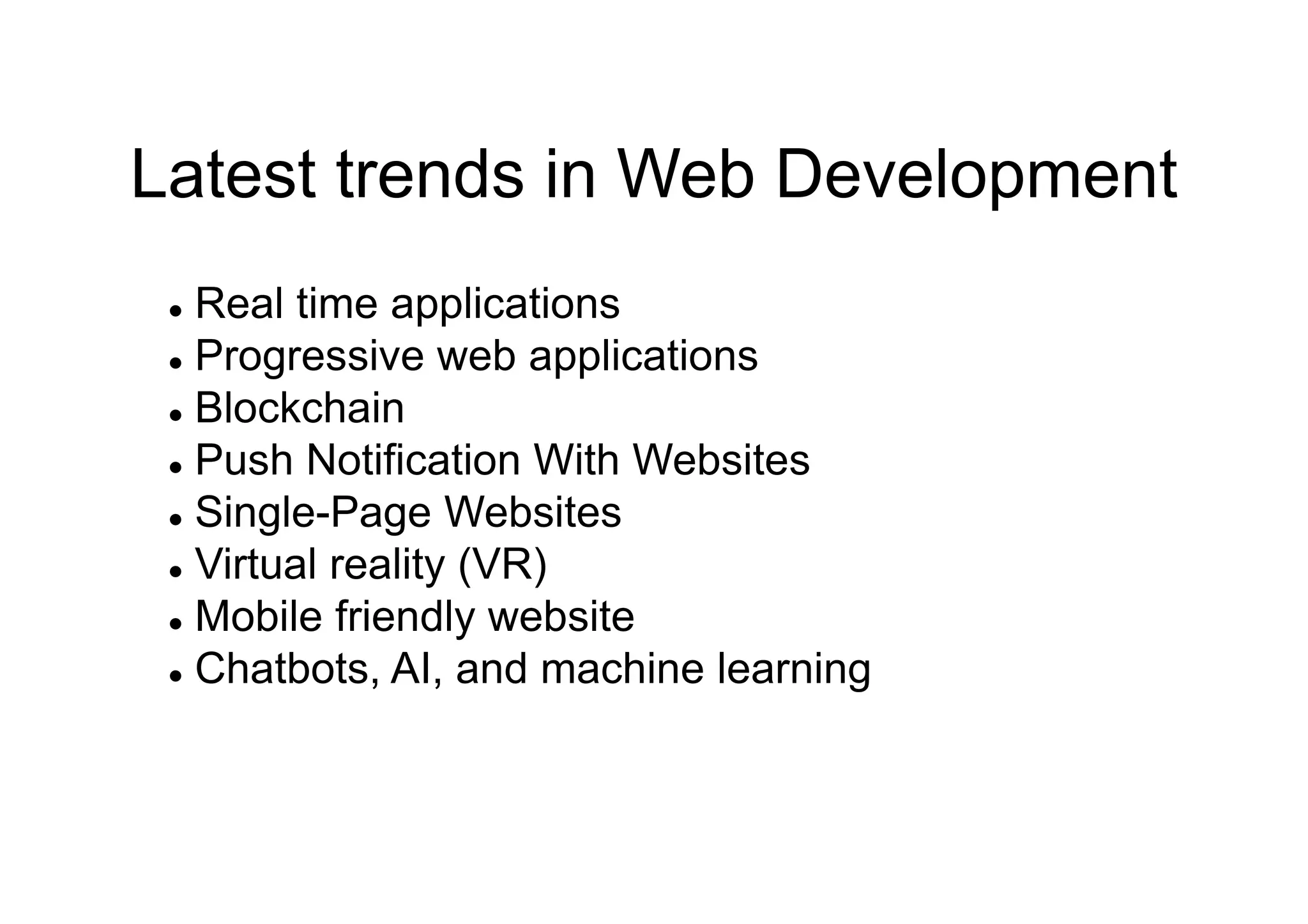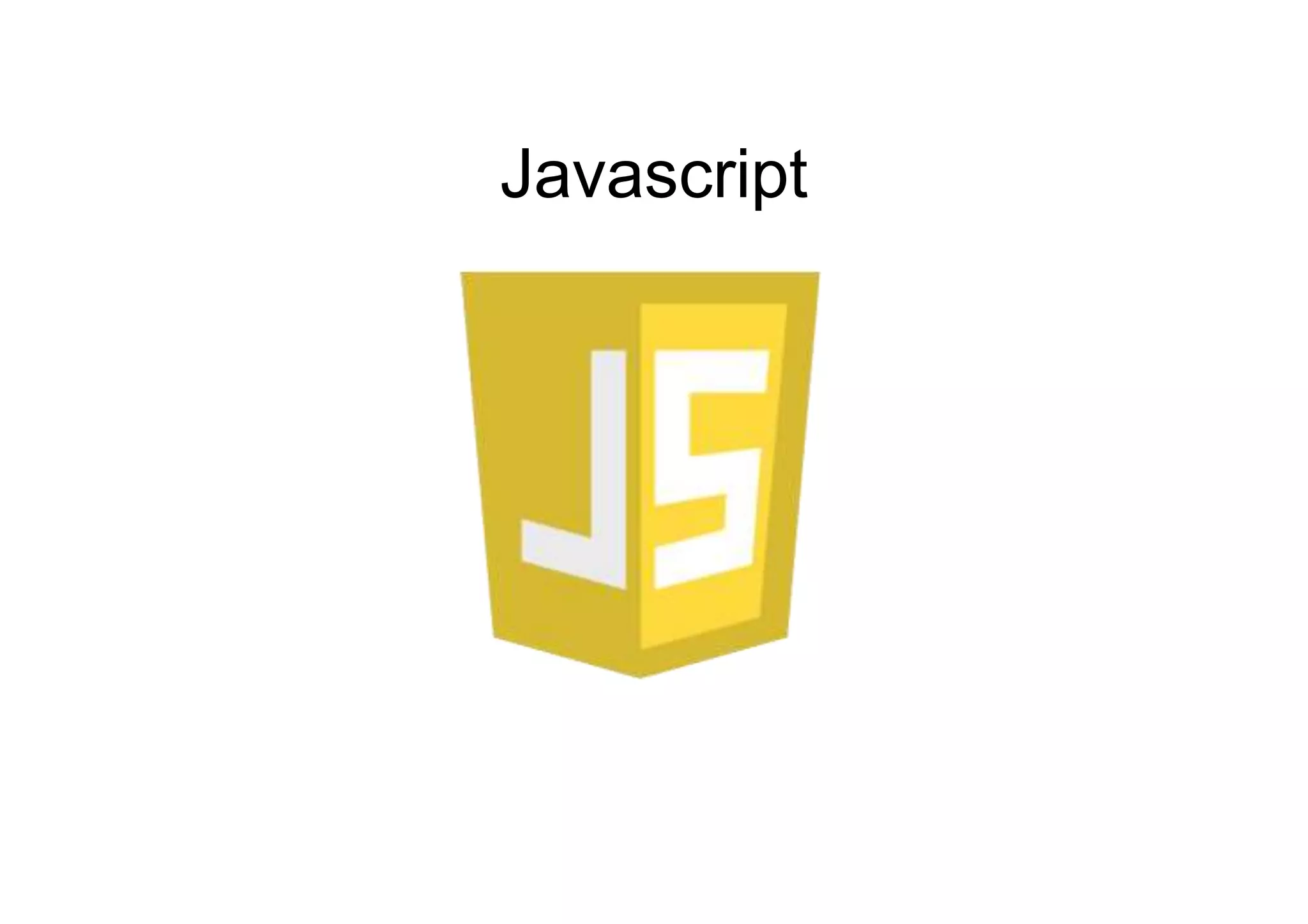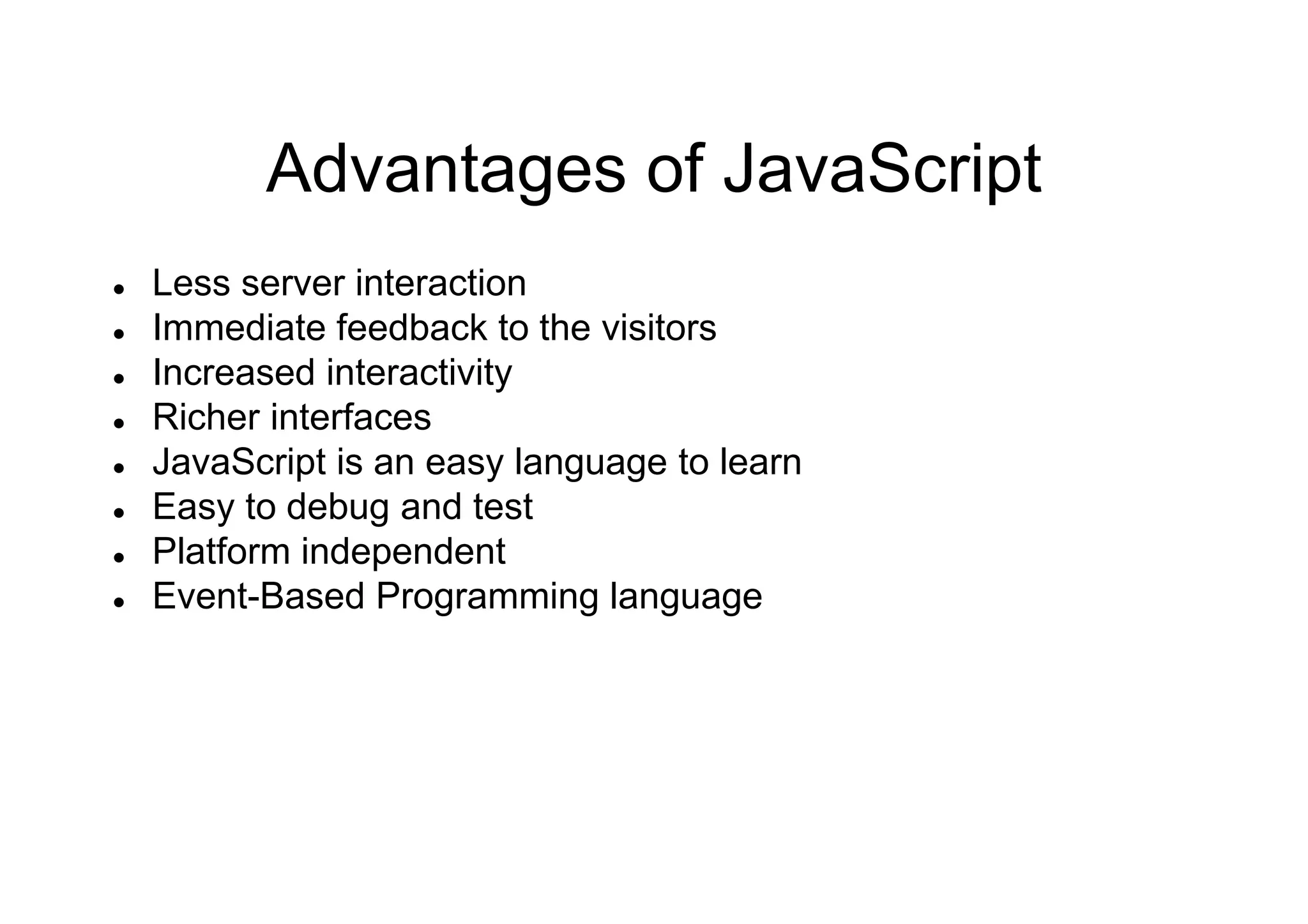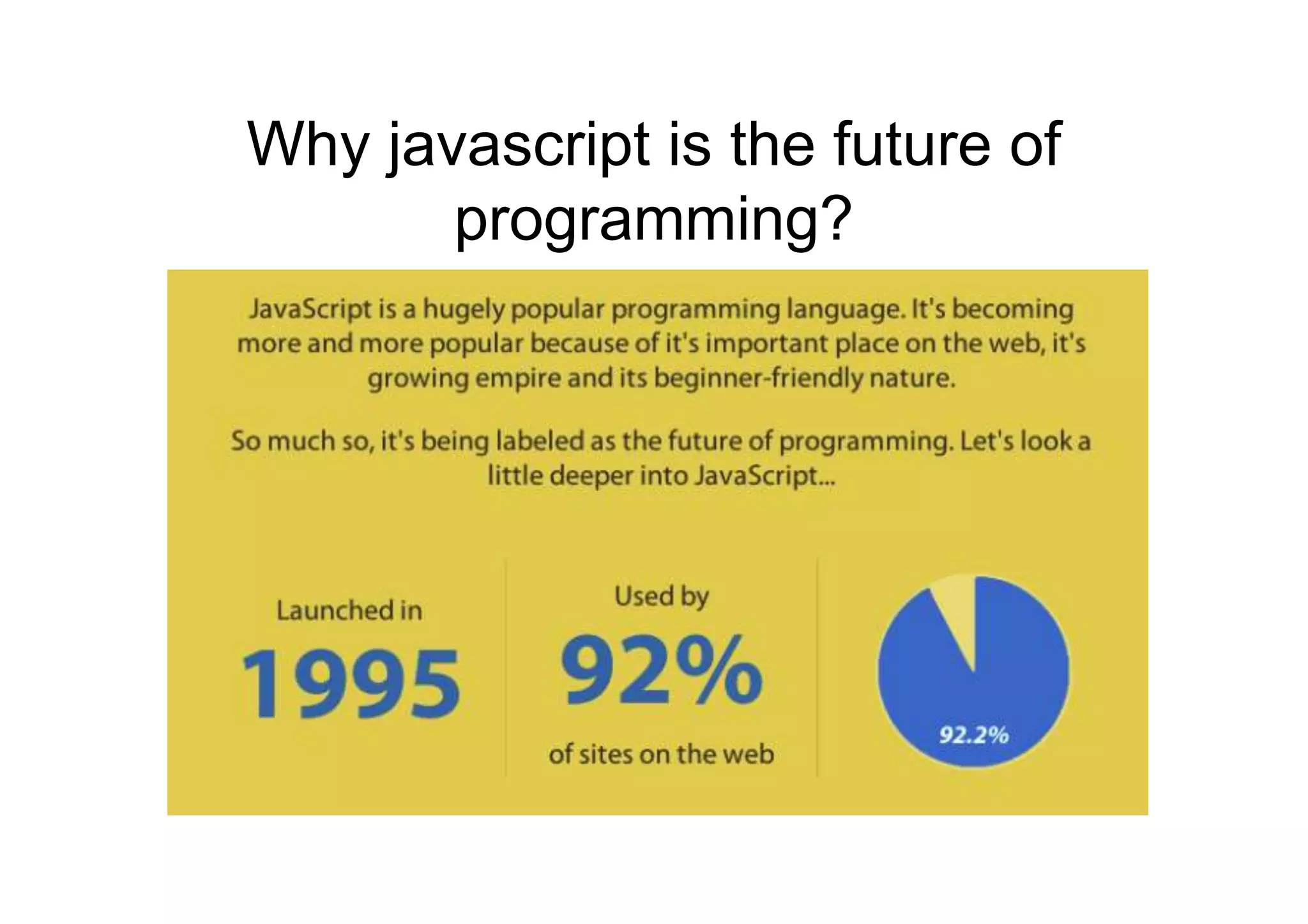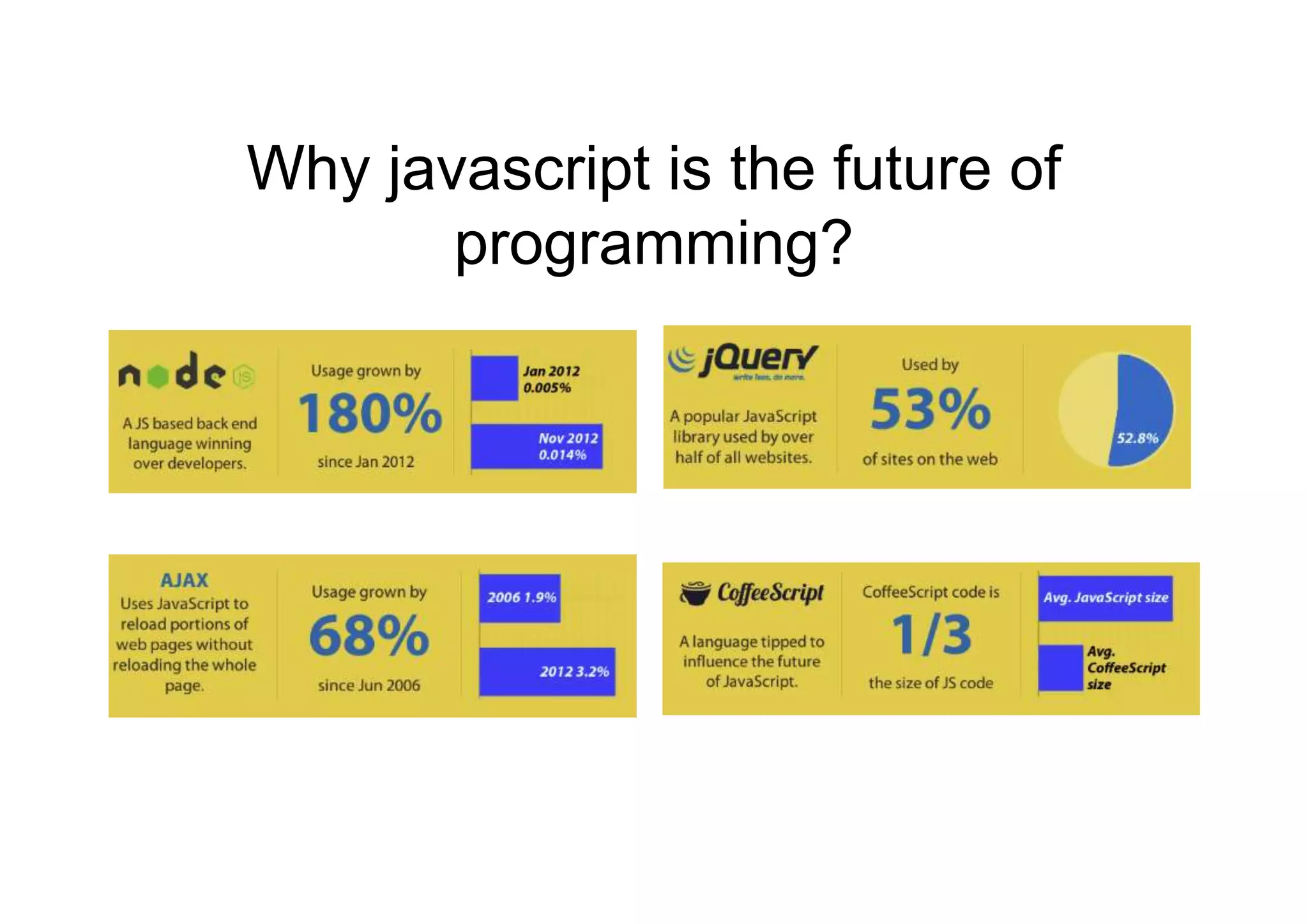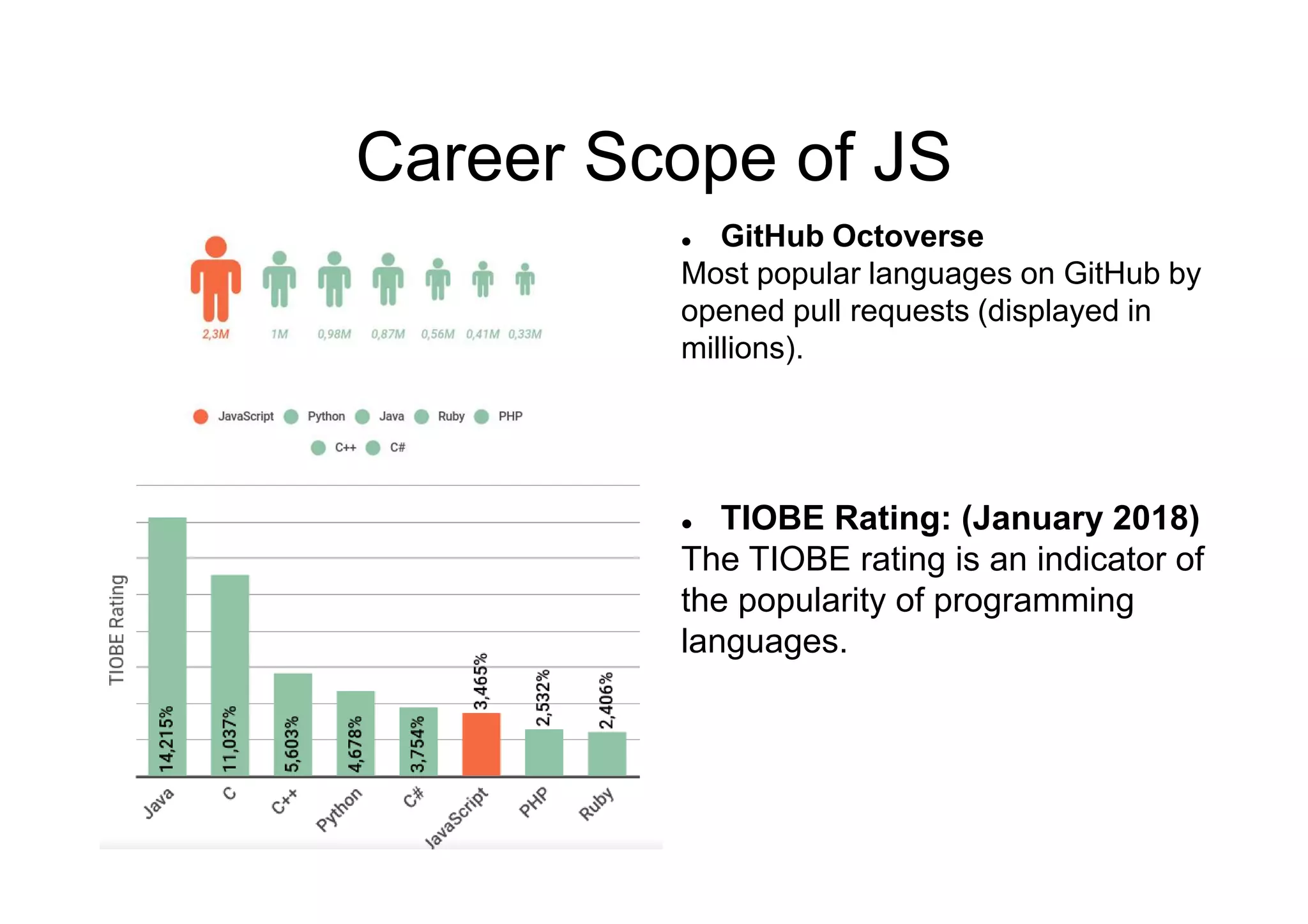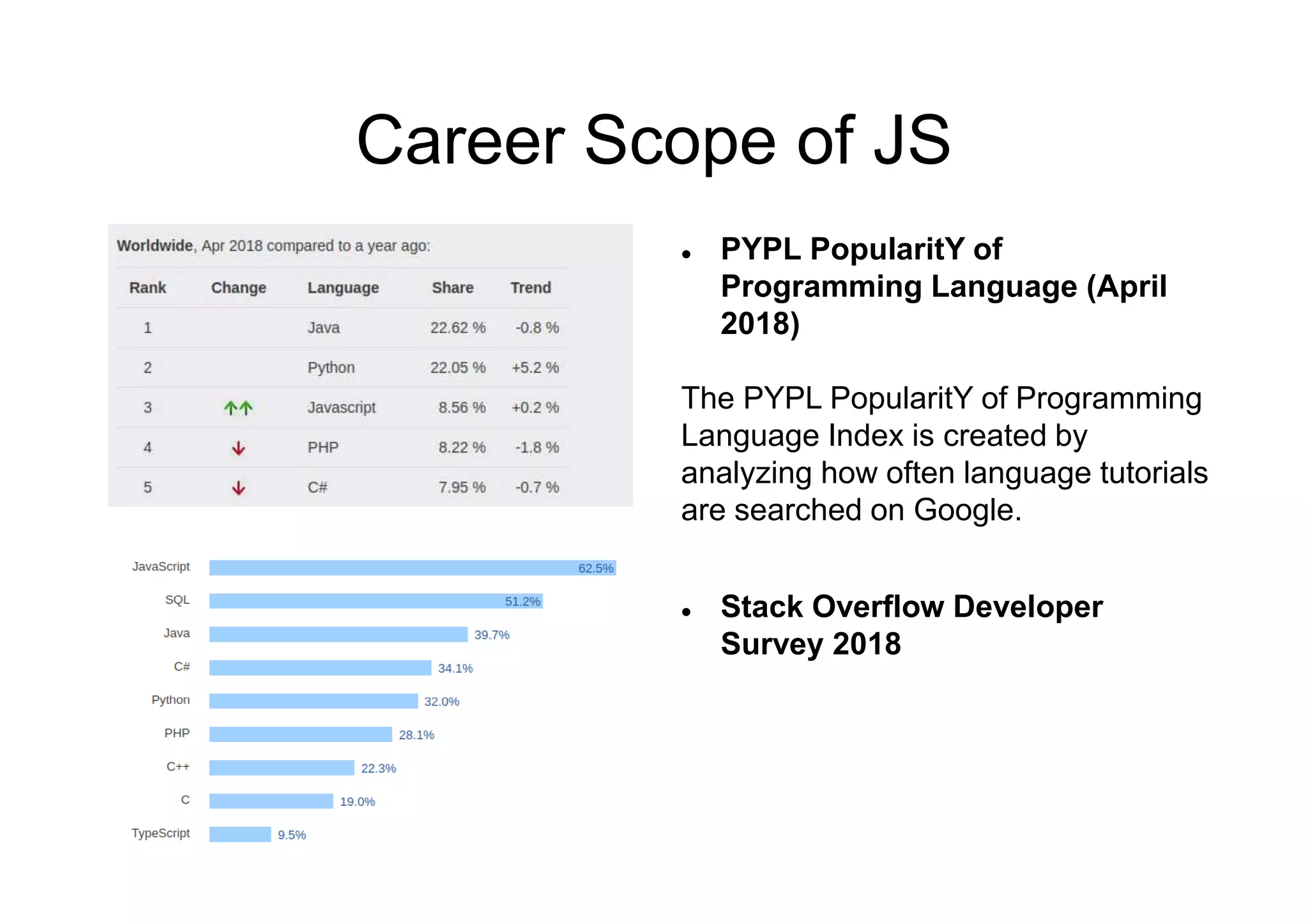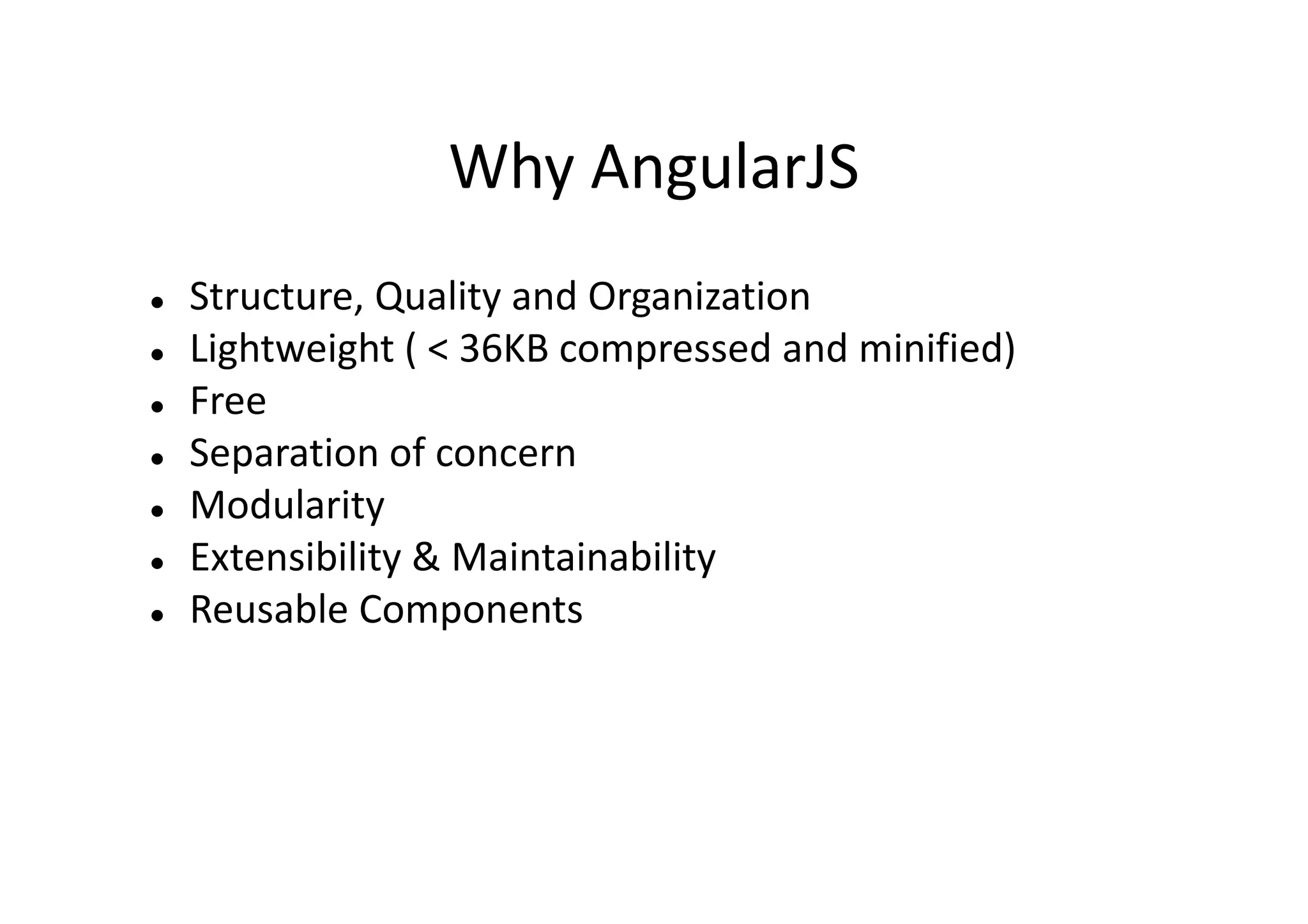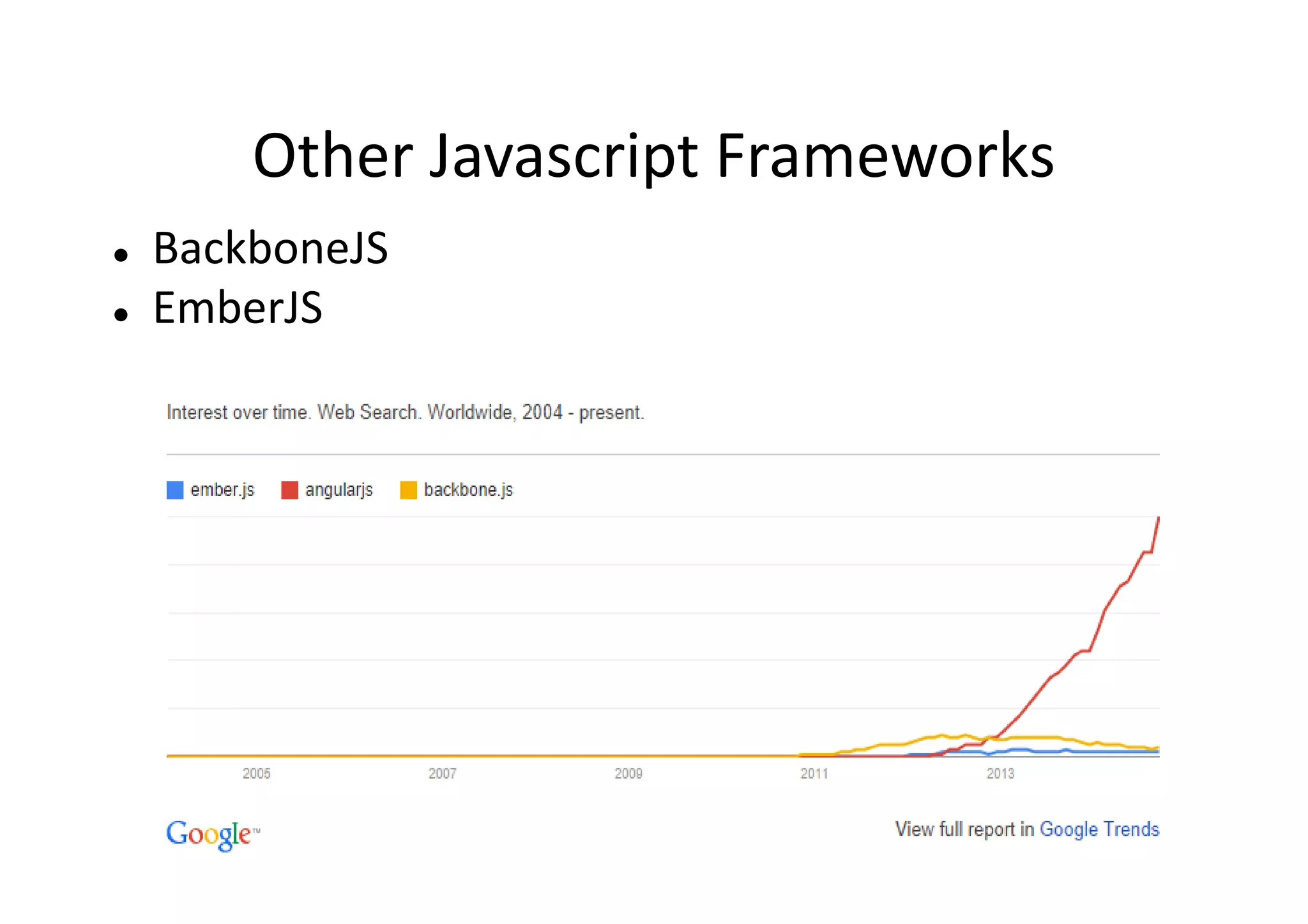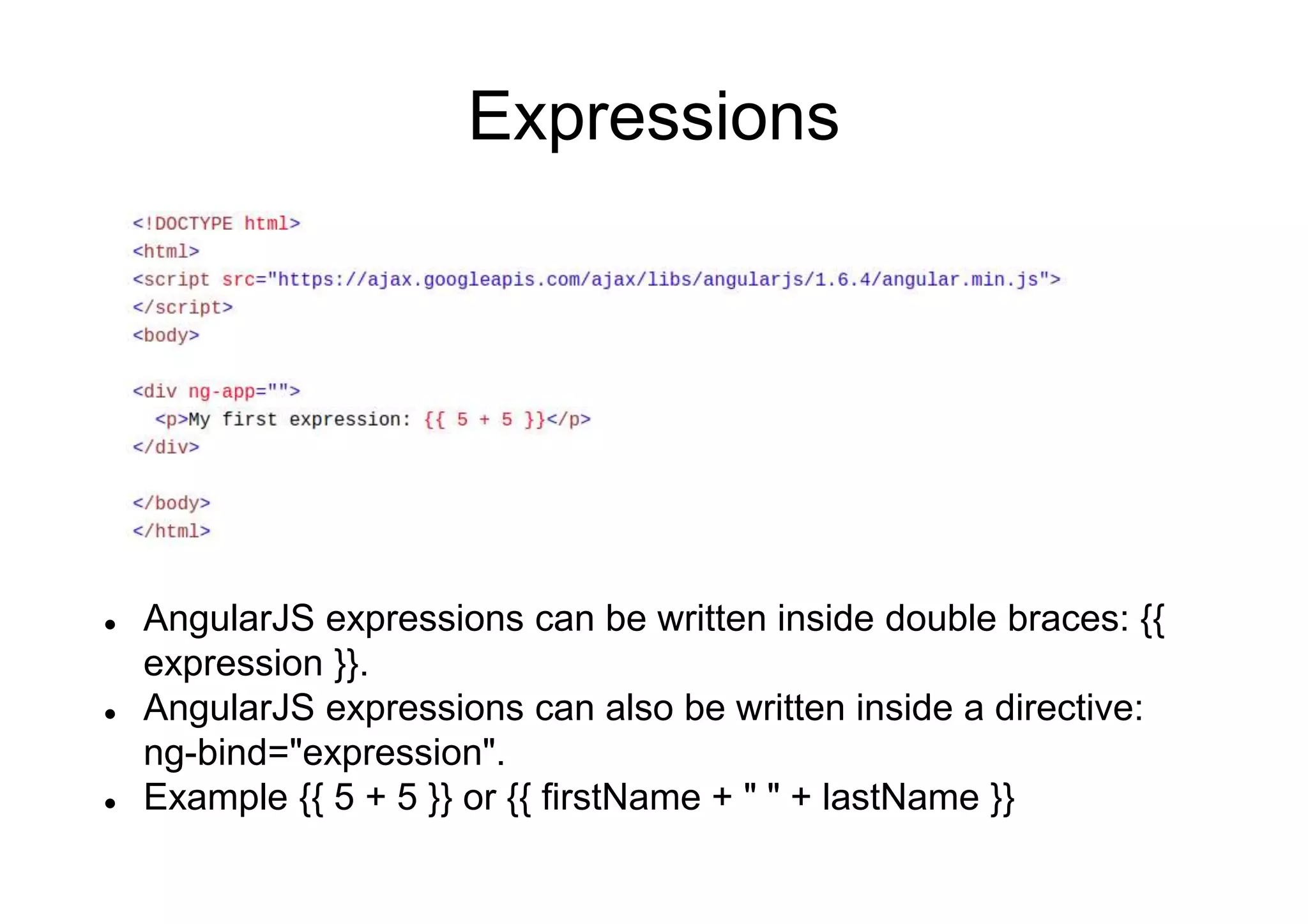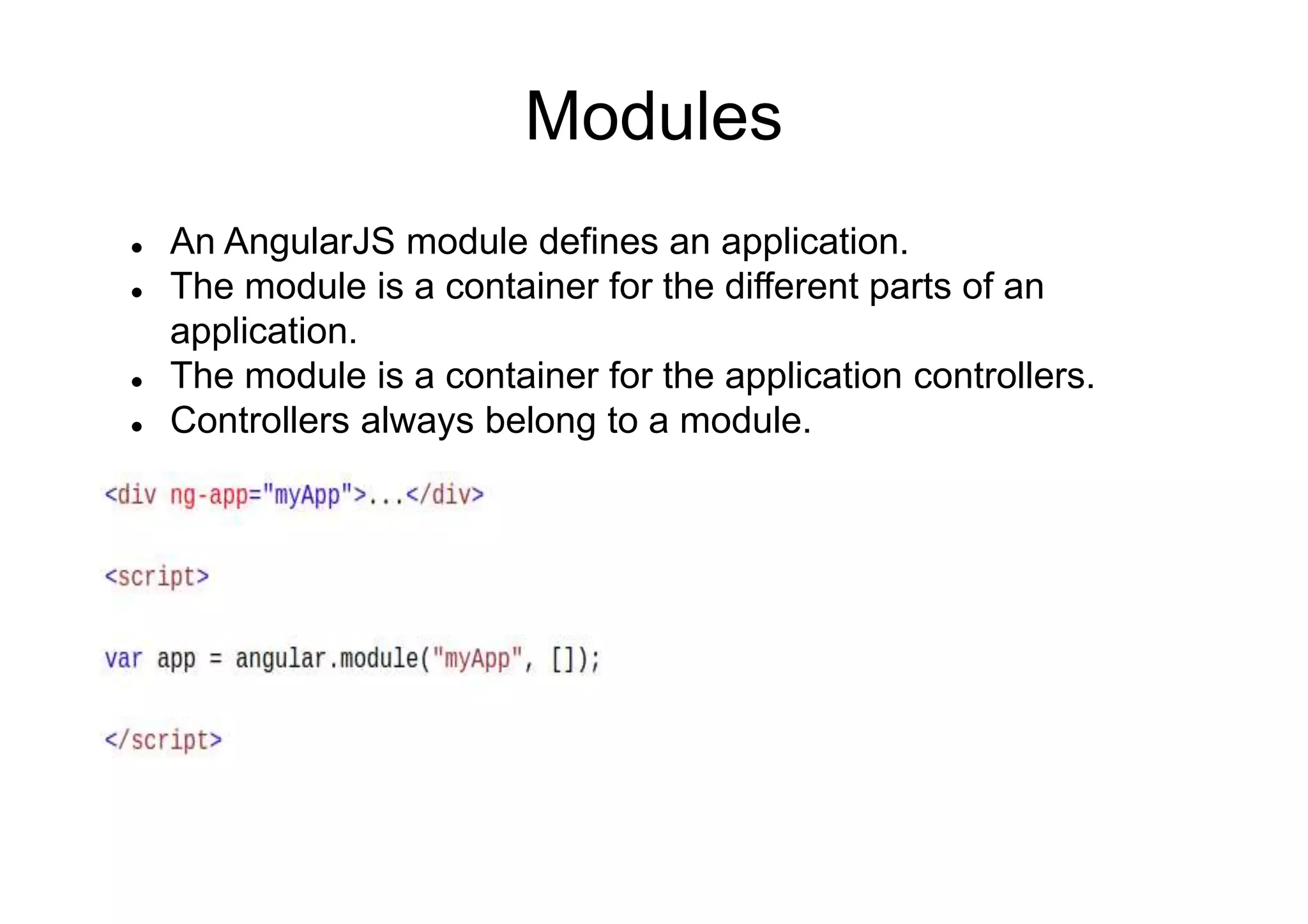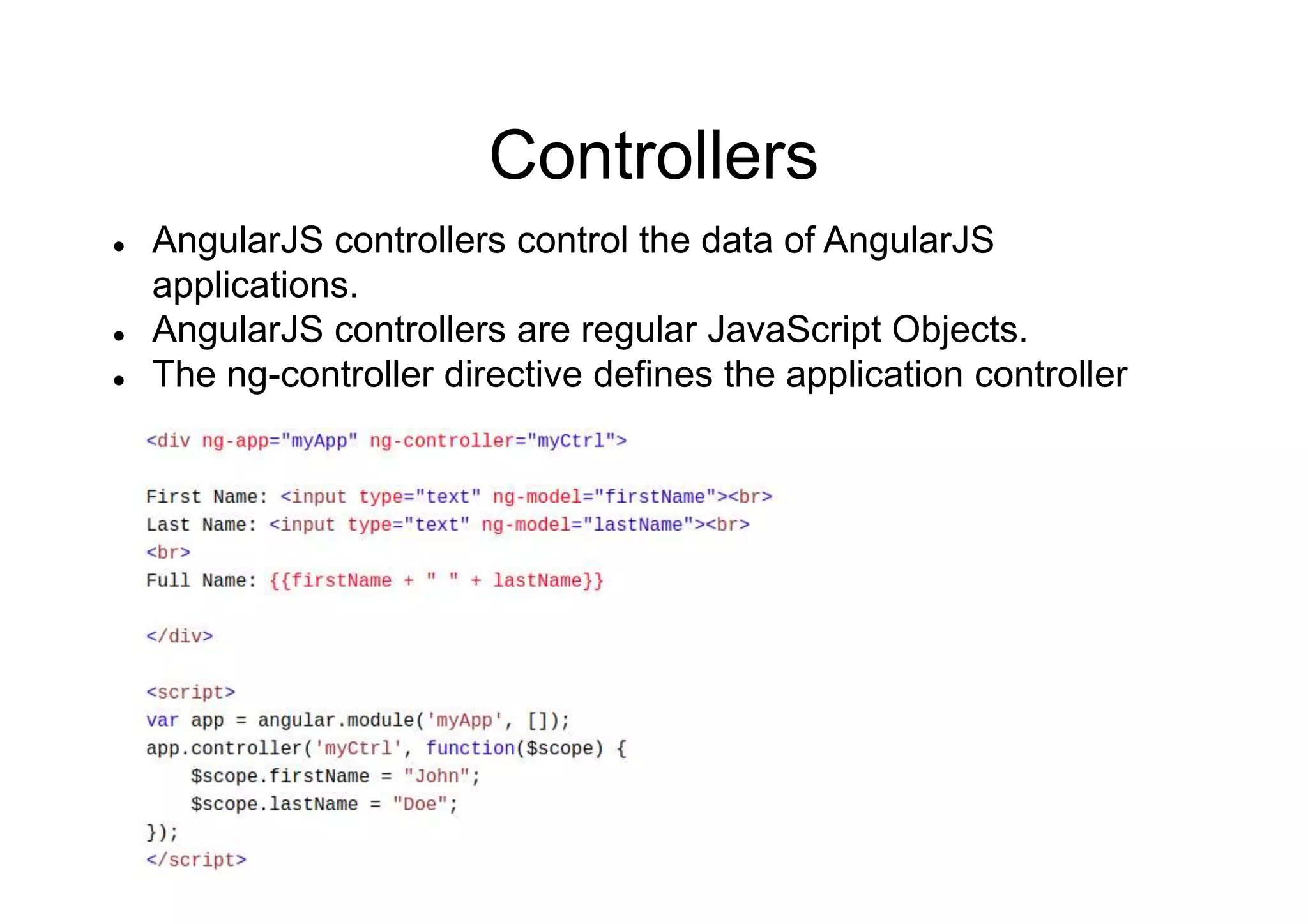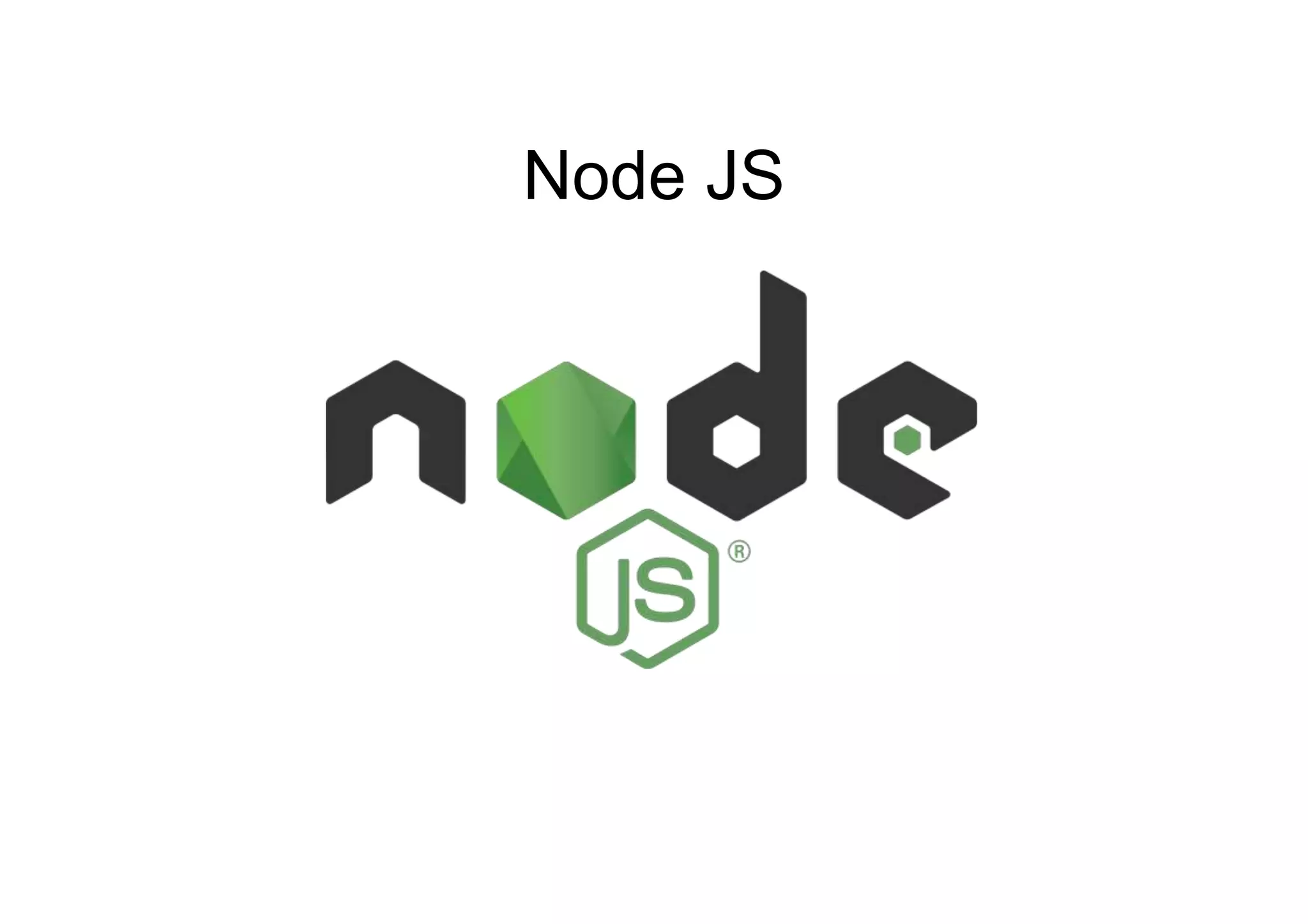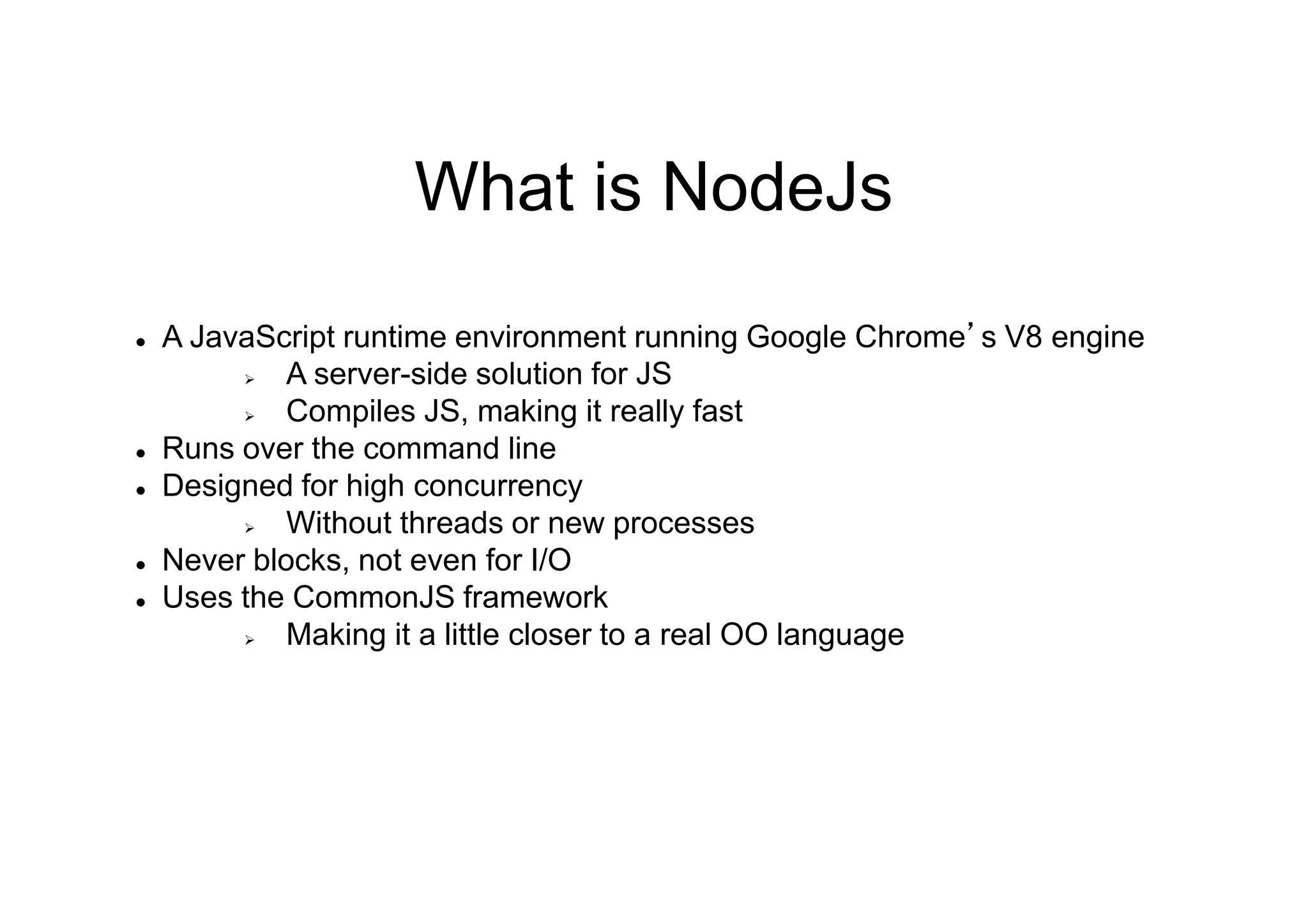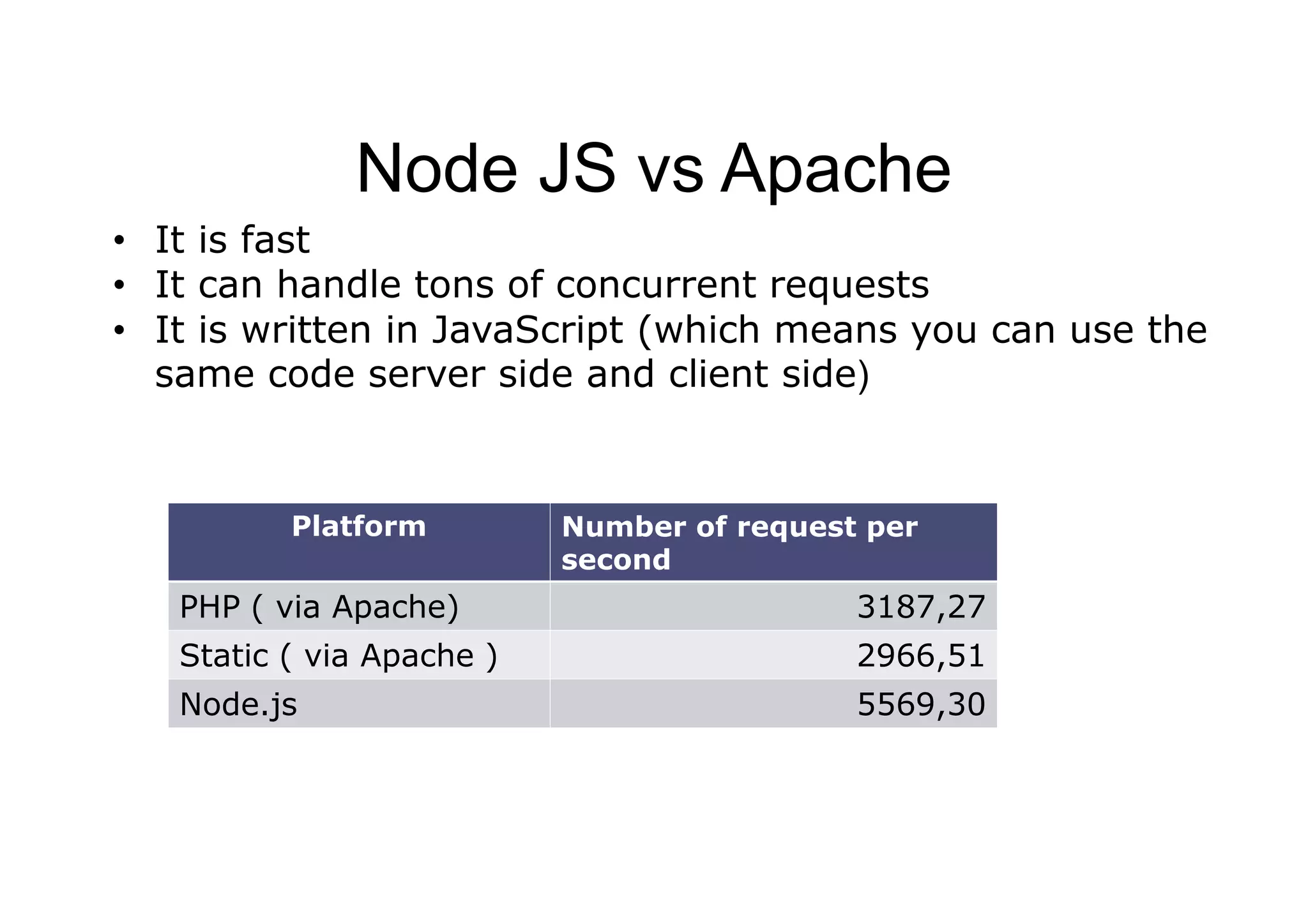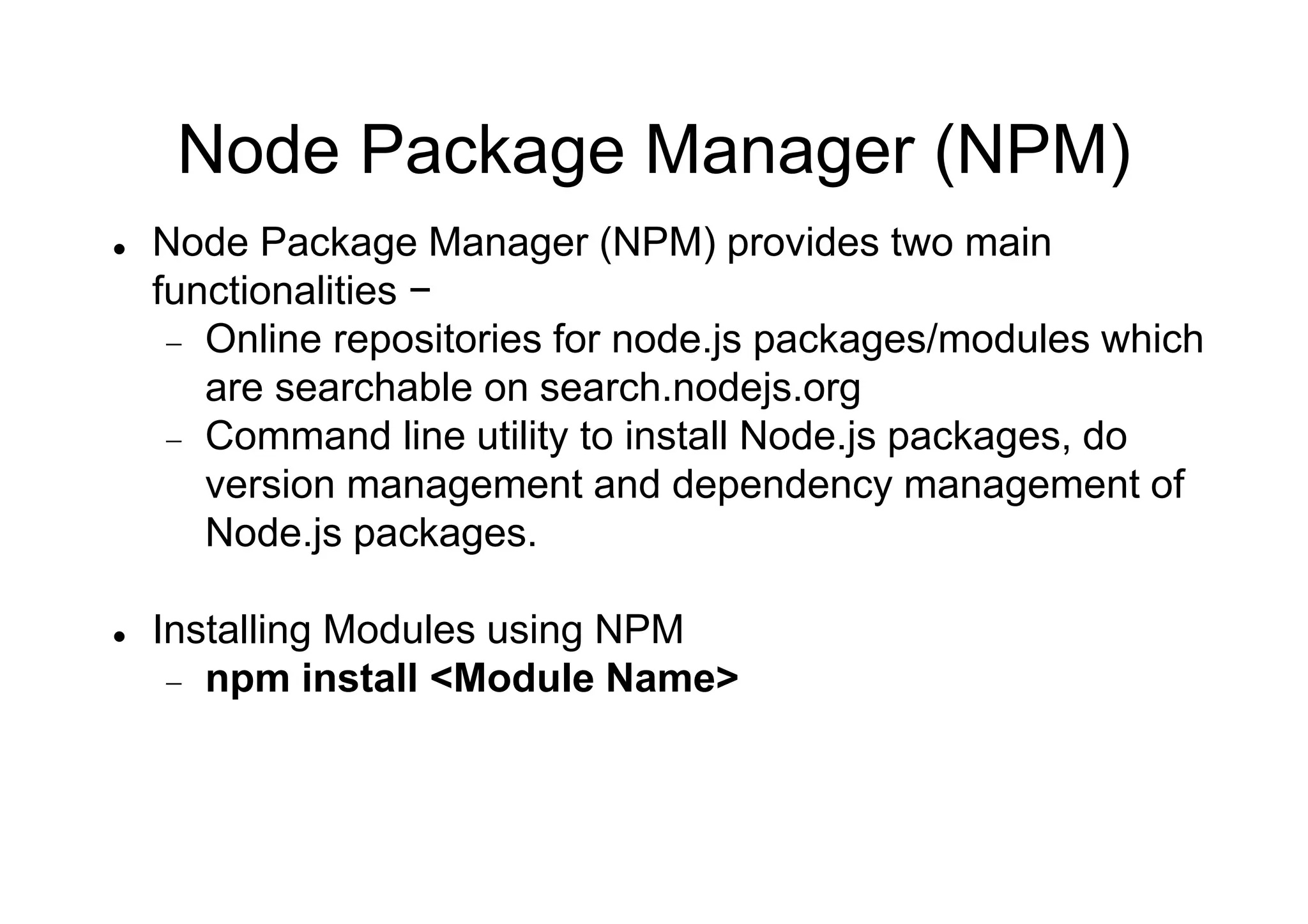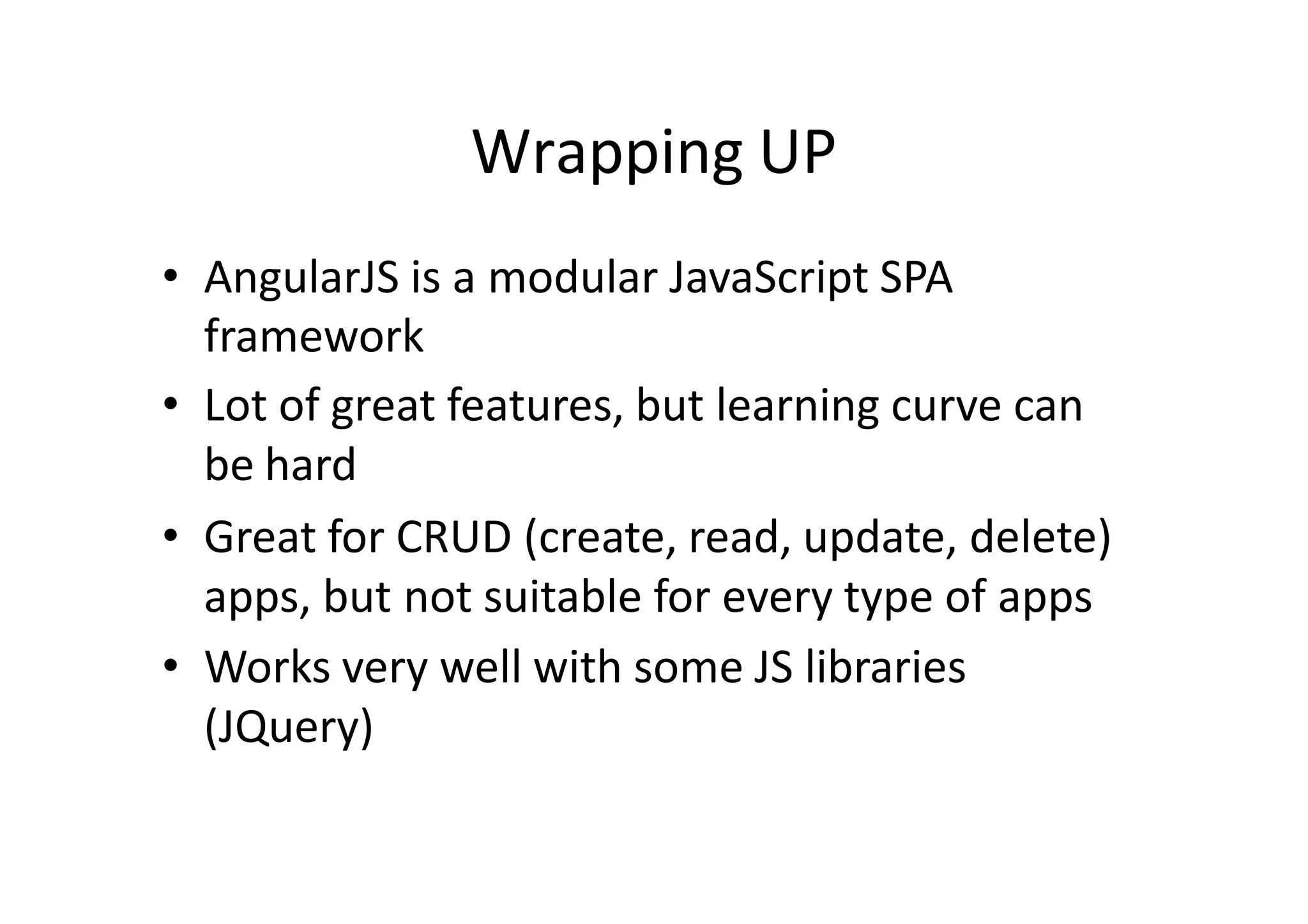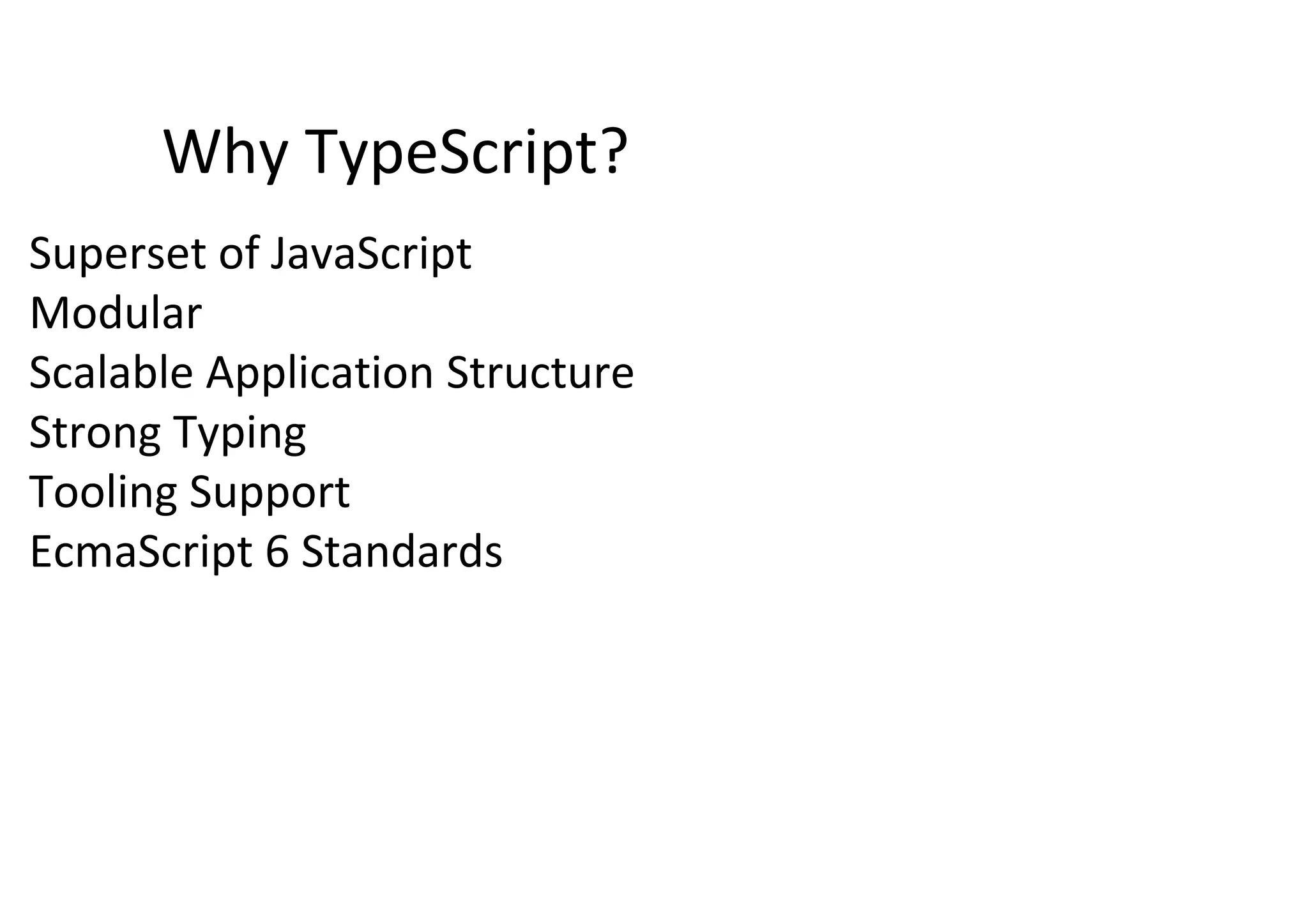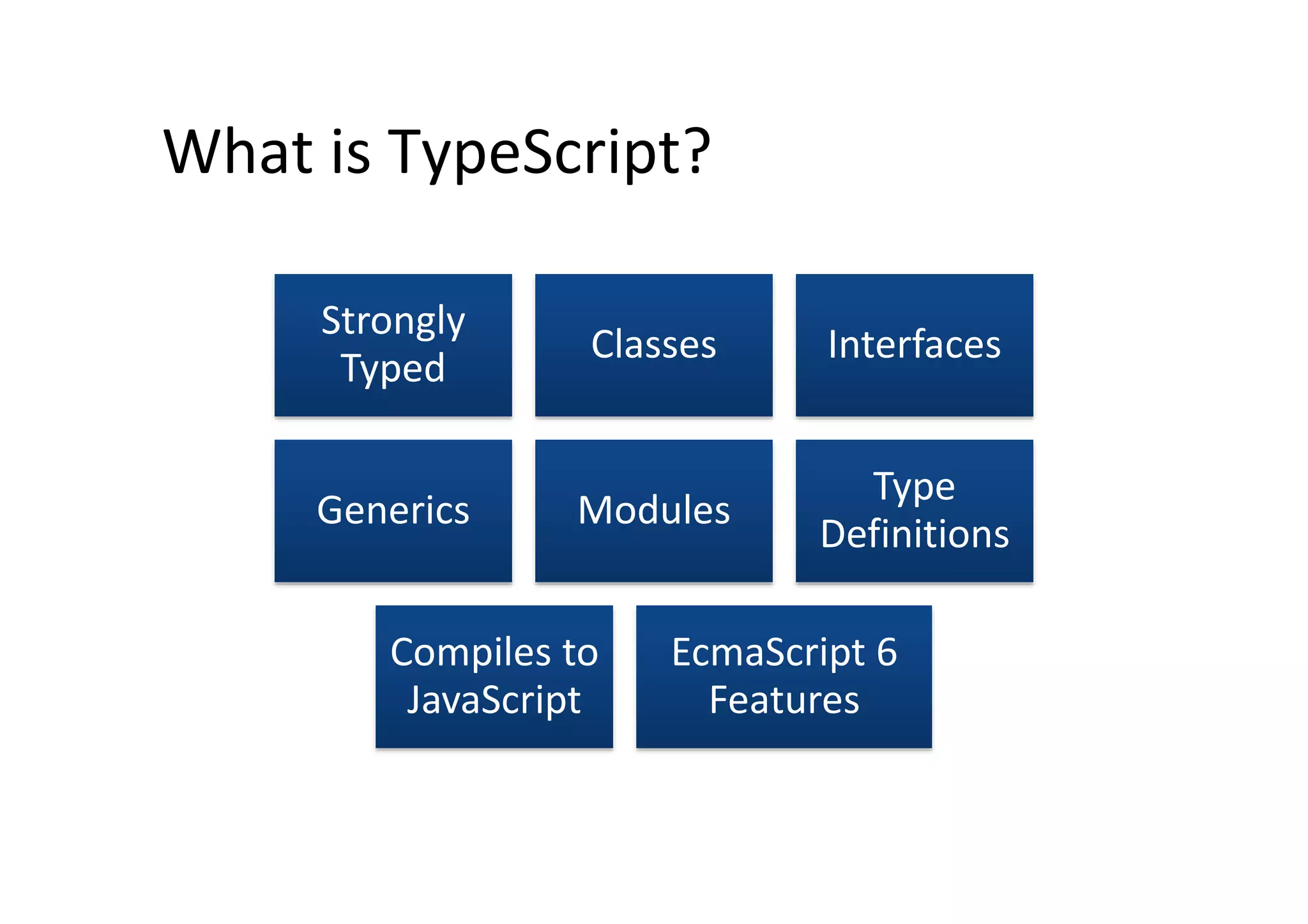The document provides a comprehensive overview of web application development, highlighting key concepts such as front-end and back-end frameworks, the MVC architecture, and use of REST APIs. It discusses important front-end technologies like JavaScript, Angular, and React, and their roles in creating single-page applications (SPAs) with dynamic user experiences. Additionally, it covers essential features of Angular and other frameworks, including directives, data binding, and the significance of modular architecture in web applications.
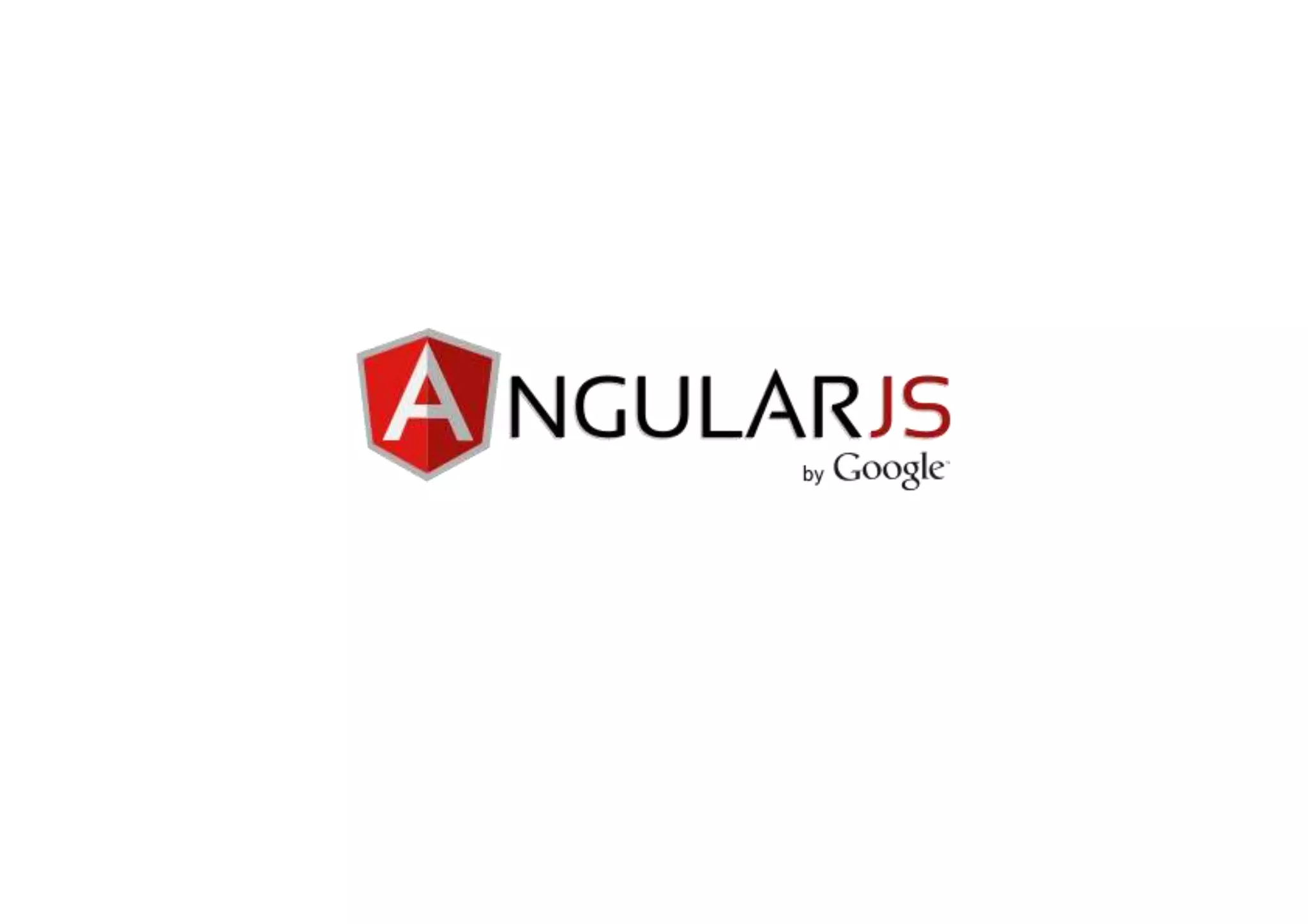

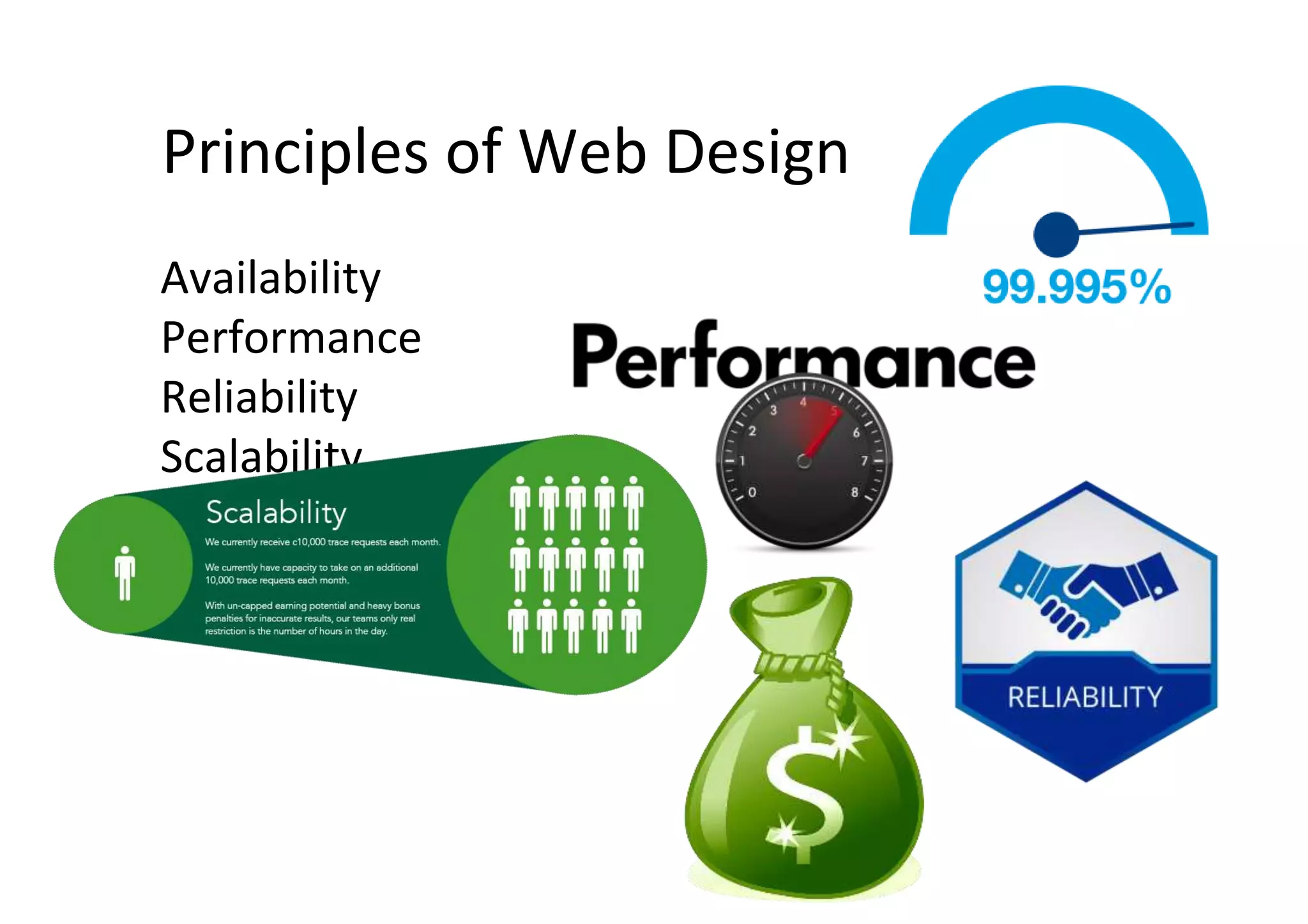
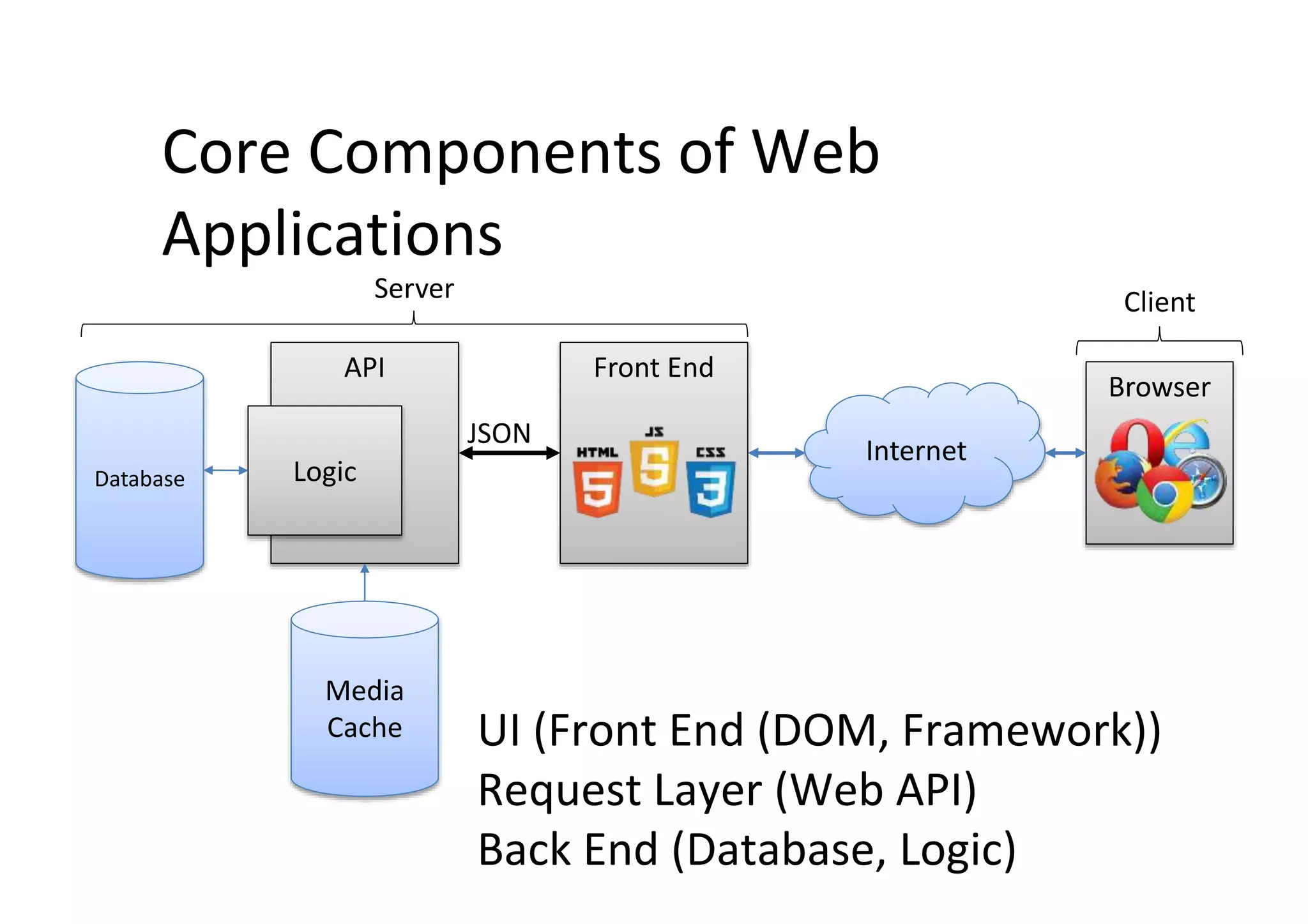

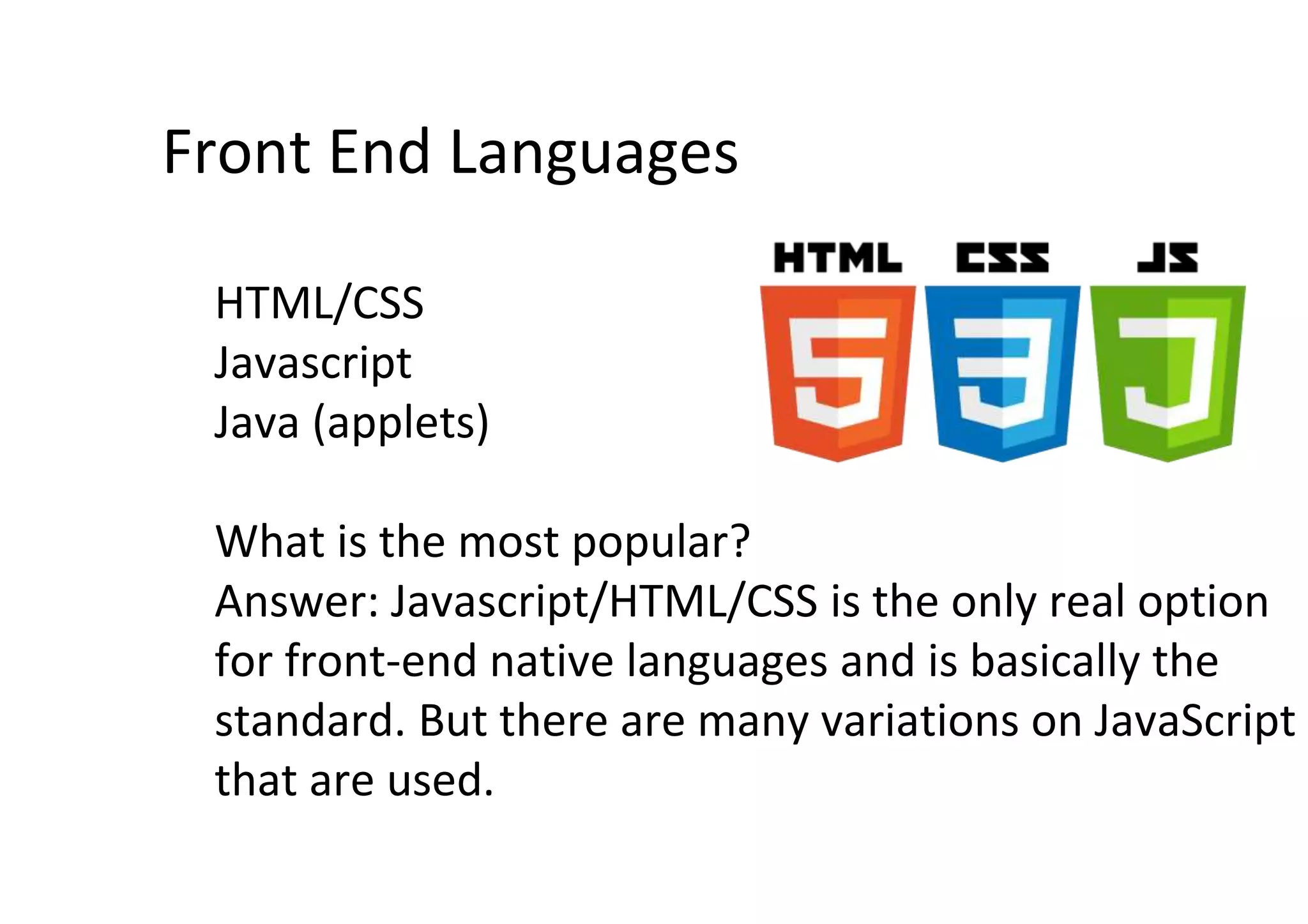

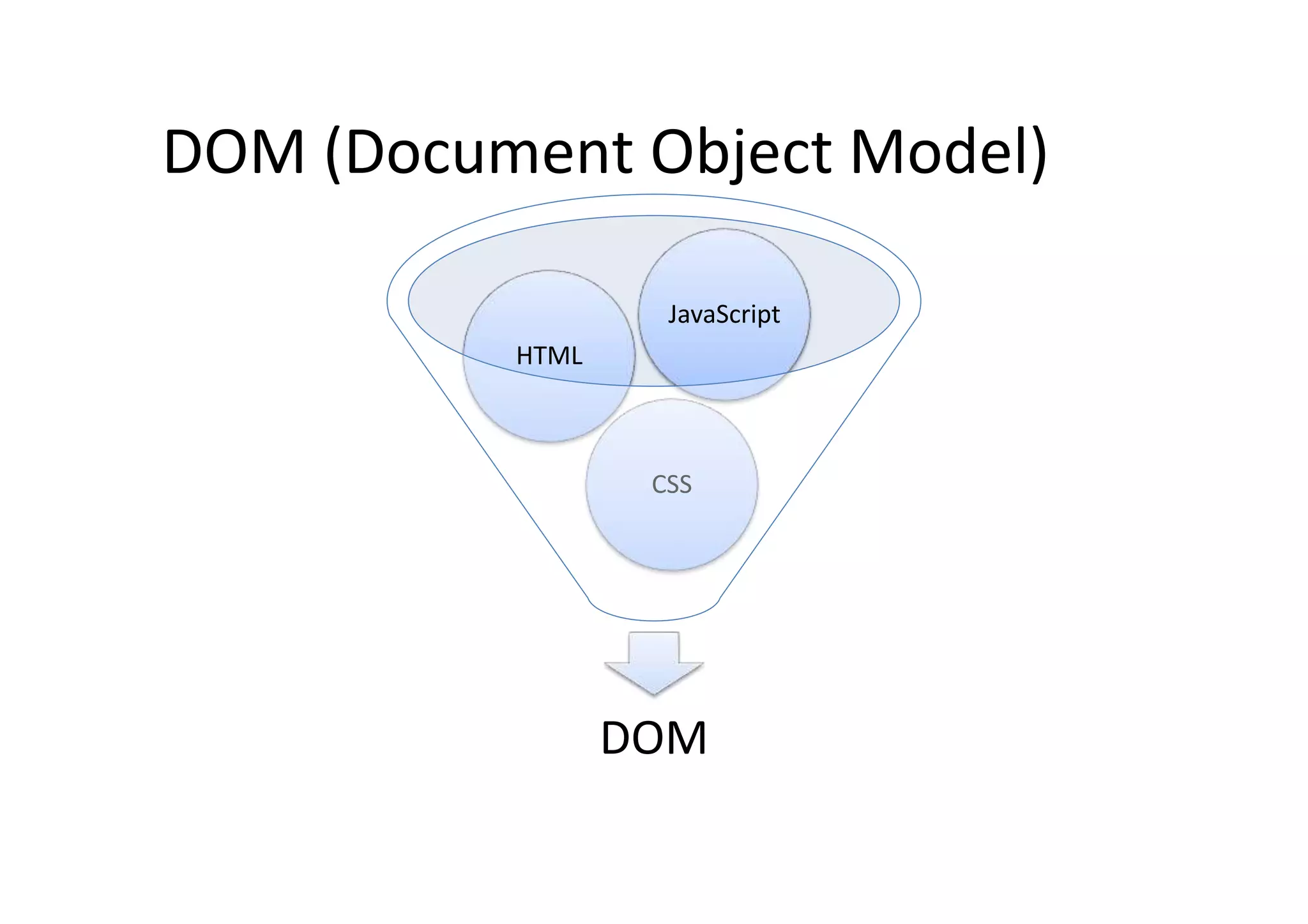
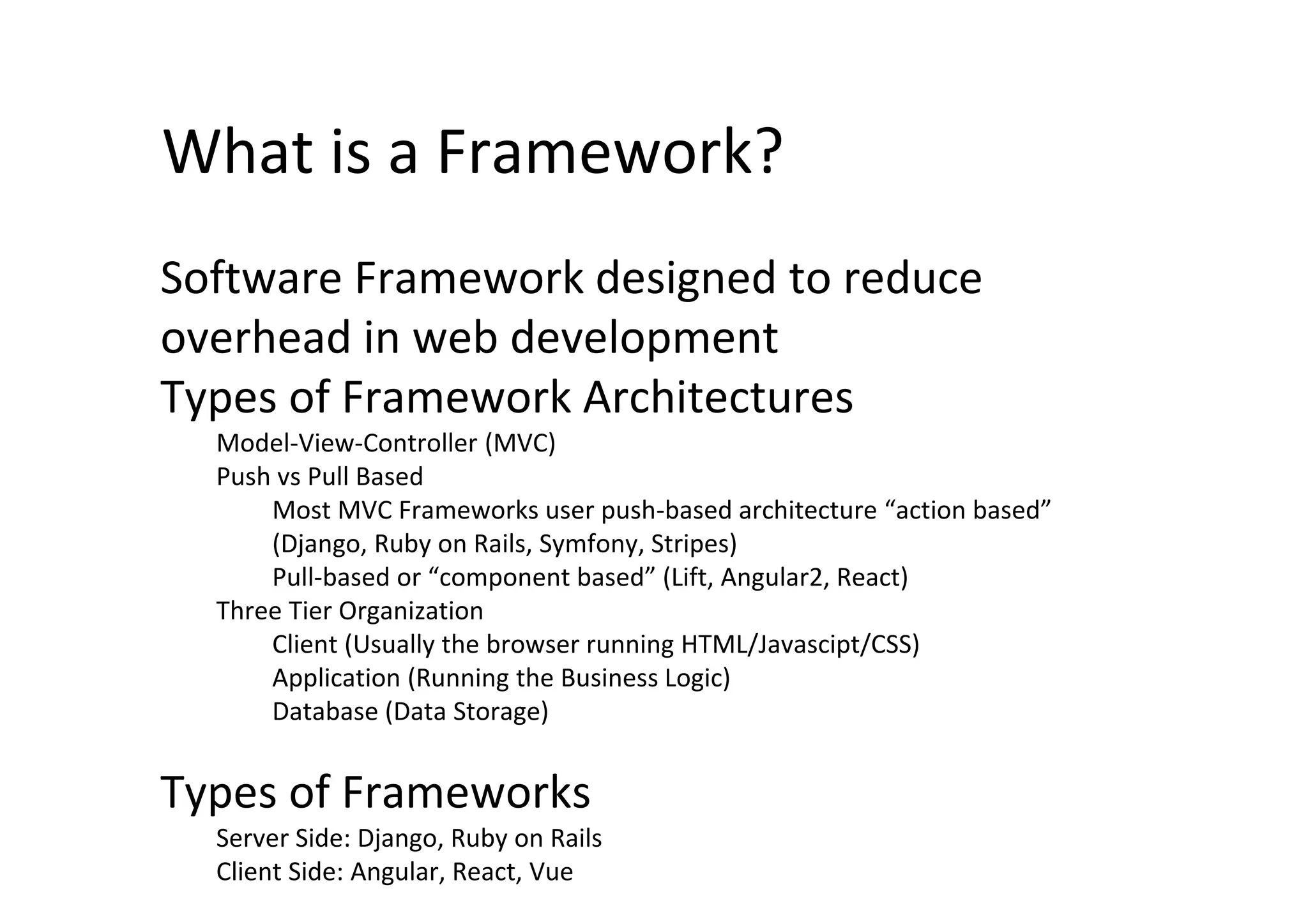
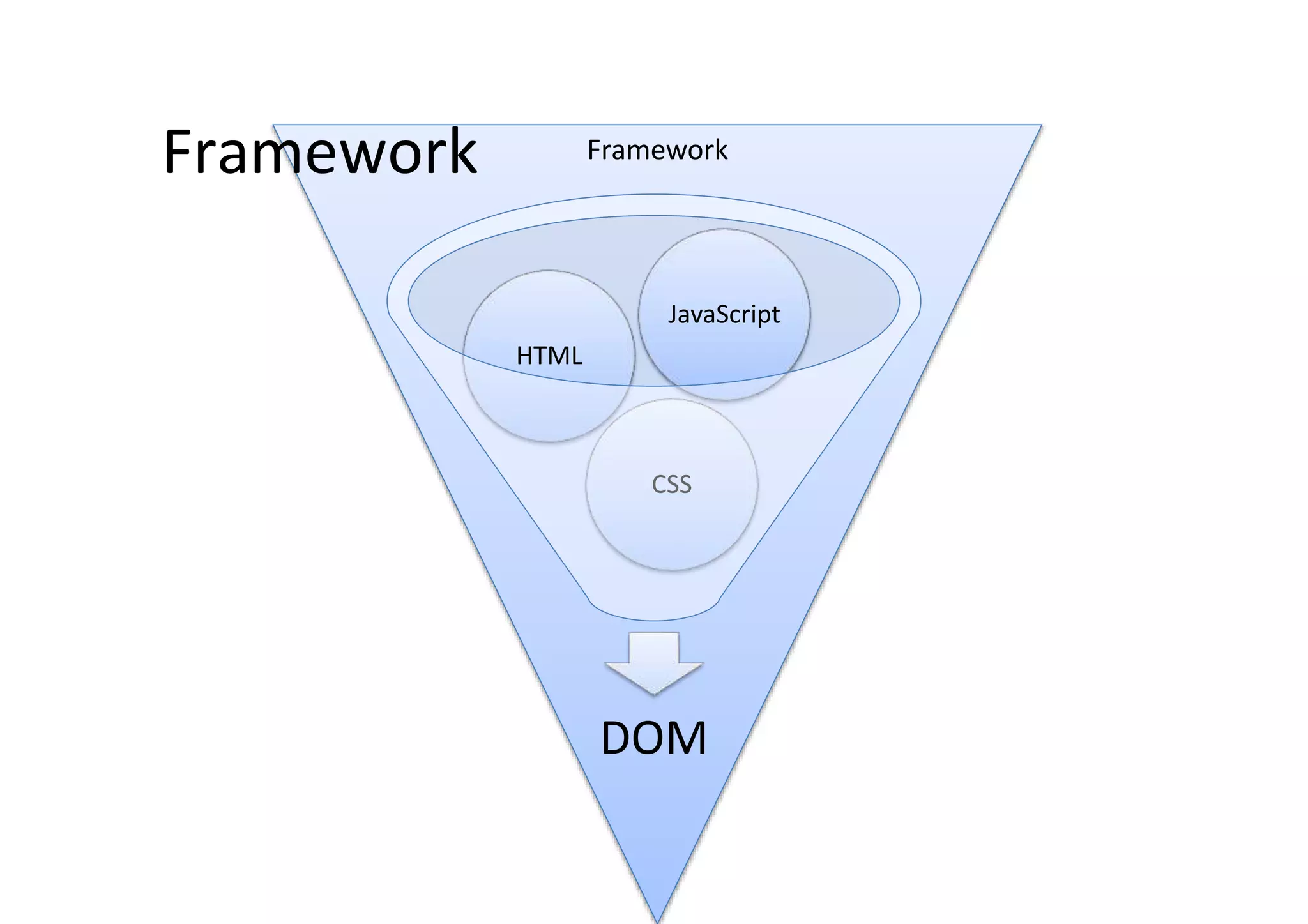
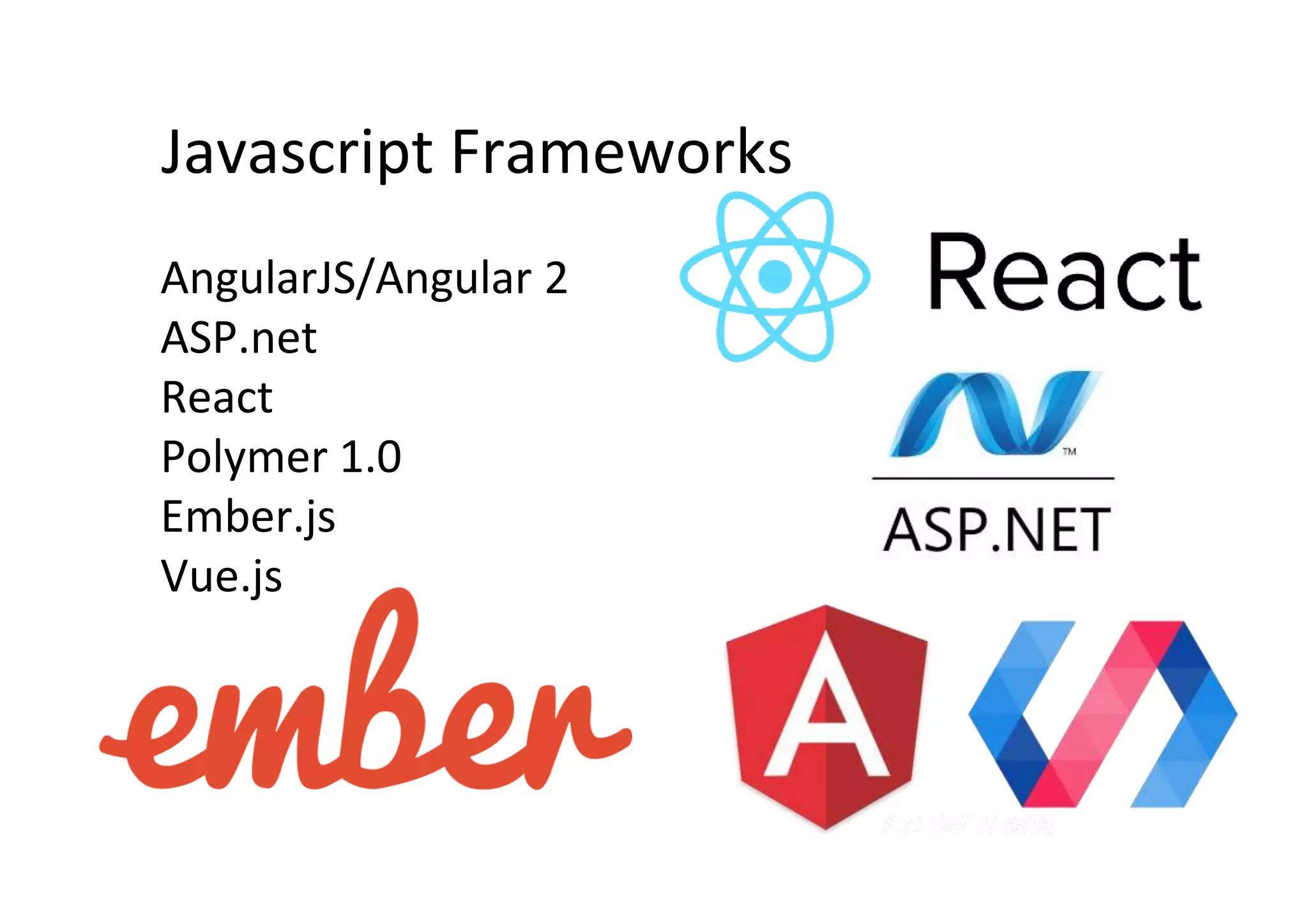

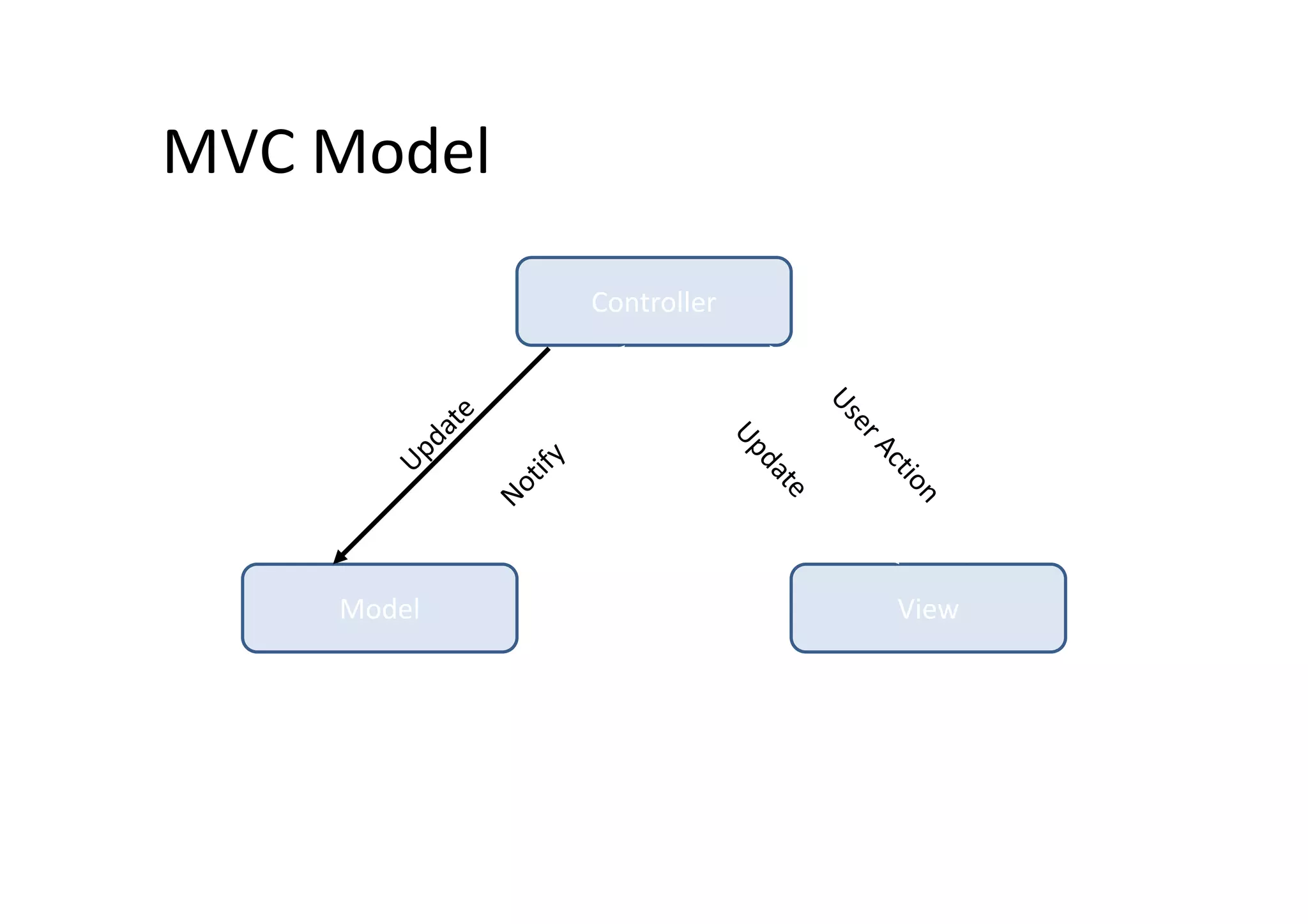
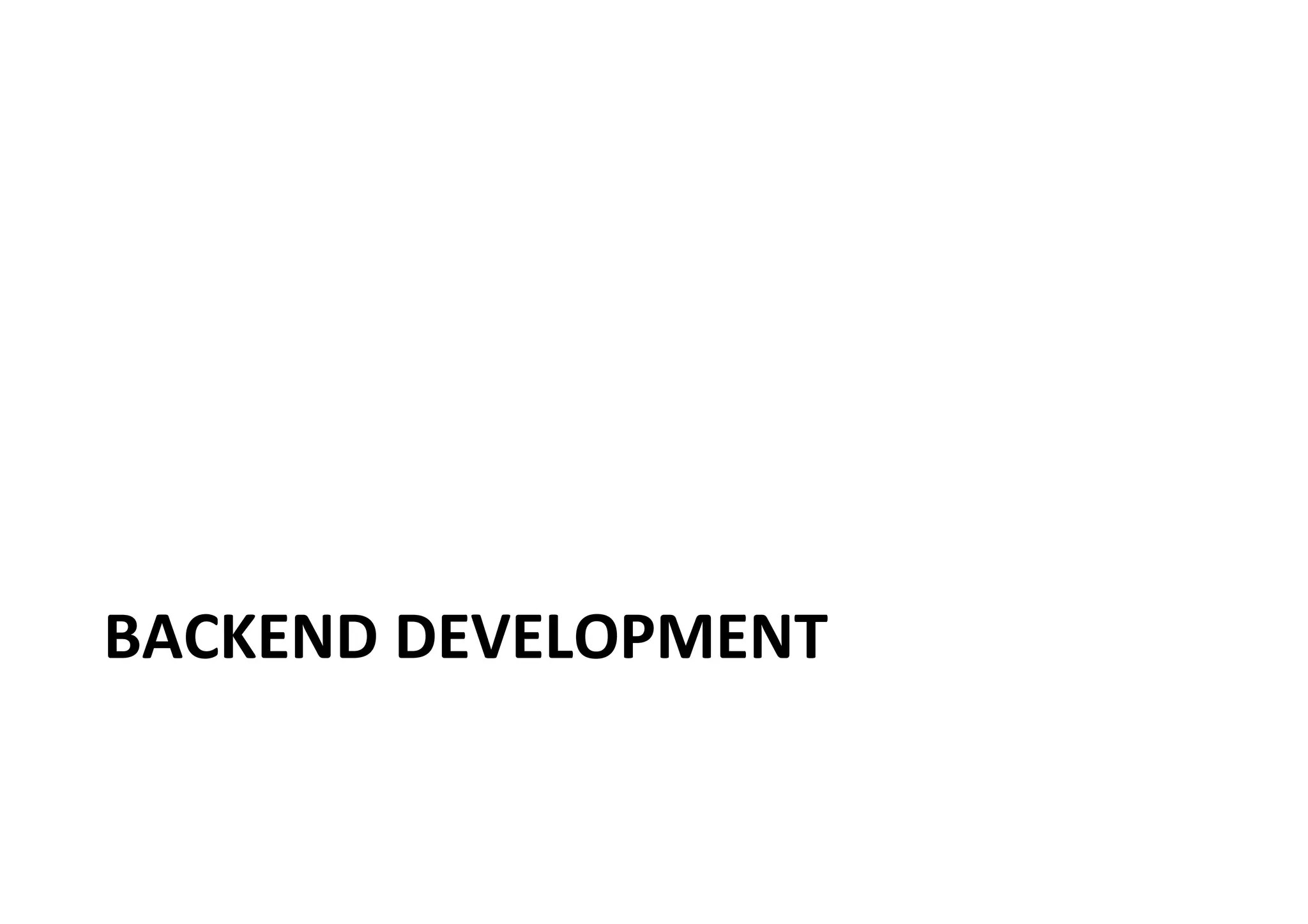
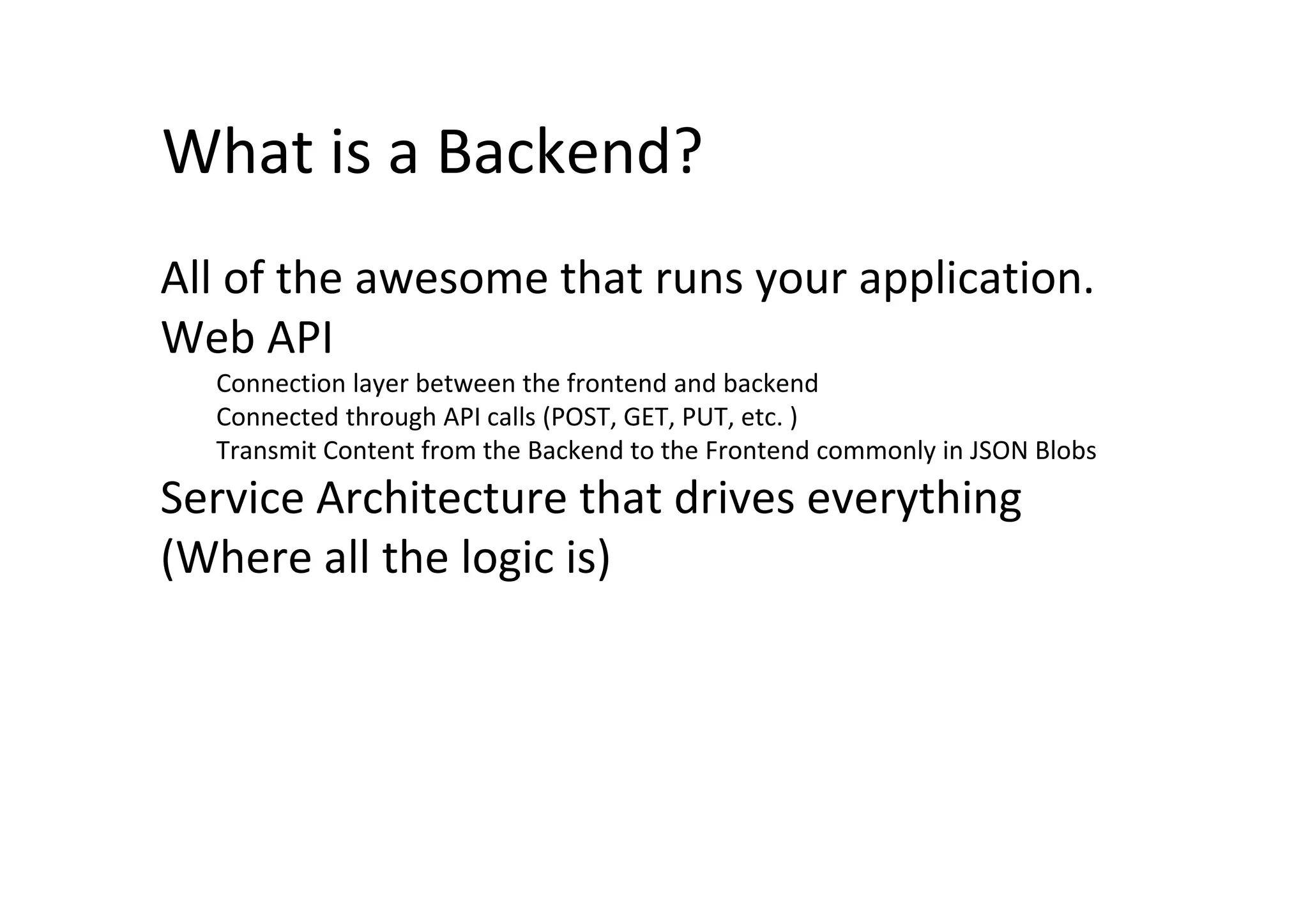

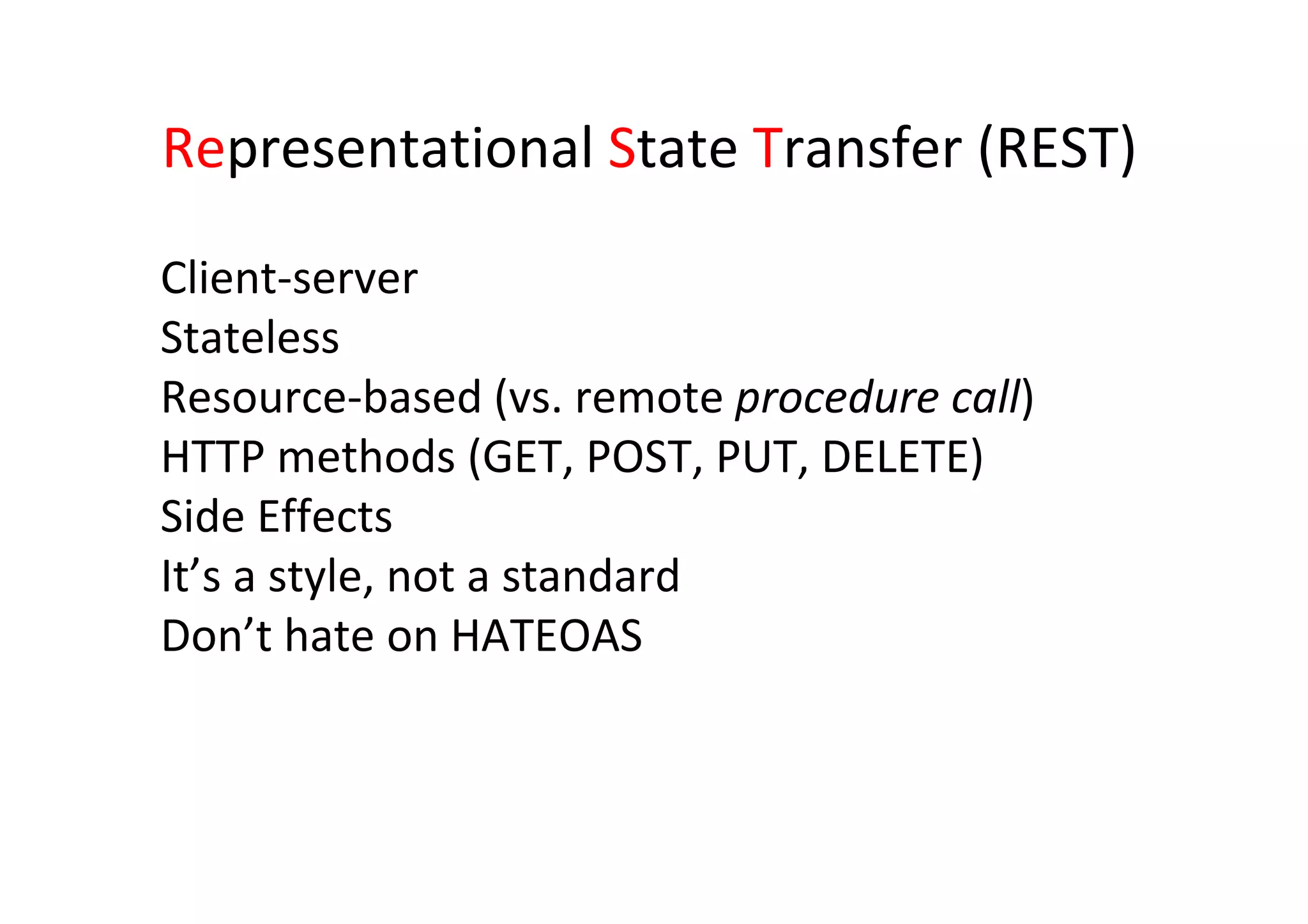
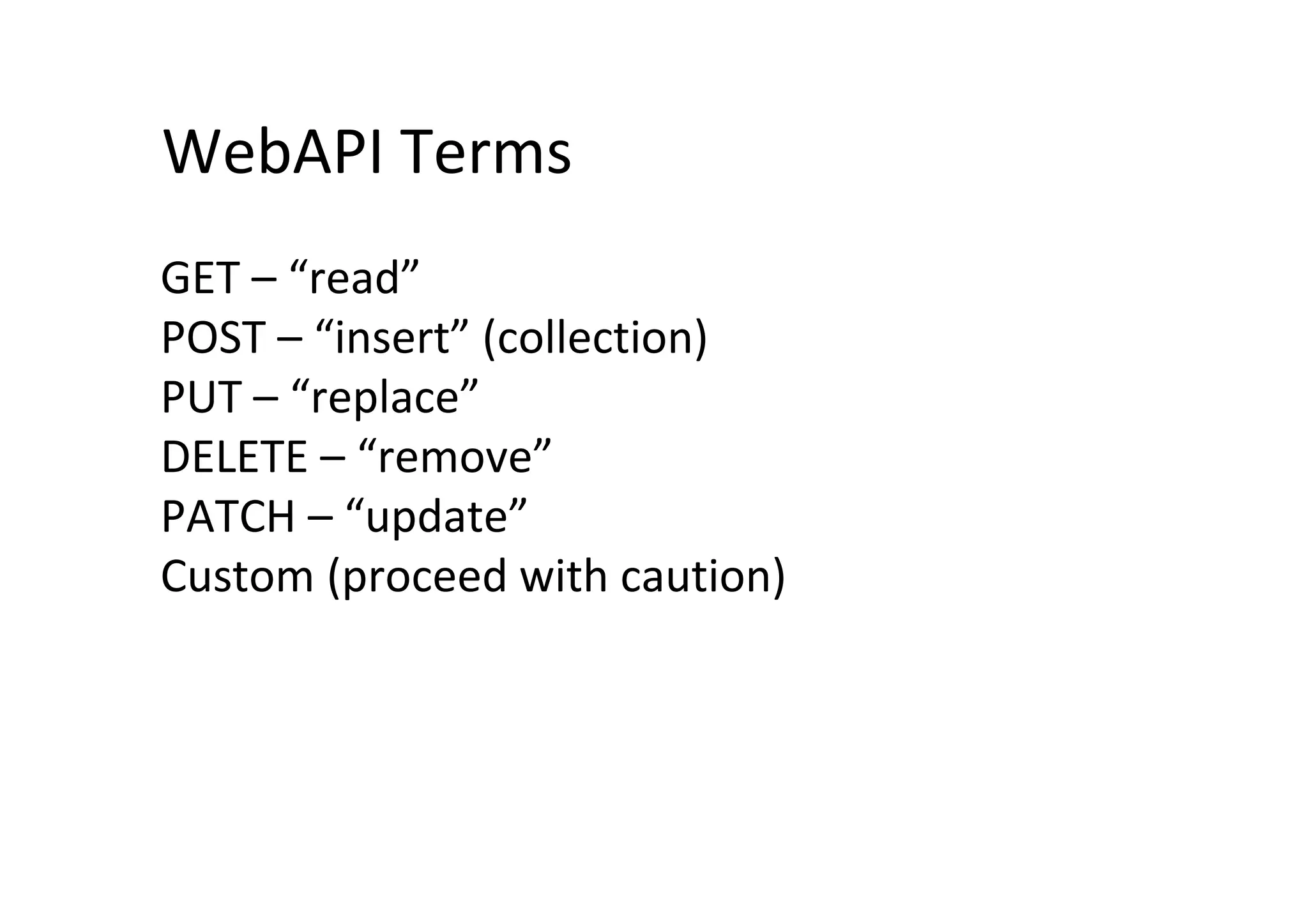




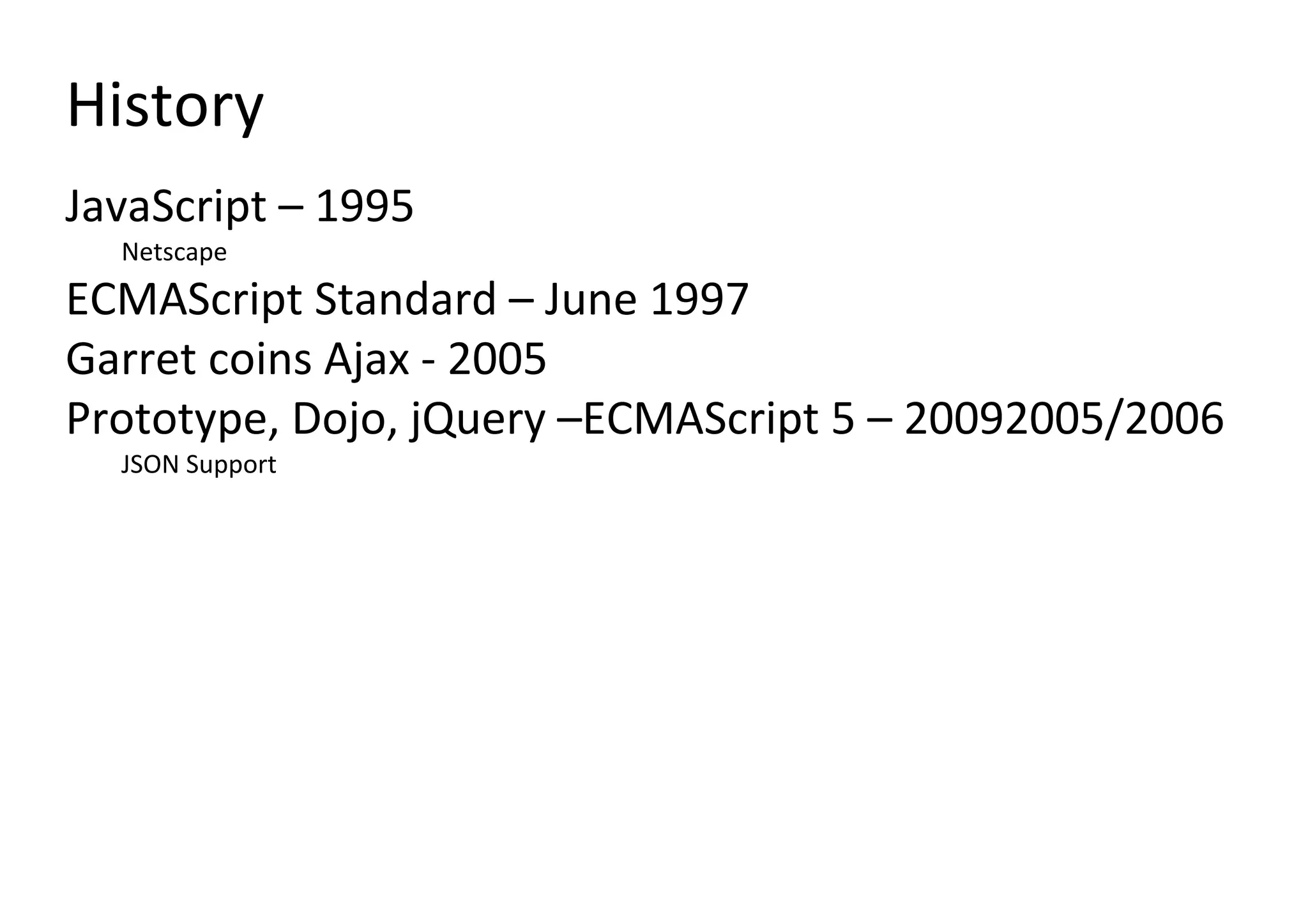
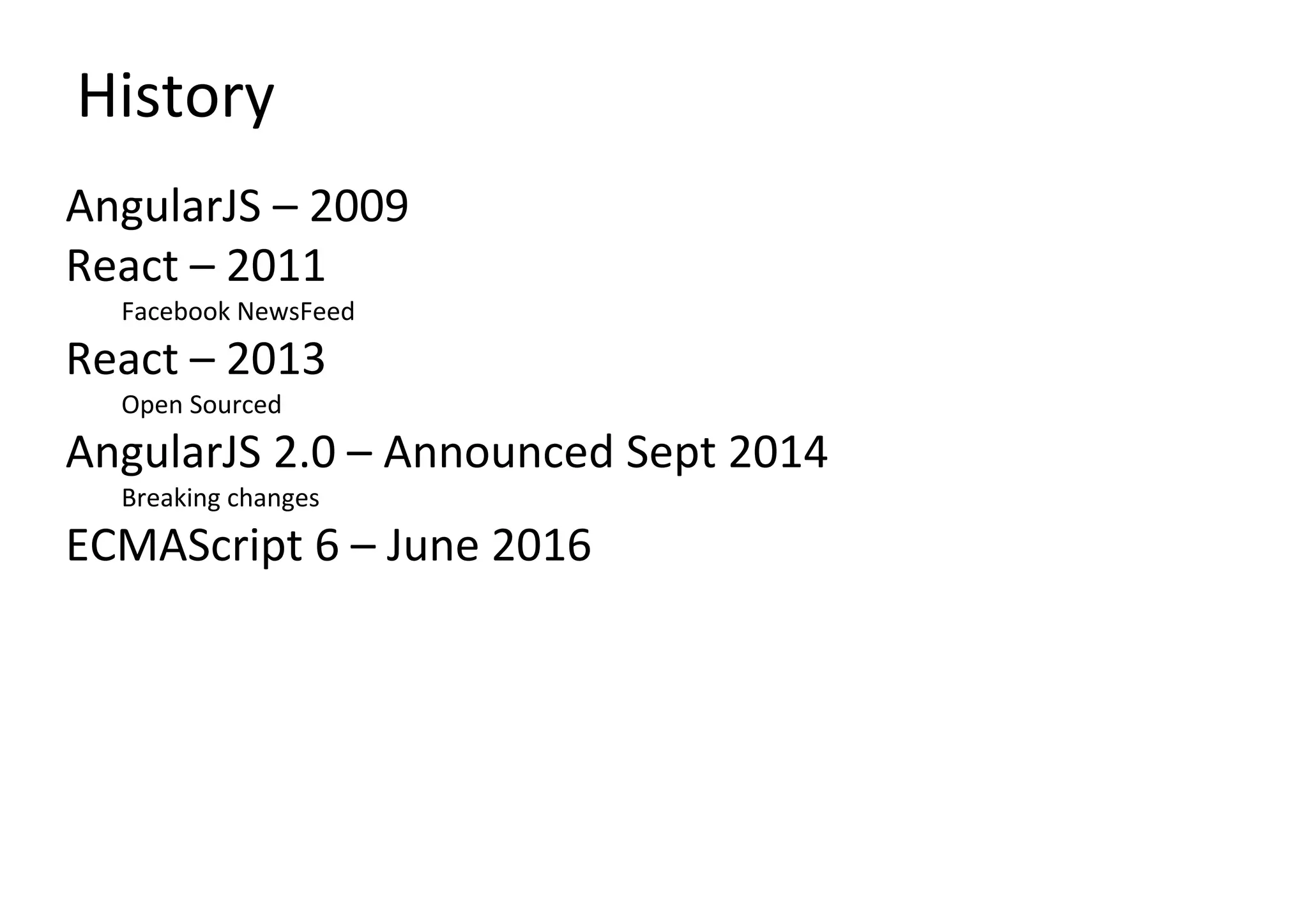
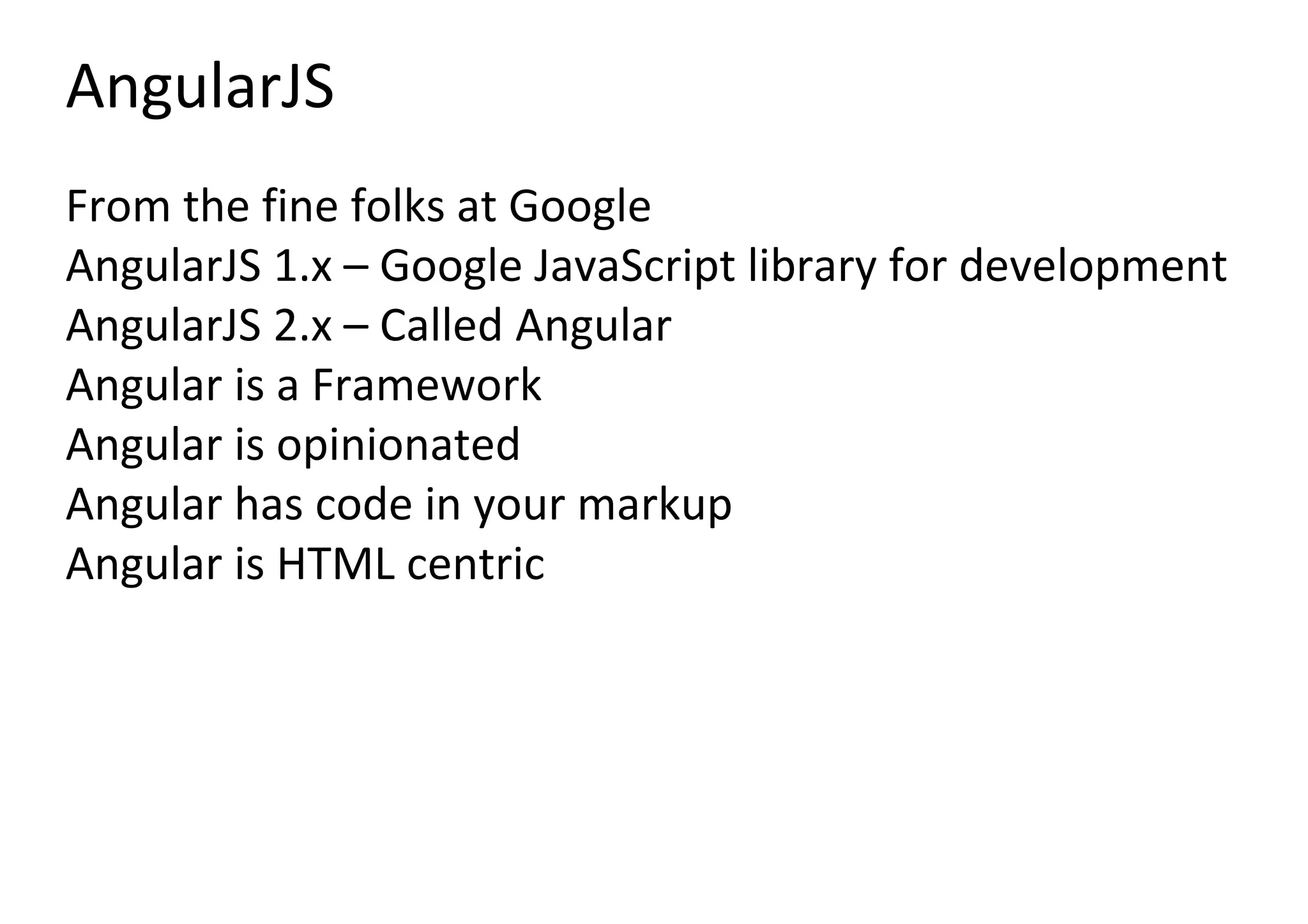
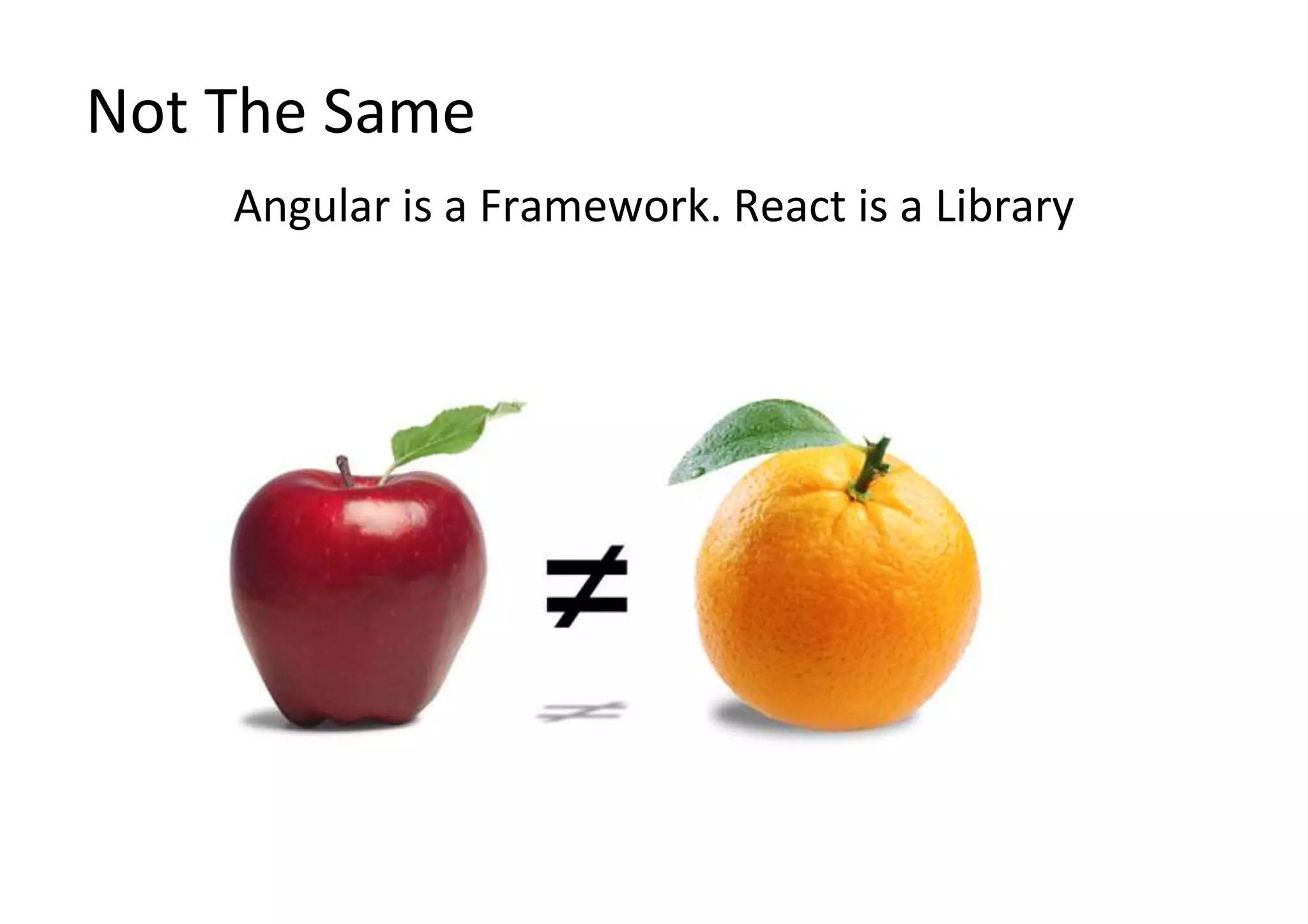
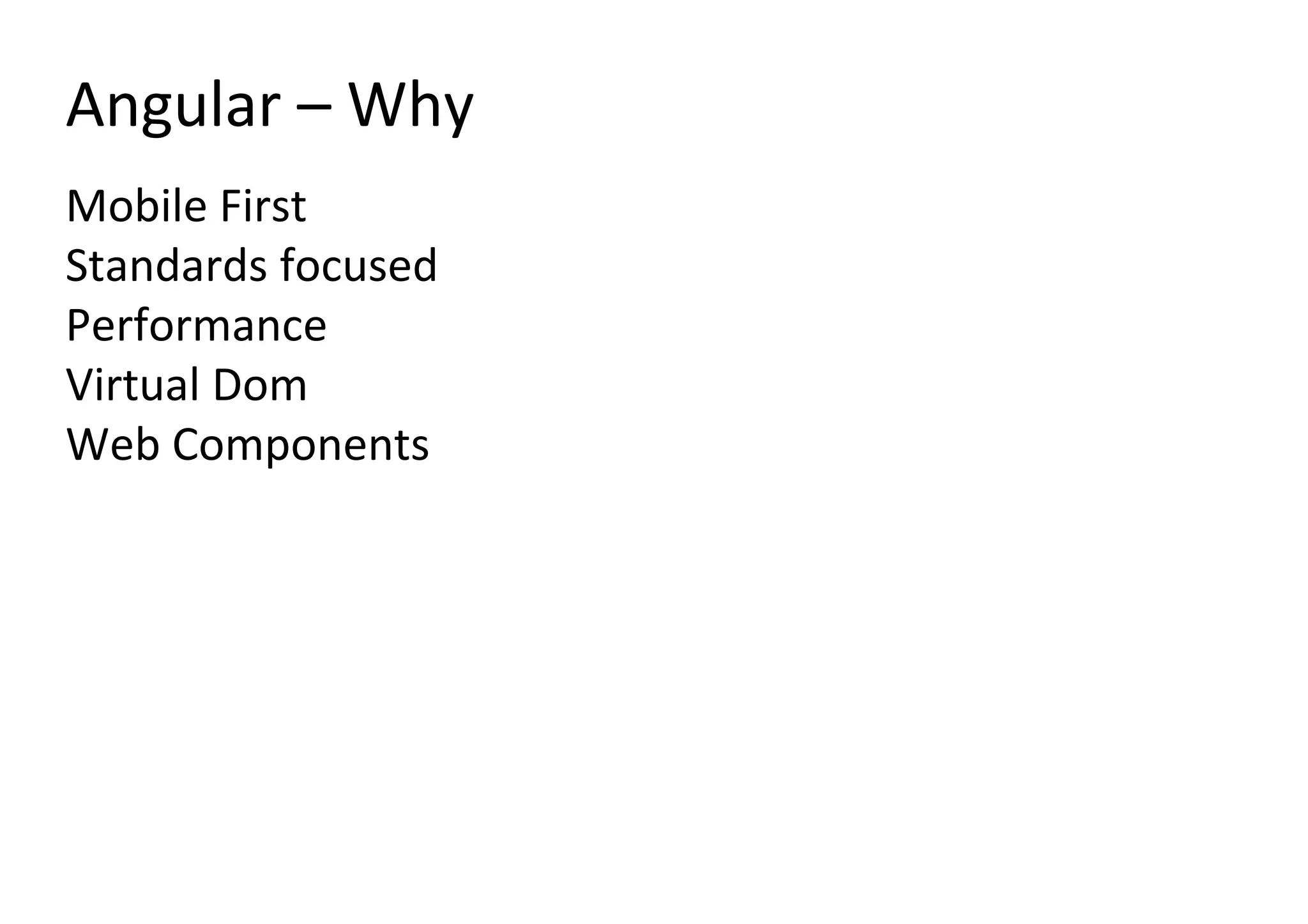
![import { Component } from 'angular2/core'; @Component({ selector: 'foo-Div', templateUrl: 'app/foo.html', styleUrls: [ 'app/foo.css' ] }) export class Foo { public message = 'Foo!'; } Component Angular](https://image.slidesharecdn.com/angularjs-intro-201215174146/75/Angular-jS-Introduction-by-Google-28-2048.jpg)
![Angular separate HTML file React HTML is in render method •JSX allows for HTML like Angular has one way and two way data binding •{{element.name}} •<input type="text" [(ngModel)]="inputFieldName" id="id1" /> React is stateless, no two way binding •This.state.inputFieldName Templates and Databinding](https://image.slidesharecdn.com/angularjs-intro-201215174146/75/Angular-jS-Introduction-by-Google-29-2048.jpg)
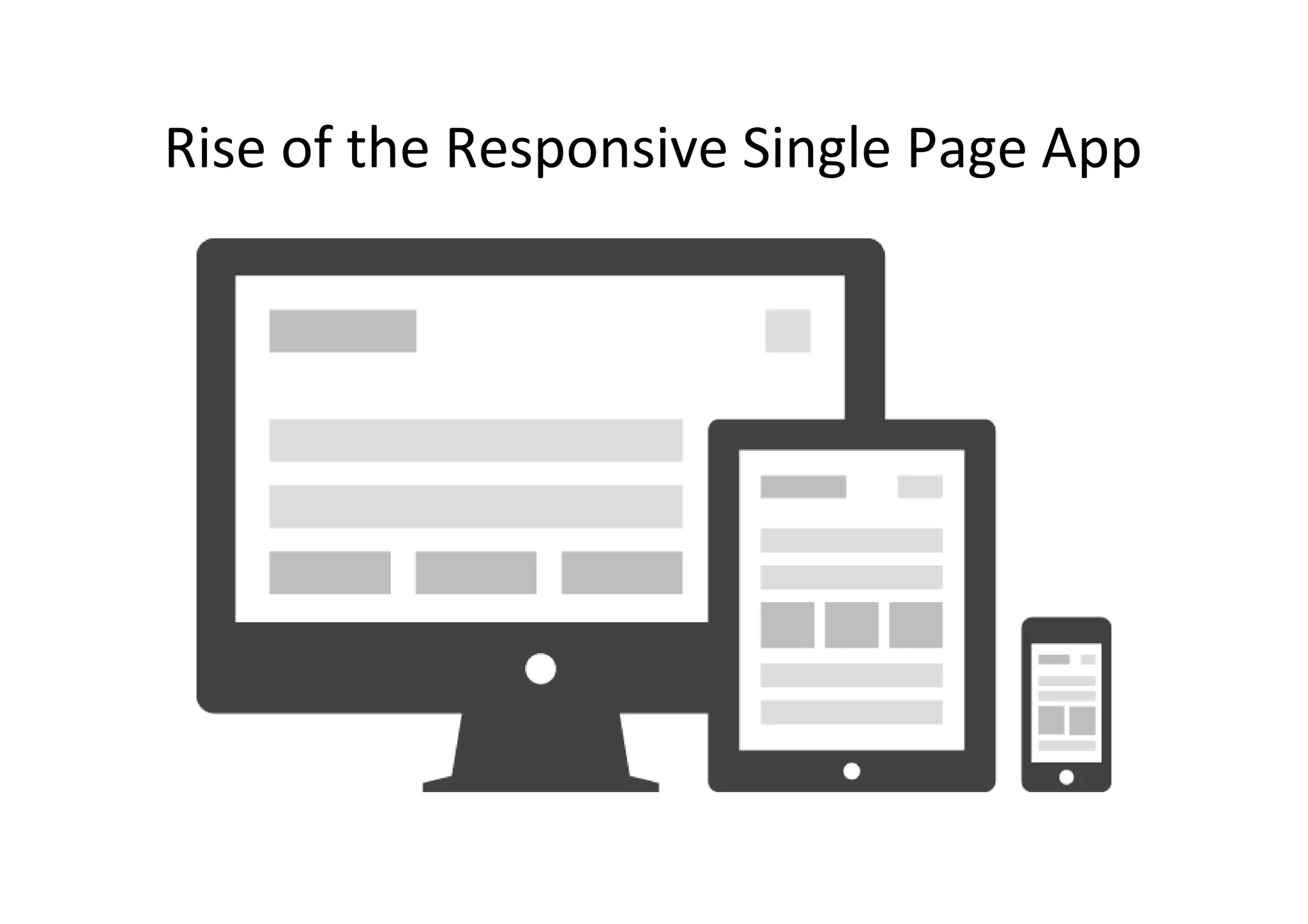
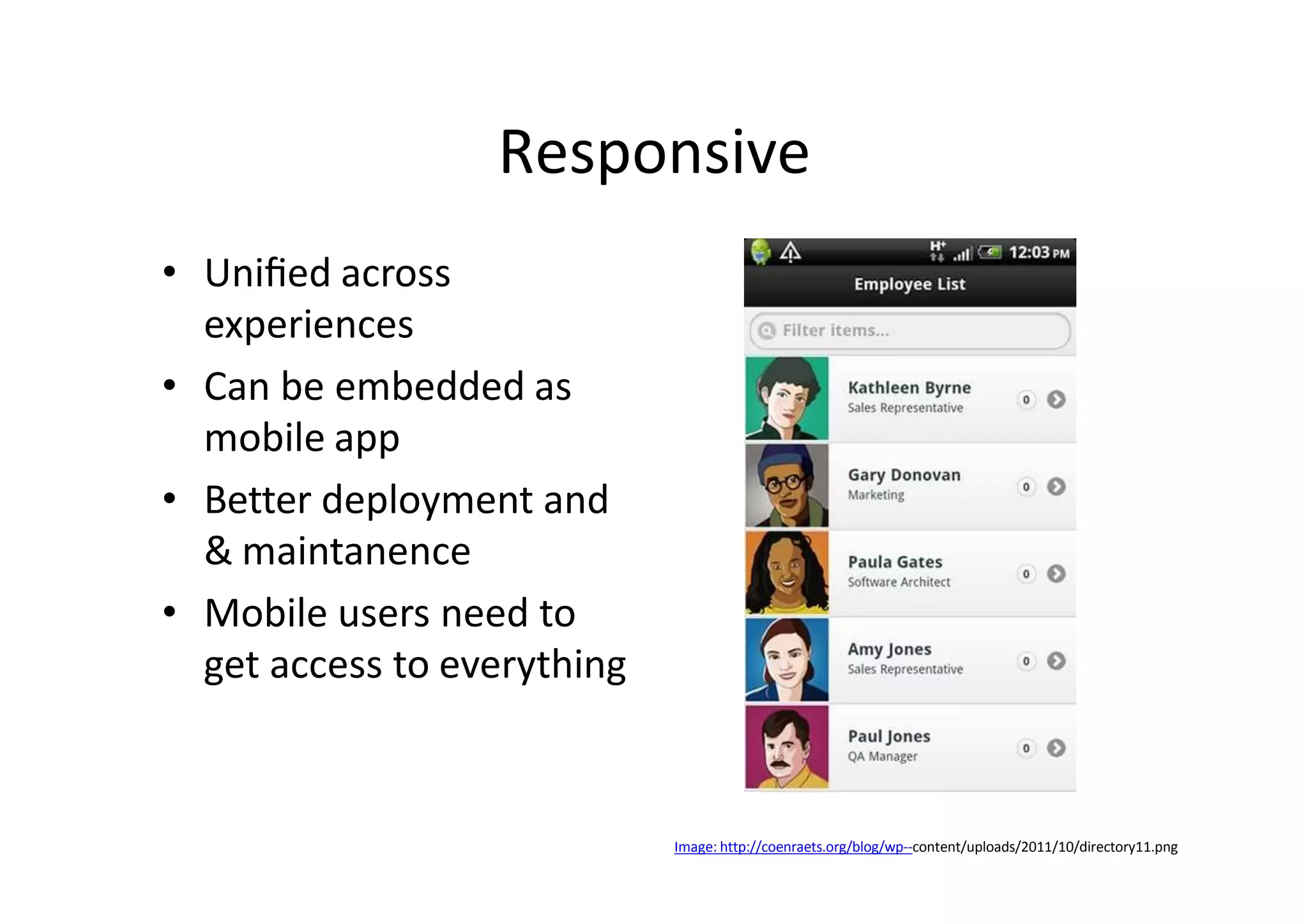
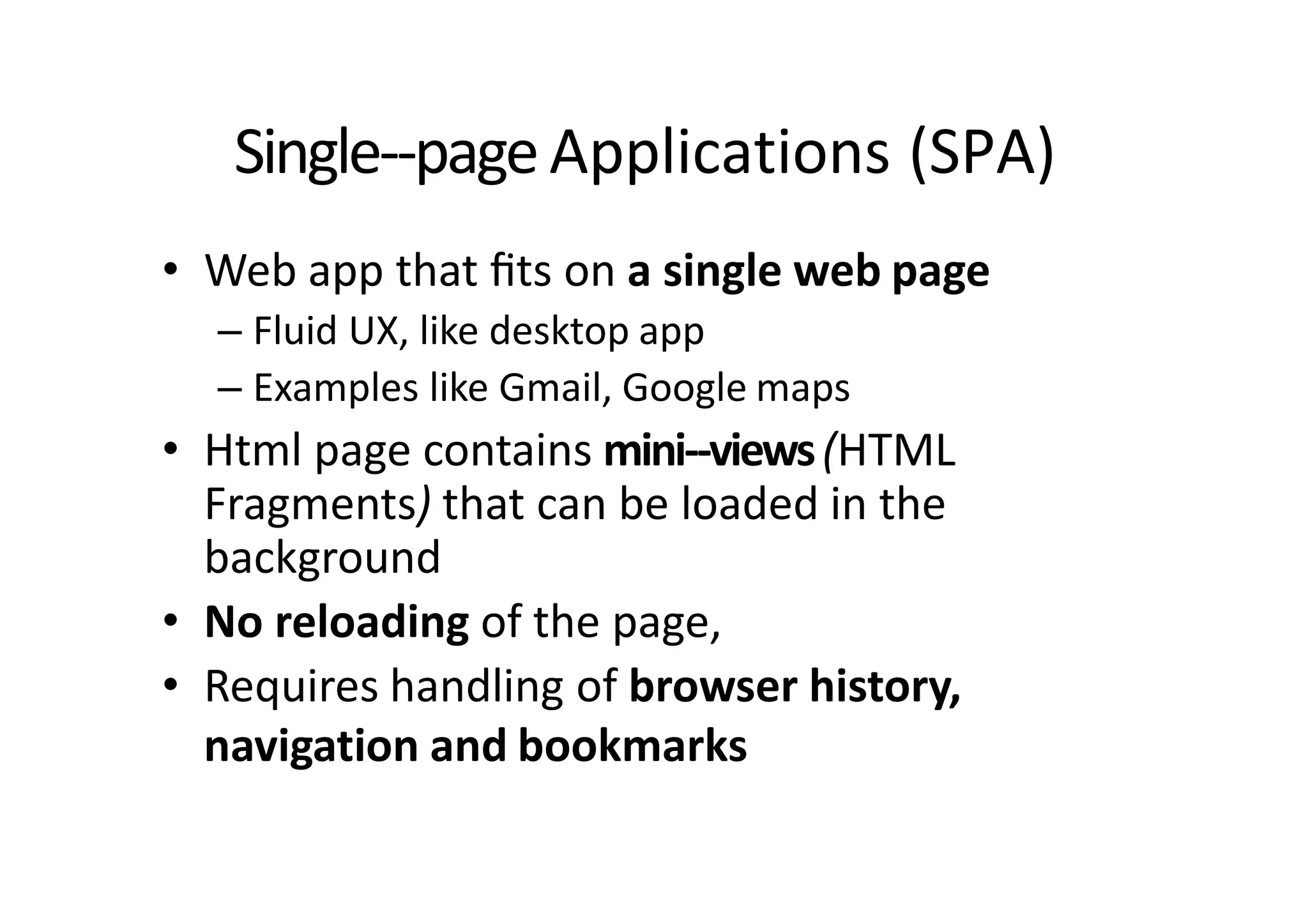

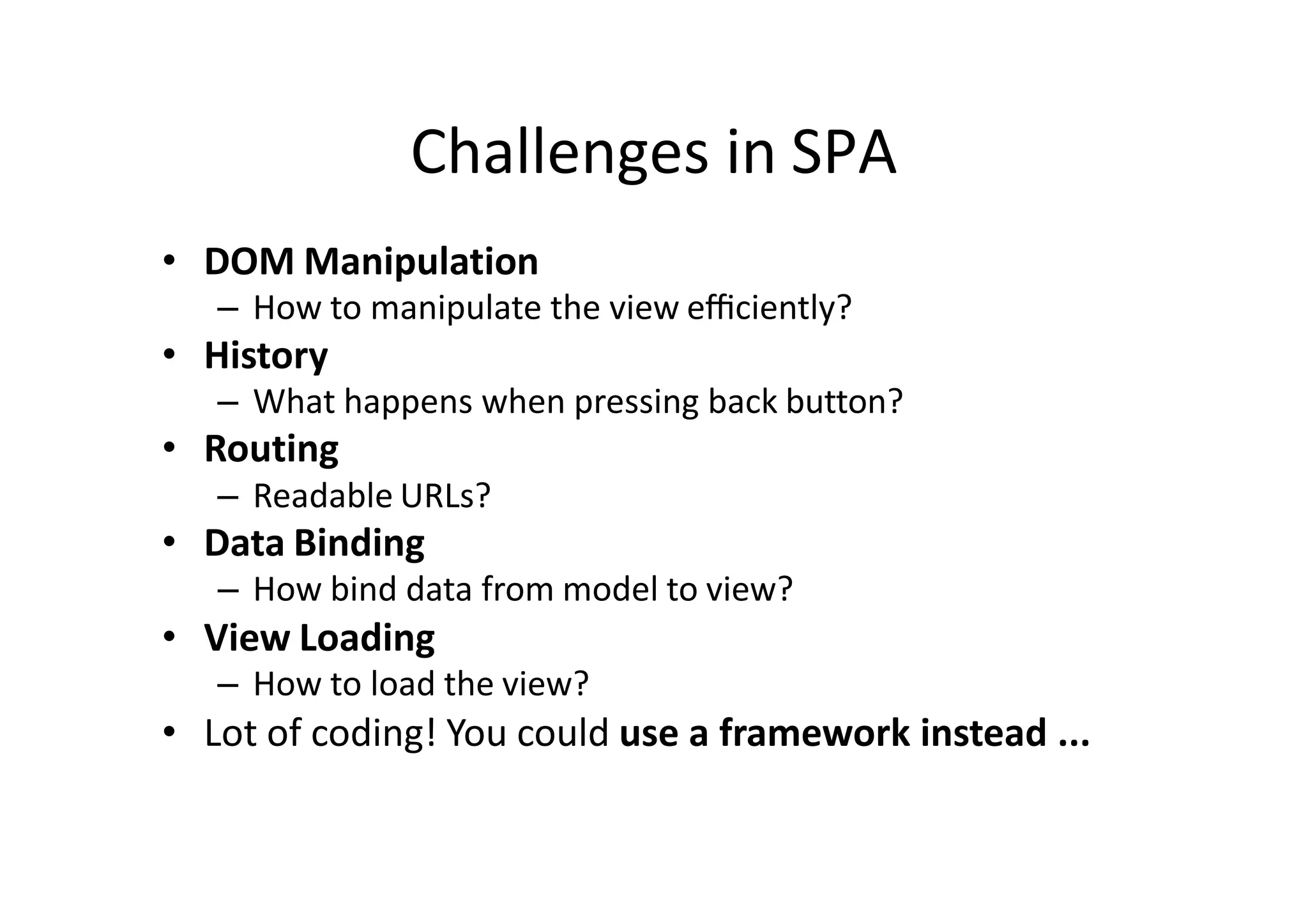
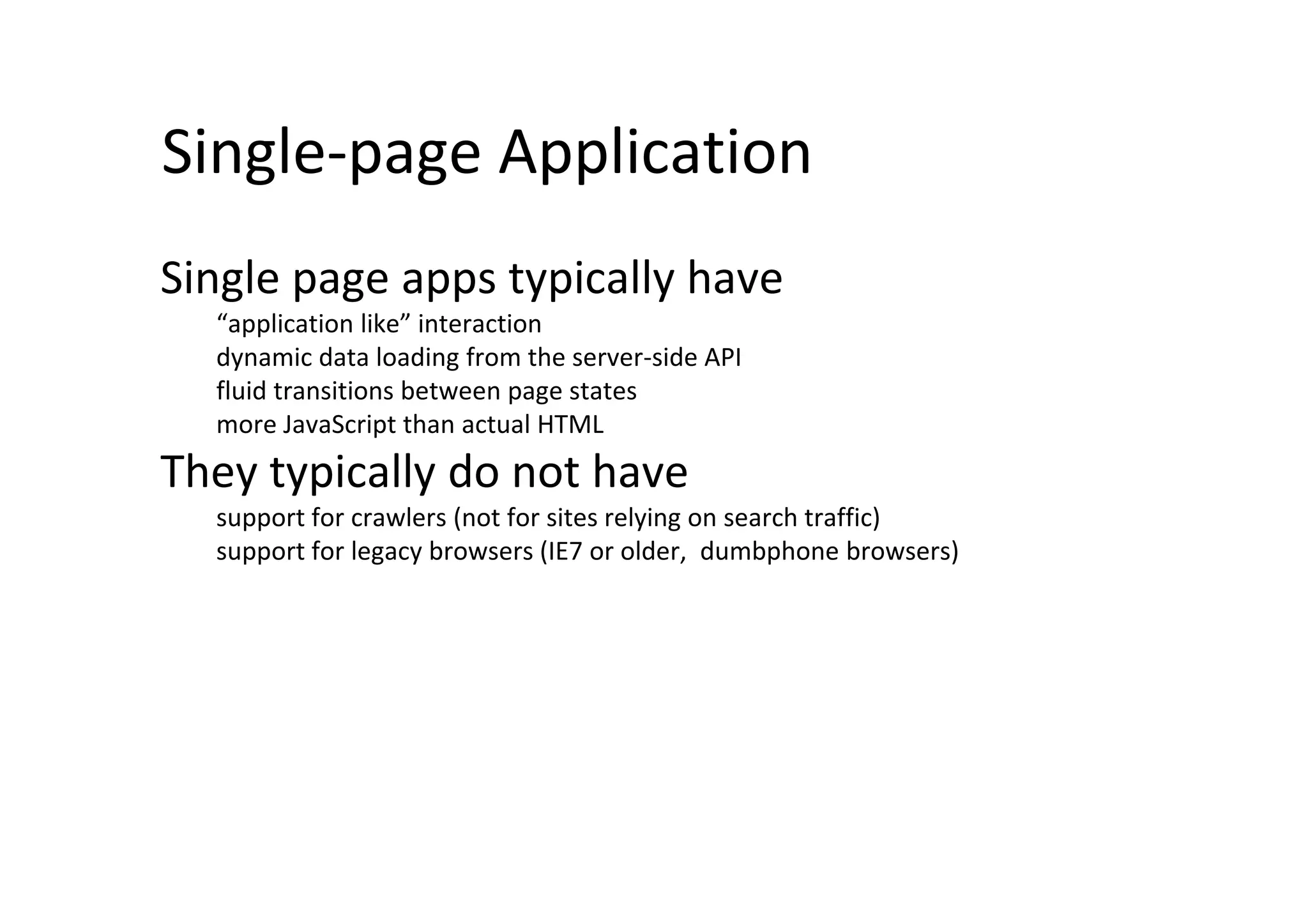

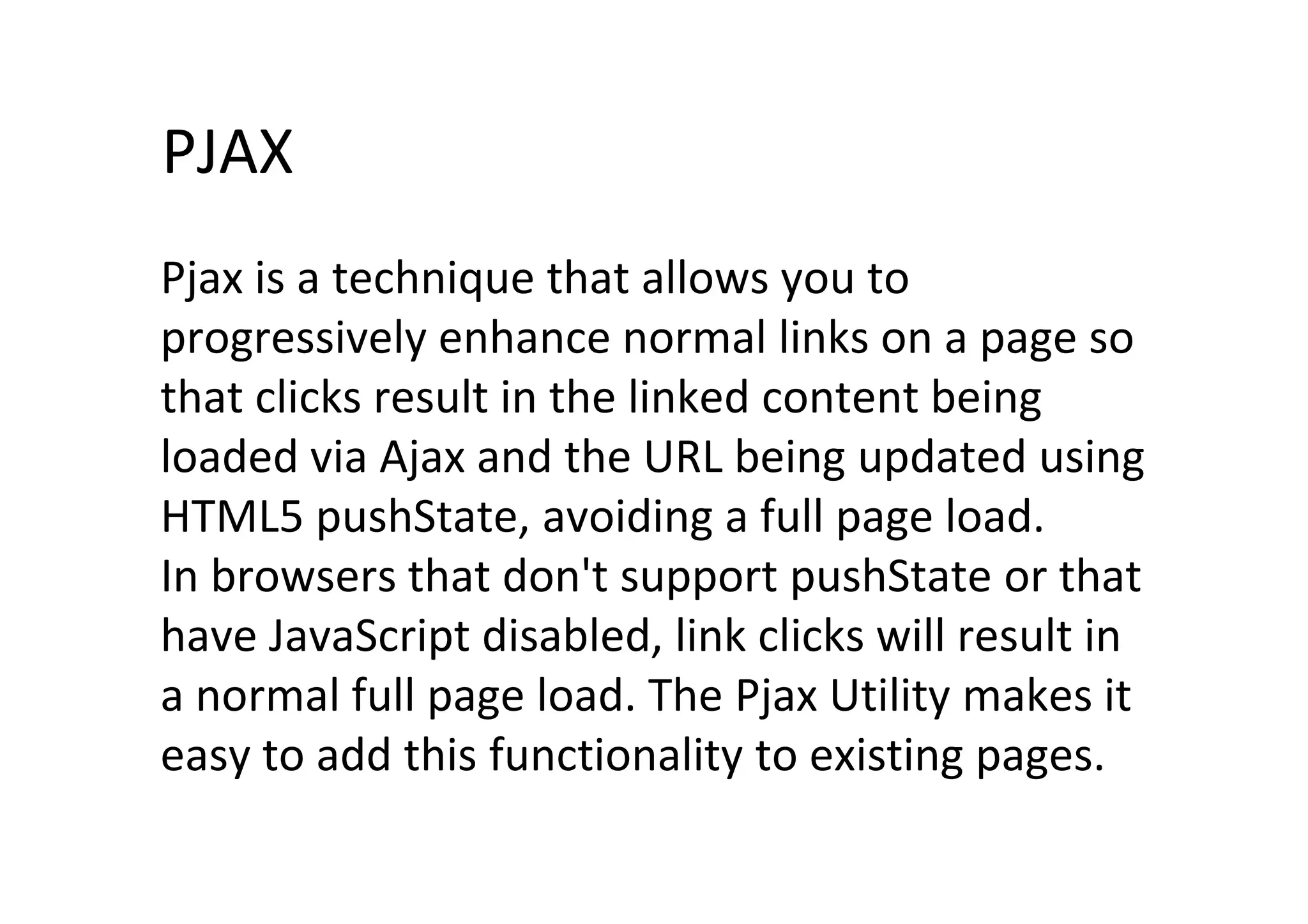
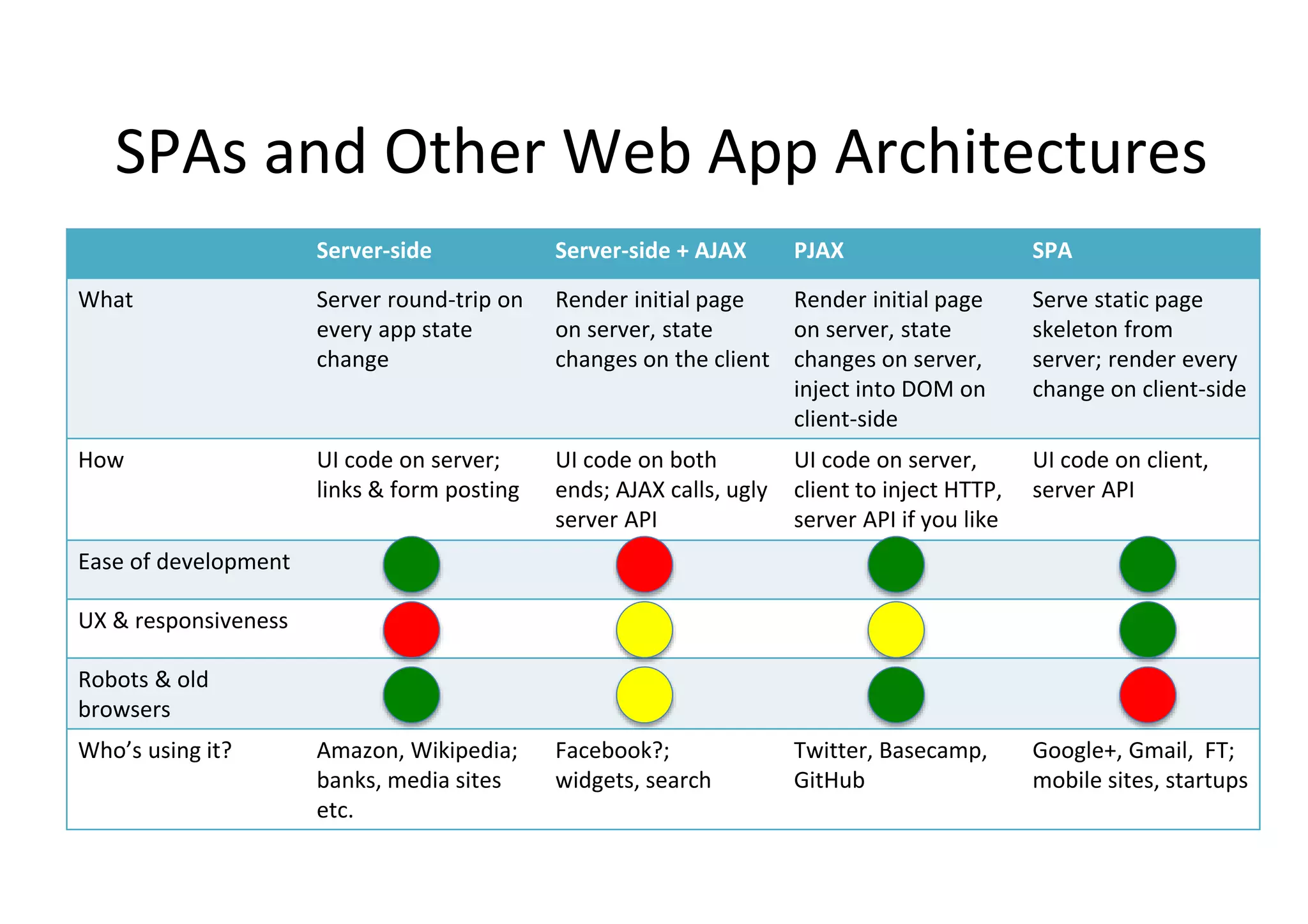
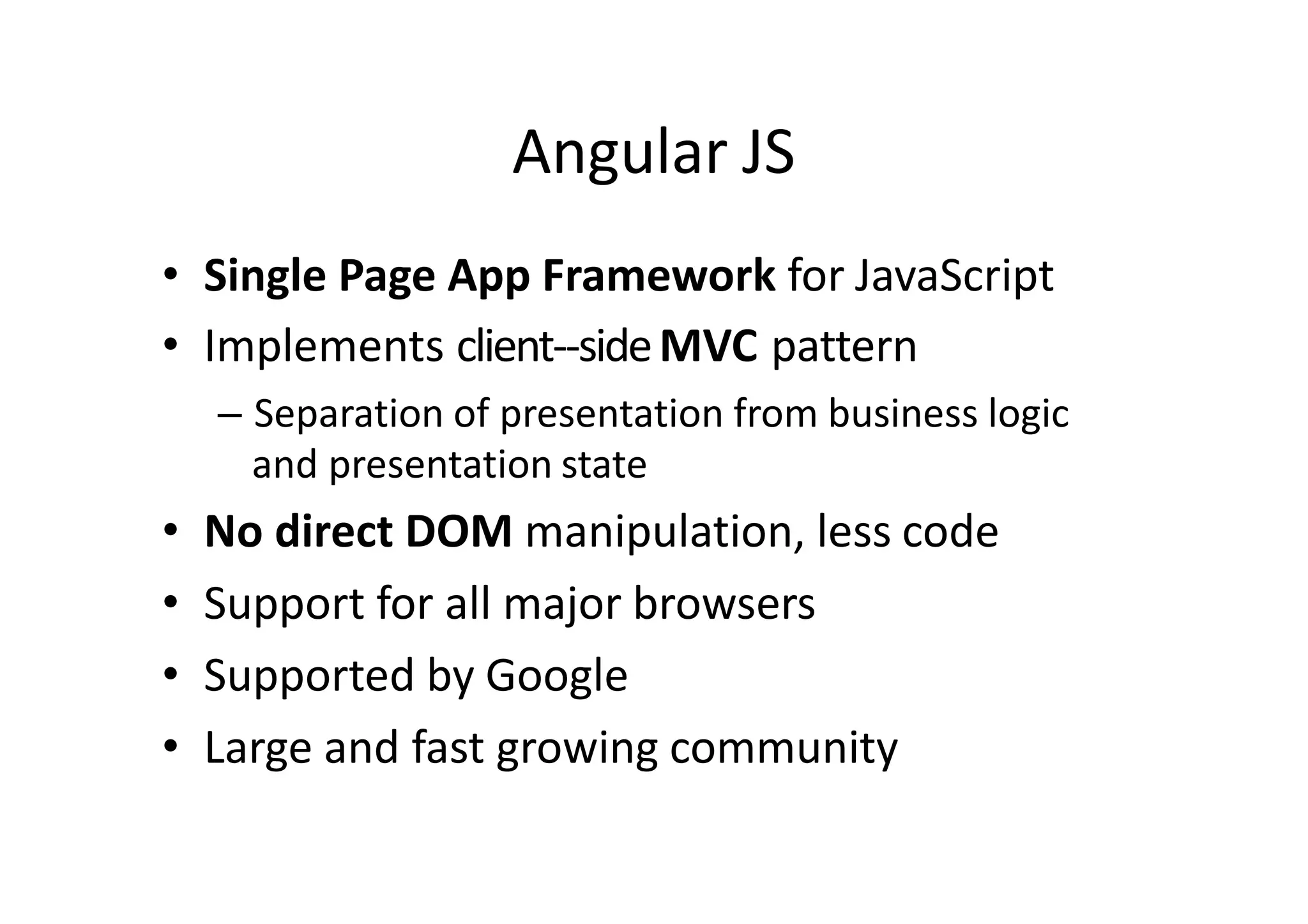
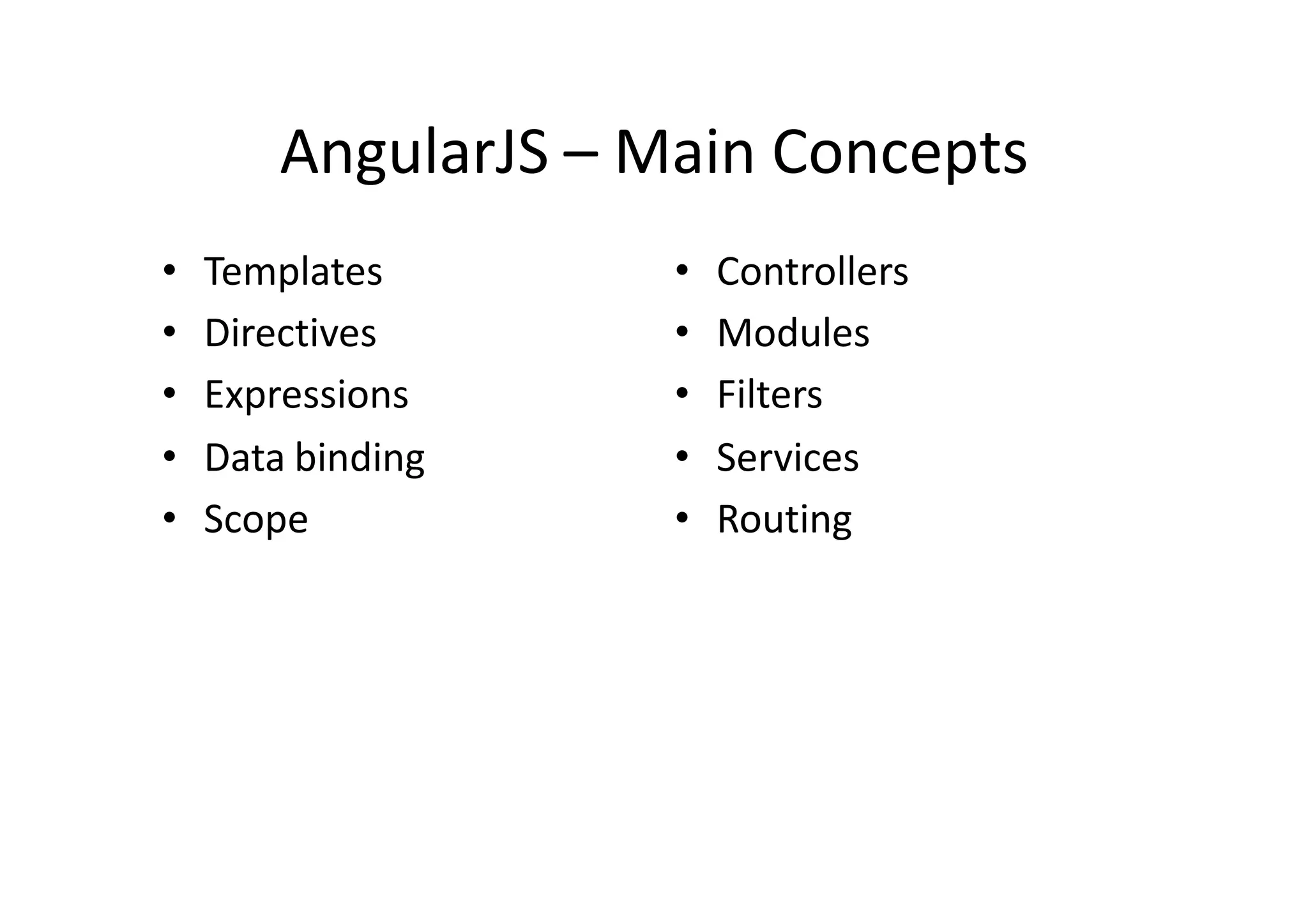

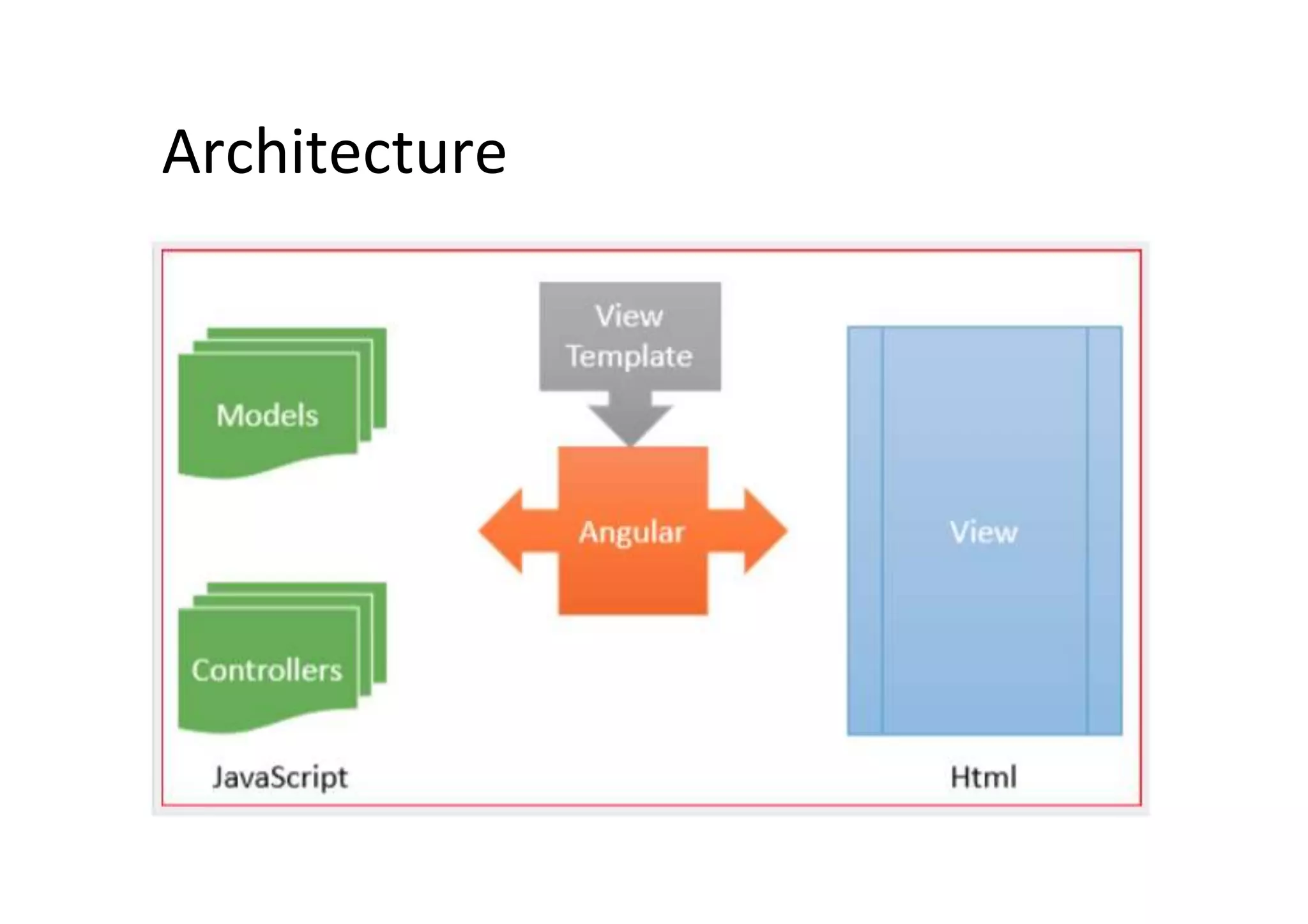
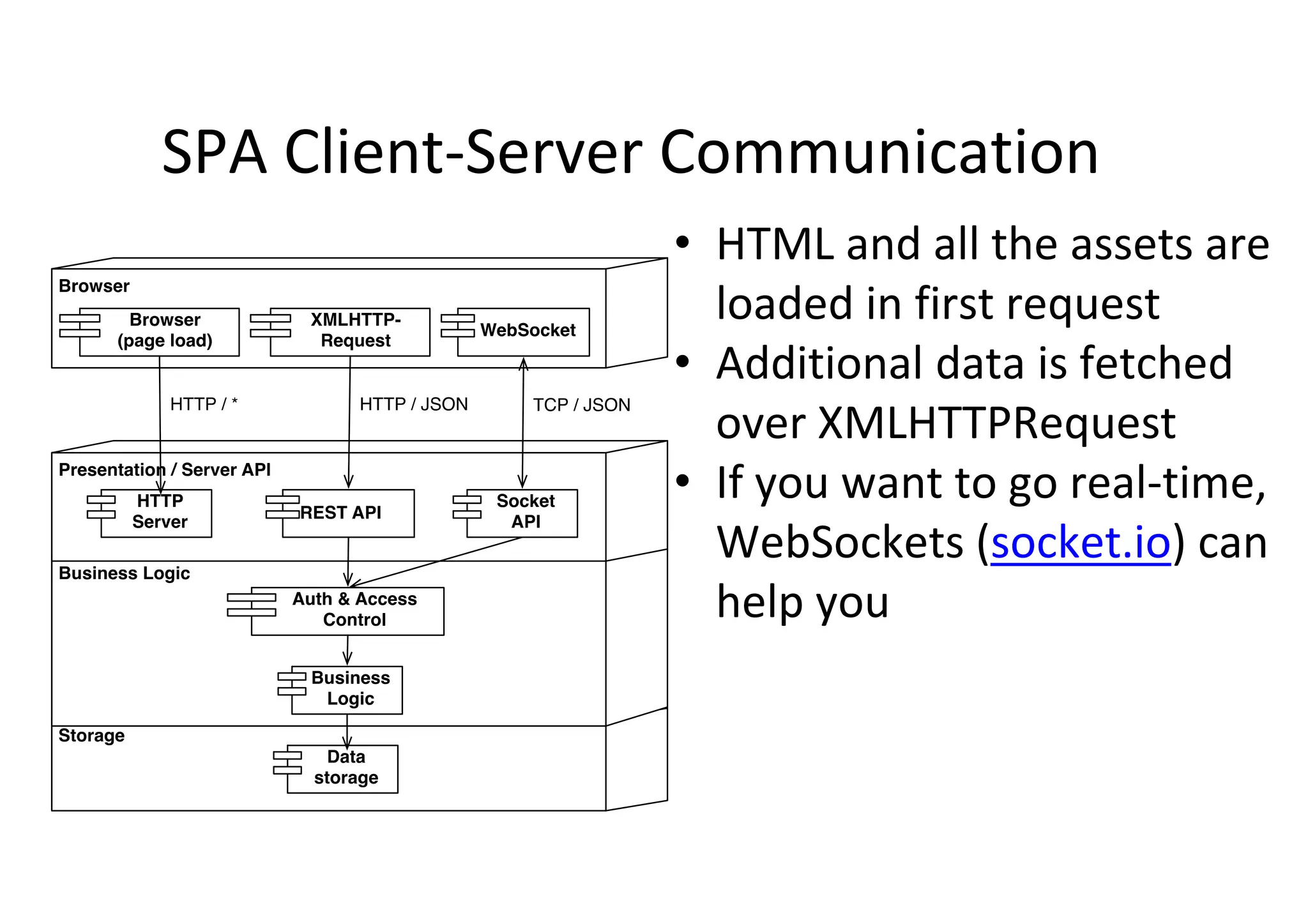

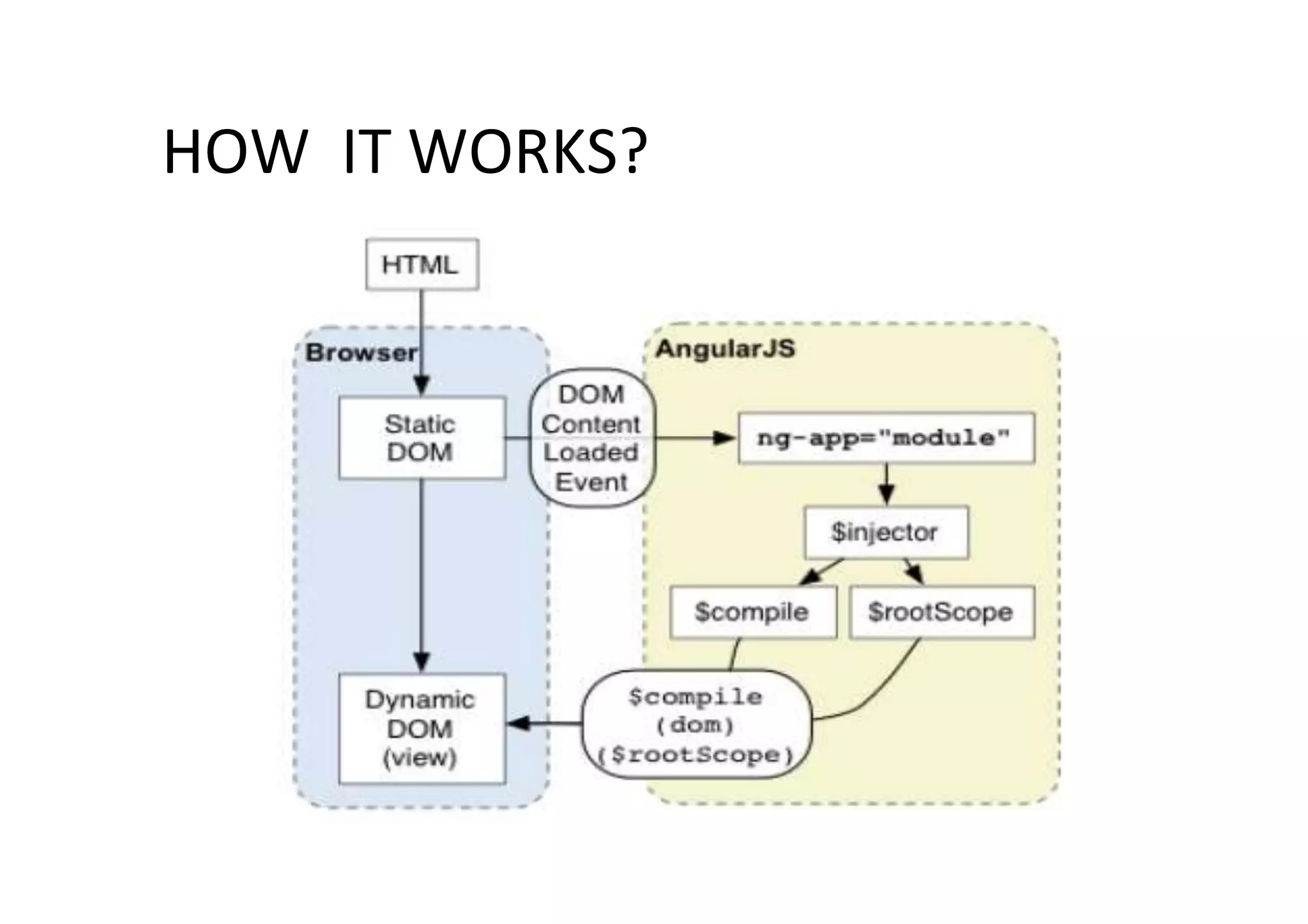

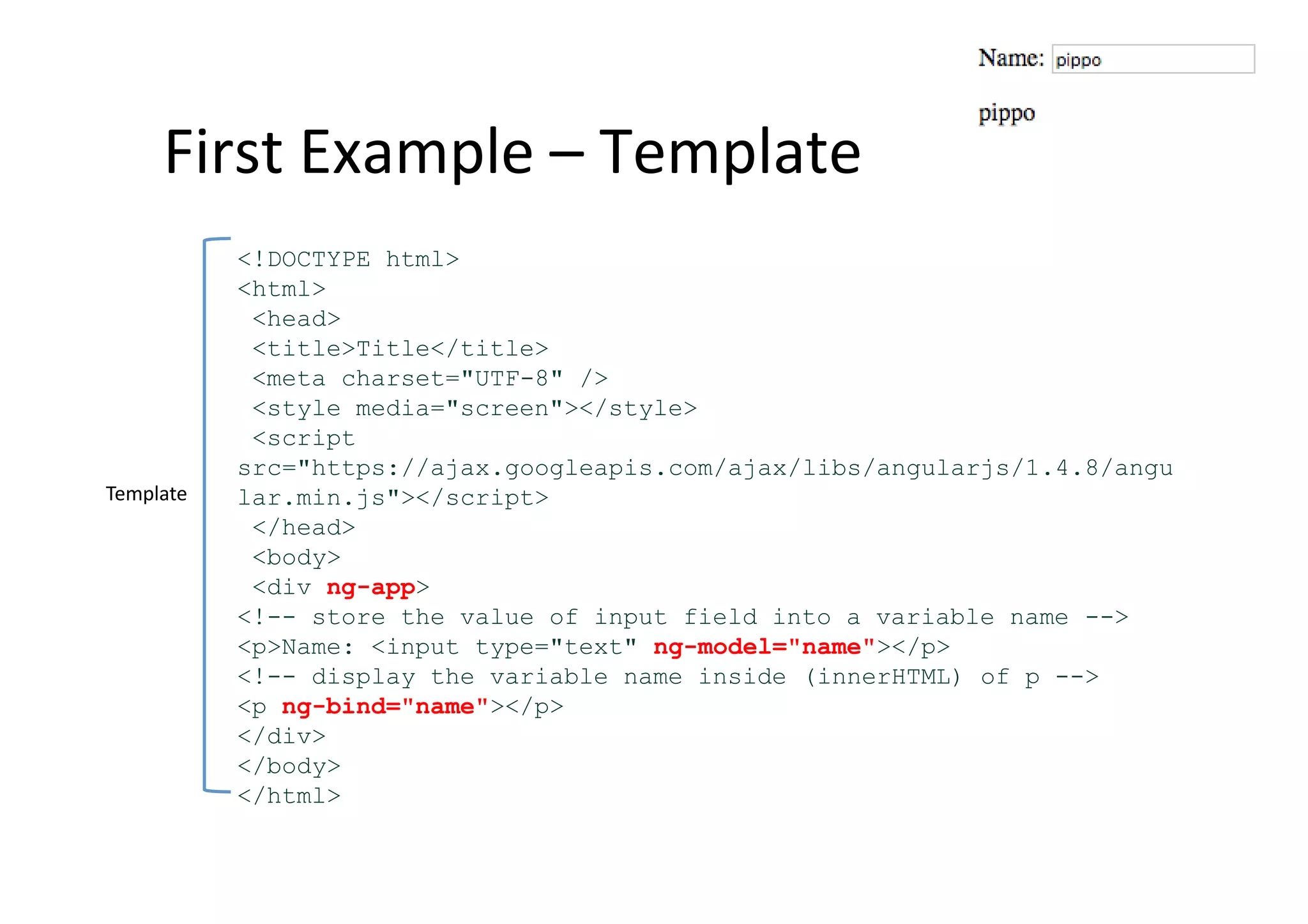
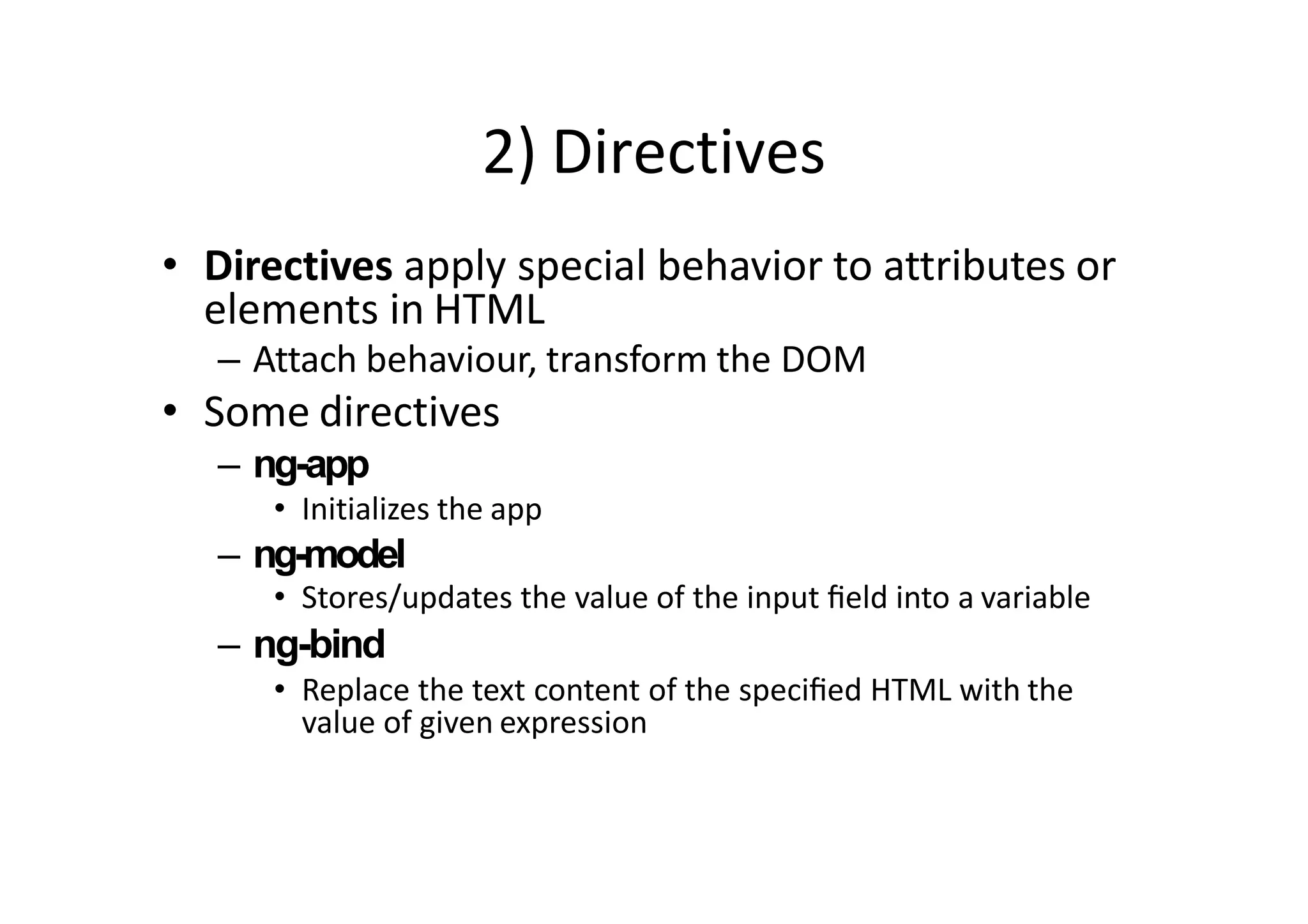
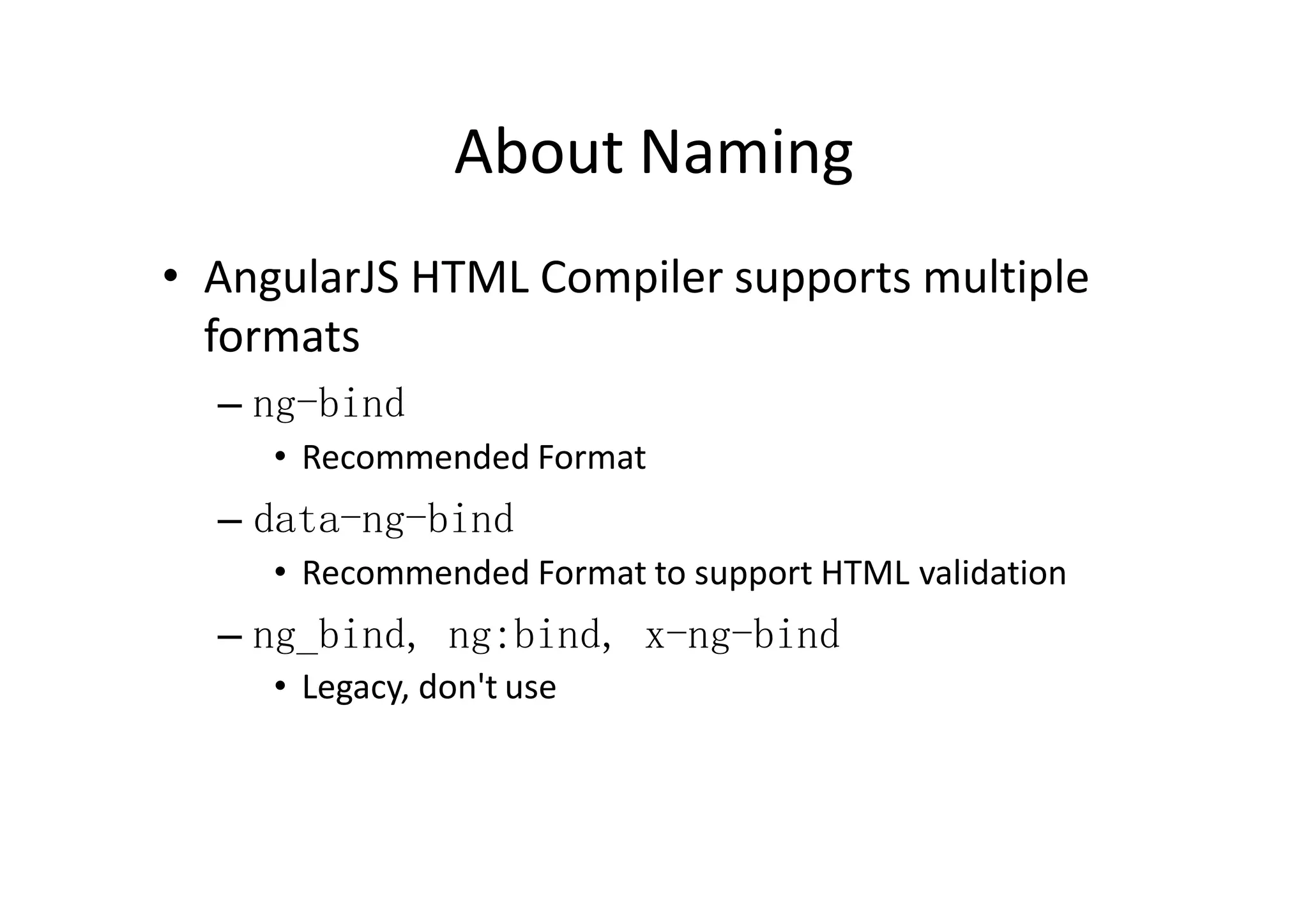

![2) Expressions • Angular expressions are JavaScript-‐likecode snippets that are usually placed in bindings – {{ expression }}. • Valid Expressions – {{ 1 + 2 }} – {{ a + b }} – {{ items[index] }} • Control flow (loops, if) are not supported! • You can use filters to format or filter data](https://image.slidesharecdn.com/angularjs-intro-201215174146/75/Angular-jS-Introduction-by-Google-51-2048.jpg)

![ng-‐initand ng-‐repeat directives <!DOCTYPE html> <html data-ng-app=""> <head> <title>Title</title> <meta charset="UTF-8" /> <script src="https://ajax.googleapis.com/ajax/libs/angularjs/1.4.8/angular.min .js"></script> </head> <body> <div data-ng-init="names = ['Jack', 'John', 'Tina']"> <h1>Cool loop!</h1> <ul> <li data-ng-repeat="name in names">{{ name }}</li> </ul> </div> </body> </html>](https://image.slidesharecdn.com/angularjs-intro-201215174146/75/Angular-jS-Introduction-by-Google-53-2048.jpg)
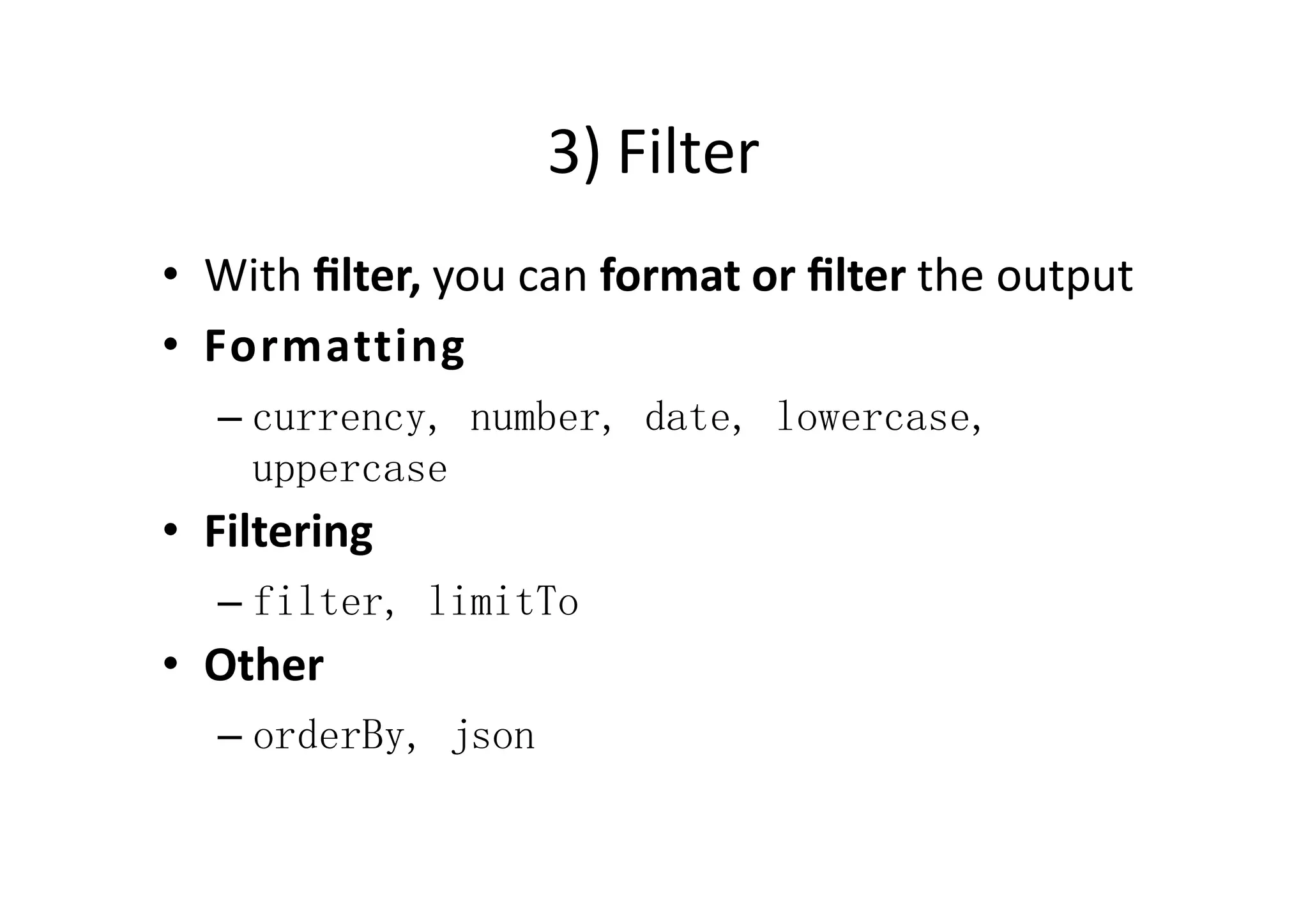
![Using Filters -‐Example <!DOCTYPE html> <html data-ng-app=""> <head> <title>Title</title> <meta charset="UTF-8" /> <style media="screen"></style> <script src="https://ajax.googleapis.com/ajax/libs/angularjs/1.4.8/angular.min.js">< /script> </head> <body> <div data-ng-init="customers = [{name:’tina'}, {name:’jack'}]"> <h1>Cool loop!</h1> <ul> <li data-ng-repeat="customer in customers | orderBy:'name'"> {{ customer.name | uppercase }}</li> </ul> </div> </body> </html> Filter Filter](https://image.slidesharecdn.com/angularjs-intro-201215174146/75/Angular-jS-Introduction-by-Google-55-2048.jpg)
![Using Filters -‐Example <!DOCTYPE html> <html data-ng-app=""> <head> <title>Title</title> <meta charset="UTF-8" /> <style media="screen"></style> <script src="https://ajax.googleapis.com/ajax/libs/angularjs/1.4.8/angular.min.js"></script> </head> <body> <div data-ng-init= "customers = [{name:'jack'}, {name:'tina'}, {name:'john'}, {name:'donald'}]"> <h1>Customers</h1> <ul> <li data-ng-repeat="customer in customers | orderBy:'name' | filter:'john'">{{ customer.name | uppercase }}</li> </ul> </div> </body> </html>](https://image.slidesharecdn.com/angularjs-intro-201215174146/75/Angular-jS-Introduction-by-Google-56-2048.jpg)
![Using Filters – User Input Filters the Data <!DOCTYPE html> <html data-ng-app=""> <head> <title>Title</title> <meta charset="UTF-8" /> <style media="screen"></style> <script src="https://ajax.googleapis.com/ajax/libs/angularjs/1.4.8/angular.min.js">< /script> </head> <body> <div data-ng-init= "customers = [{name:'jack'}, {name:'tina'}, {name:'john'}, {name:'donald'}]"> <h1>Customers</h1> <input type="text" data-ng-model="userInput" /> <ul> <li data-ng-repeat="customer in customers | orderBy:'name' | filter:userInput">{{ customer.name | uppercase }}</li> </ul> </div> </body> </html>](https://image.slidesharecdn.com/angularjs-intro-201215174146/75/Angular-jS-Introduction-by-Google-57-2048.jpg)


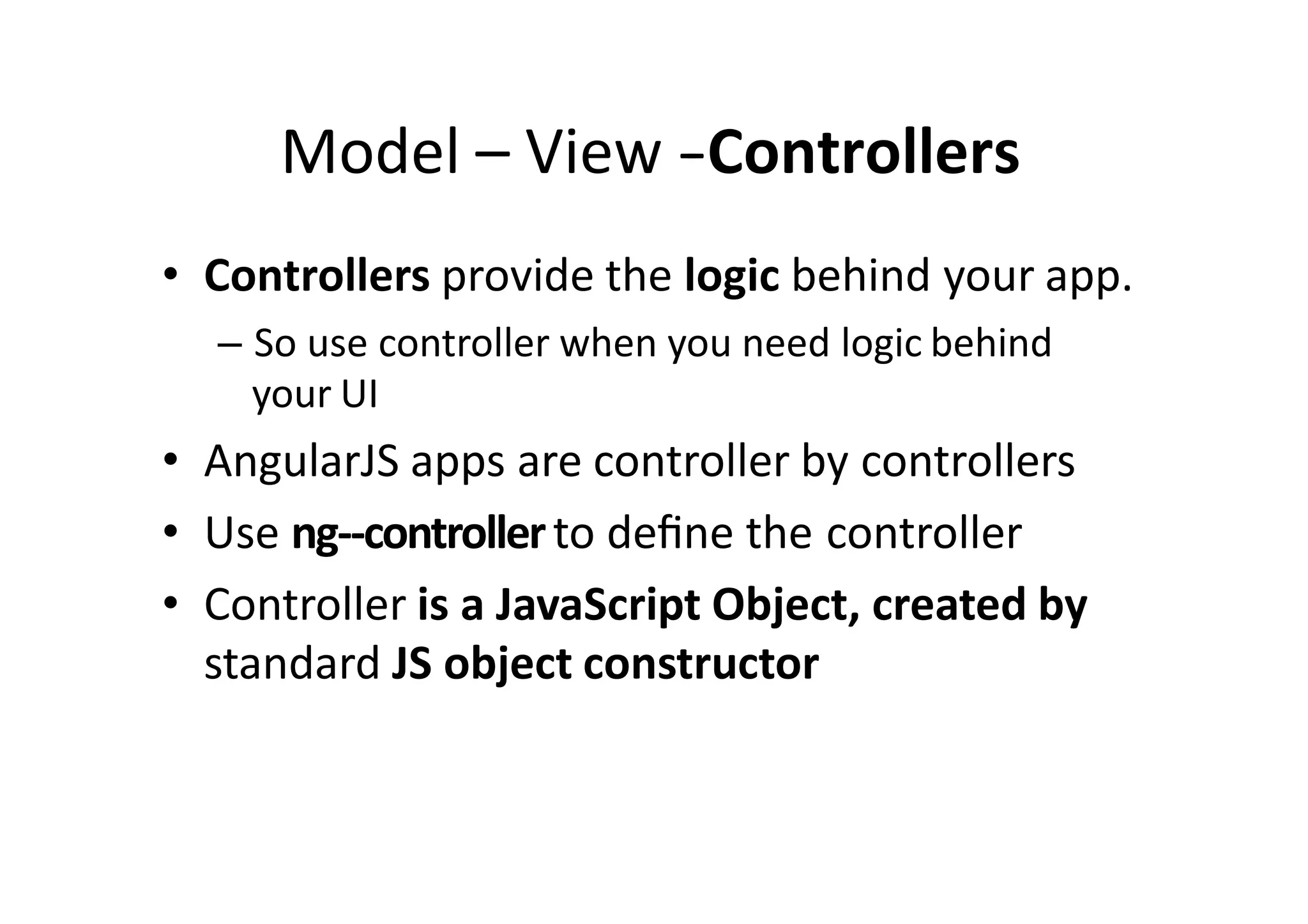

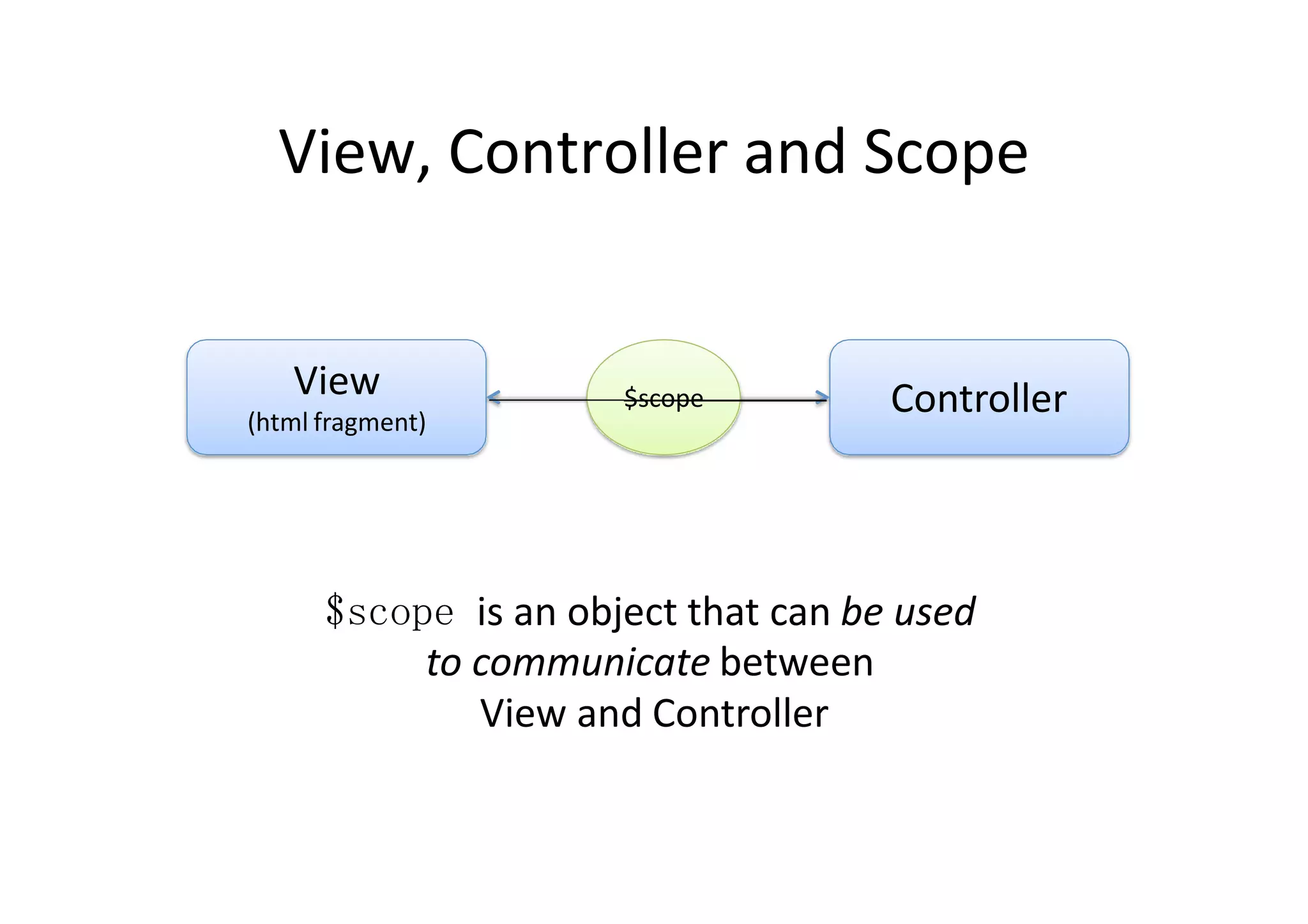
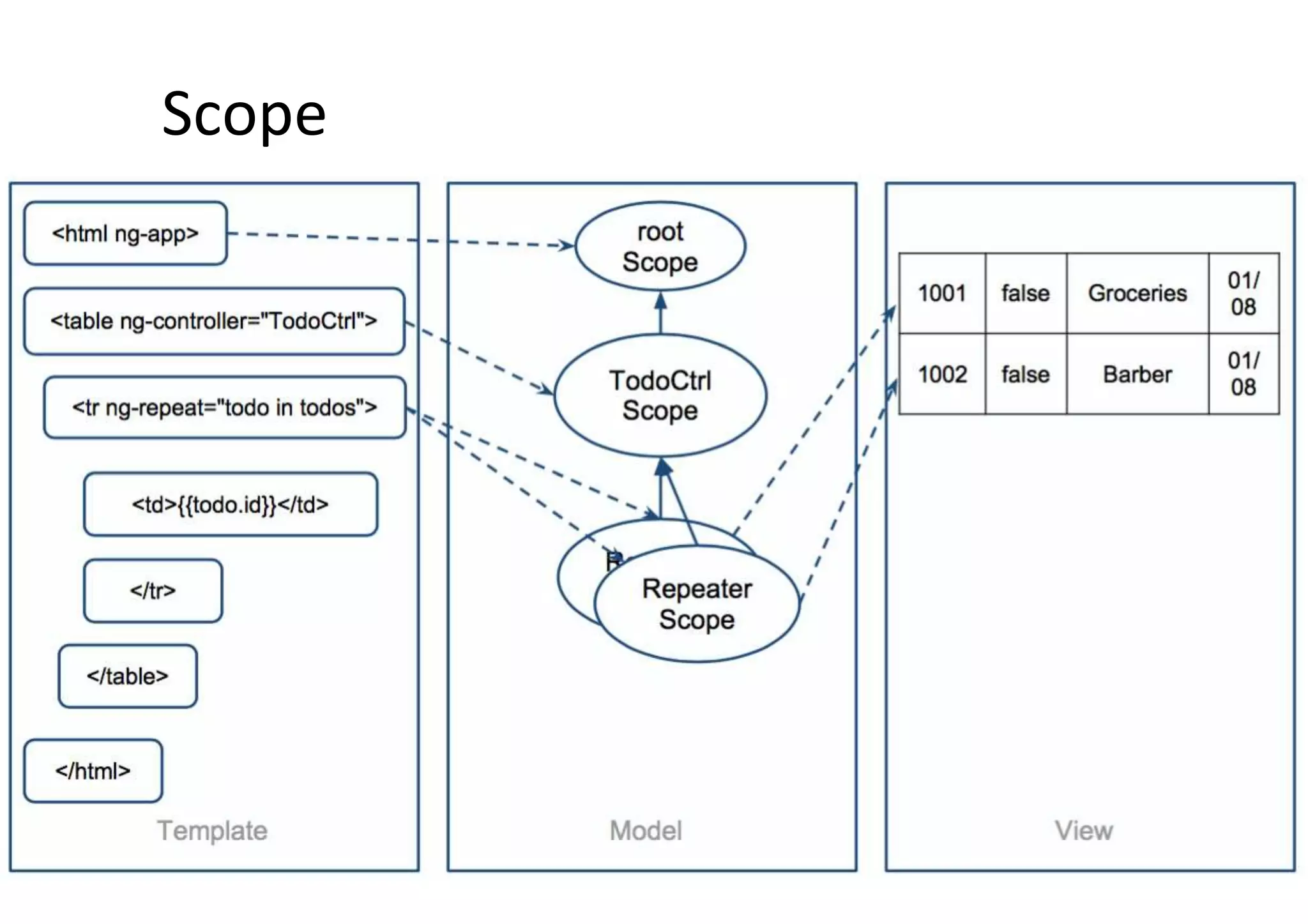
![<!DOCTYPE html> <html> <head> <title>Title</title> <meta charset="UTF-8" /> <style media="screen"></style> <script src="https://ajax.googleapis.com/ ajax/libs/angularjs/1.4.8/angular.min.js"> </script> </head> <body> <div data-ng-app="myApp" data-ng-controller="NumberCtrl"> <p>Number: <input type="number" ng-model="number"></p> <p>Number = {{ number }}</p> <button ng-click="showNumber()">Show Number</button> </div> <script> var app = angular.module('myApp', []); app.controller('NumberCtrl', function($scope) { $scope.number = 1; $scope.showNumber = function(){ window.alert( "your number= " + $scope.number ); }; }); </script> </body> </html>](https://image.slidesharecdn.com/angularjs-intro-201215174146/75/Angular-jS-Introduction-by-Google-64-2048.jpg)
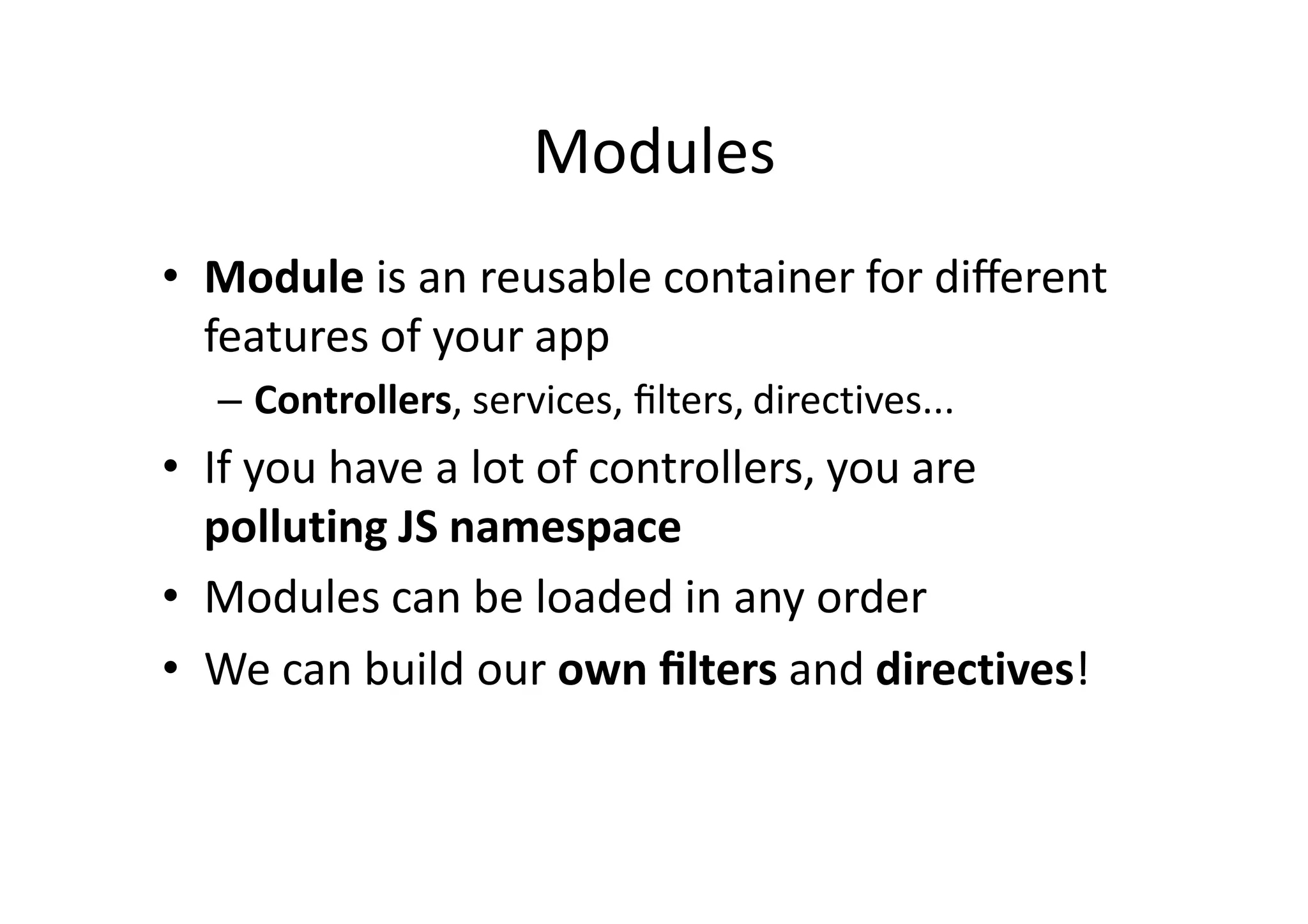
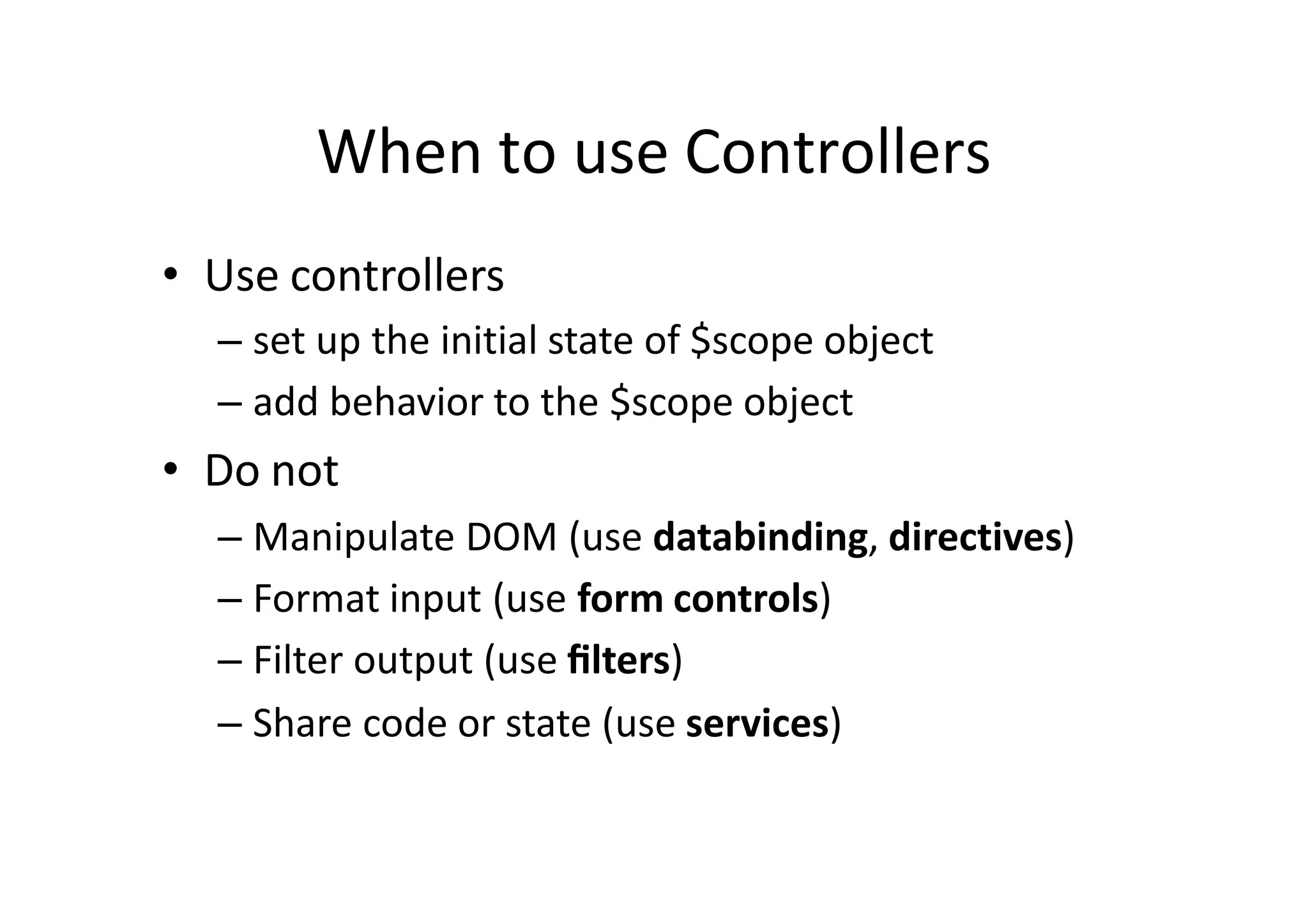
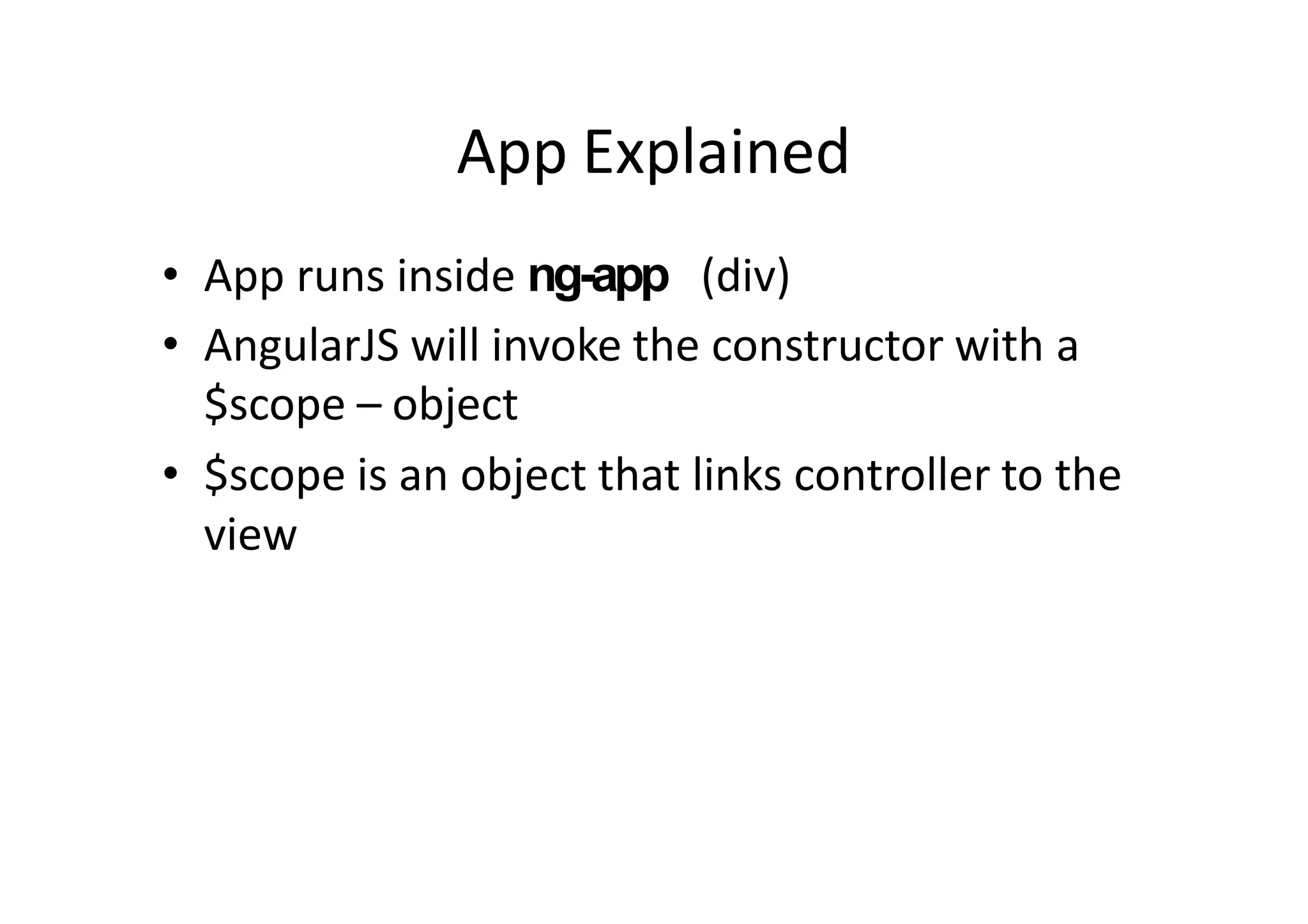
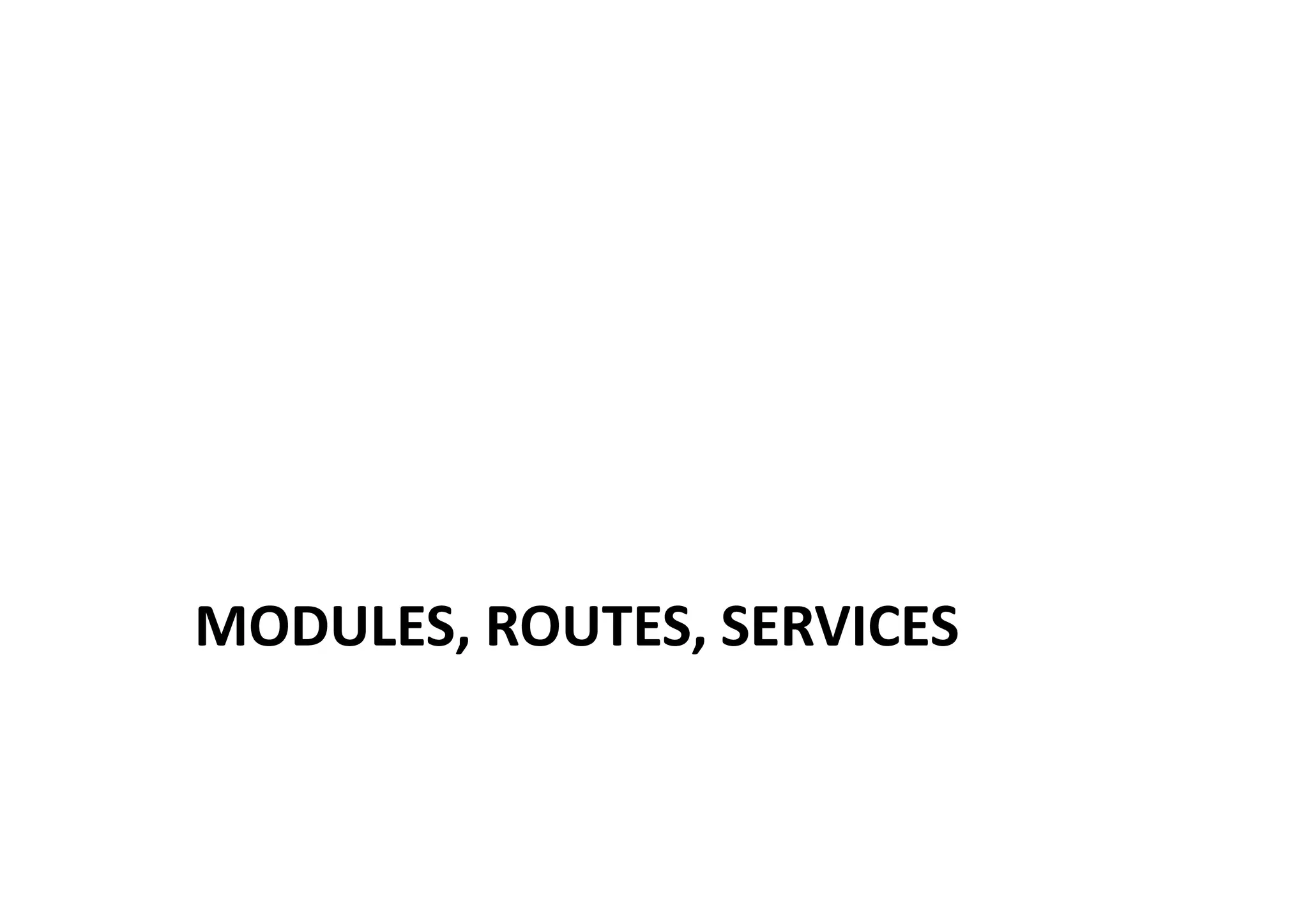
![Example: Own Filter // declare a module var myAppModule = angular.module('myApp', []); filter // configure the module. // in this example we will create a greeting myAppModule.filter('greet', function() { return function(name) { ' + name + '!';return 'Hello, }; });](https://image.slidesharecdn.com/angularjs-intro-201215174146/75/Angular-jS-Introduction-by-Google-69-2048.jpg)
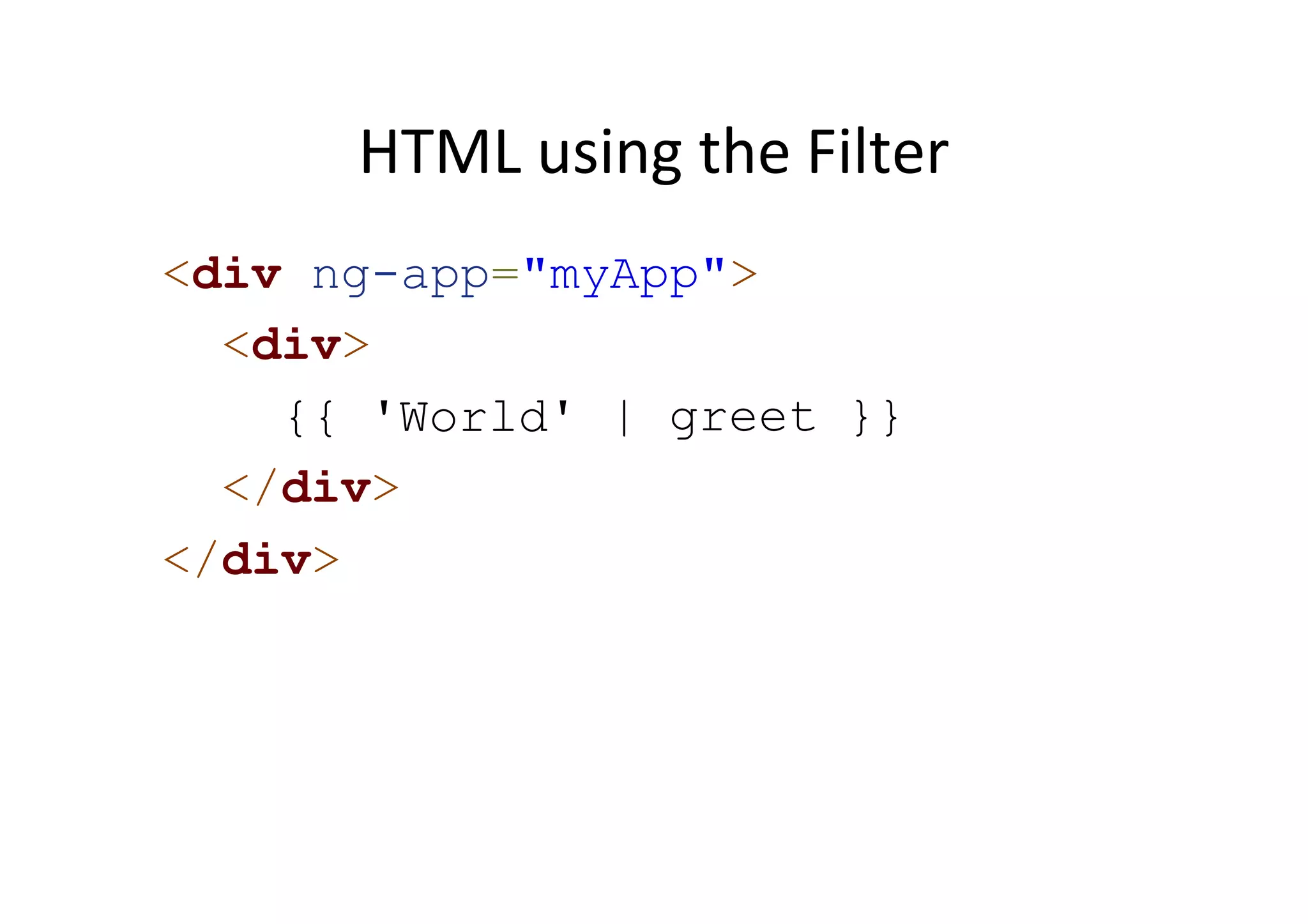
![Template for Controllers // Create new module 'myApp' using angular.module method. // The module is not dependent on any other module var myModule = angular.module('myModule', []); myModule.controller('MyCtrl', function ($scope) { // Your controller code here! });](https://image.slidesharecdn.com/angularjs-intro-201215174146/75/Angular-jS-Introduction-by-Google-71-2048.jpg)
![Creating a Controller in Module var myModule = angular.module('myModule', []); myModule.controller('MyCtrl', function ($scope) { var model = { "firstname": "Jack", "lastname": "Smith" }; $scope.model = model; $scope.click = function() { alert($scope.model.firstname); }; });](https://image.slidesharecdn.com/angularjs-intro-201215174146/75/Angular-jS-Introduction-by-Google-72-2048.jpg)



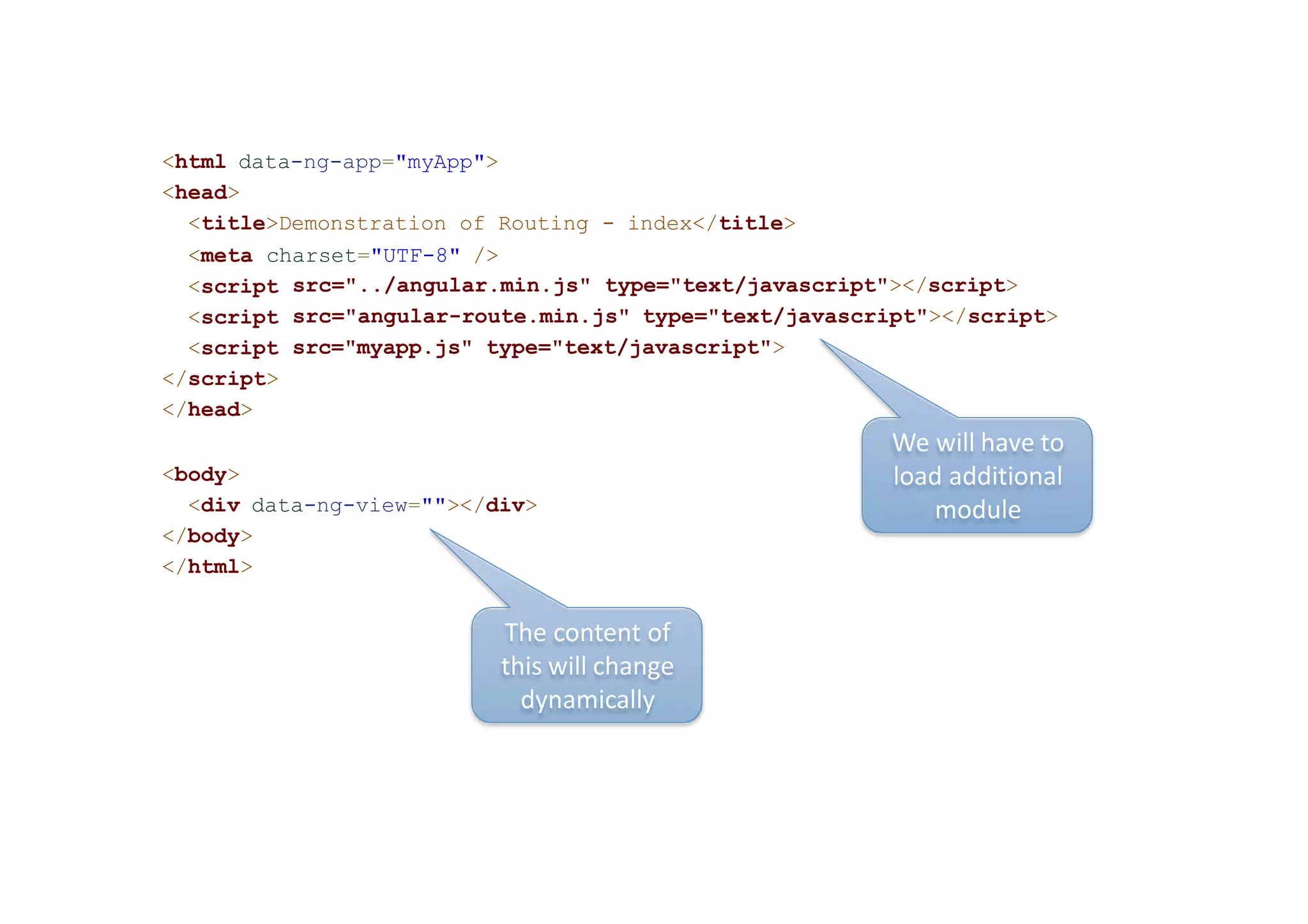
![// This module is dependent on ngRoute. Load ngRoute // before this. var myApp = angular.module('myApp', ['ngRoute']); views. // Configure routing. myApp.config(function($routeProvider) { // Usually we have different controllers for different // In this demonstration, the controller does nothing. $routeProvider.when('/', { templateUrl: 'view1.html', controller: 'MySimpleCtrl' }); $routeProvider.when('/view2', { templateUrl: 'view2.html', controller: 'MySimpleCtrl' }); $routeProvider.otherwise({ redirectTo: '/' }); }); // Let's add a new controller to MyApp myApp.controller('MySimpleCtrl', function ($scope) { });](https://image.slidesharecdn.com/angularjs-intro-201215174146/75/Angular-jS-Introduction-by-Google-77-2048.jpg)
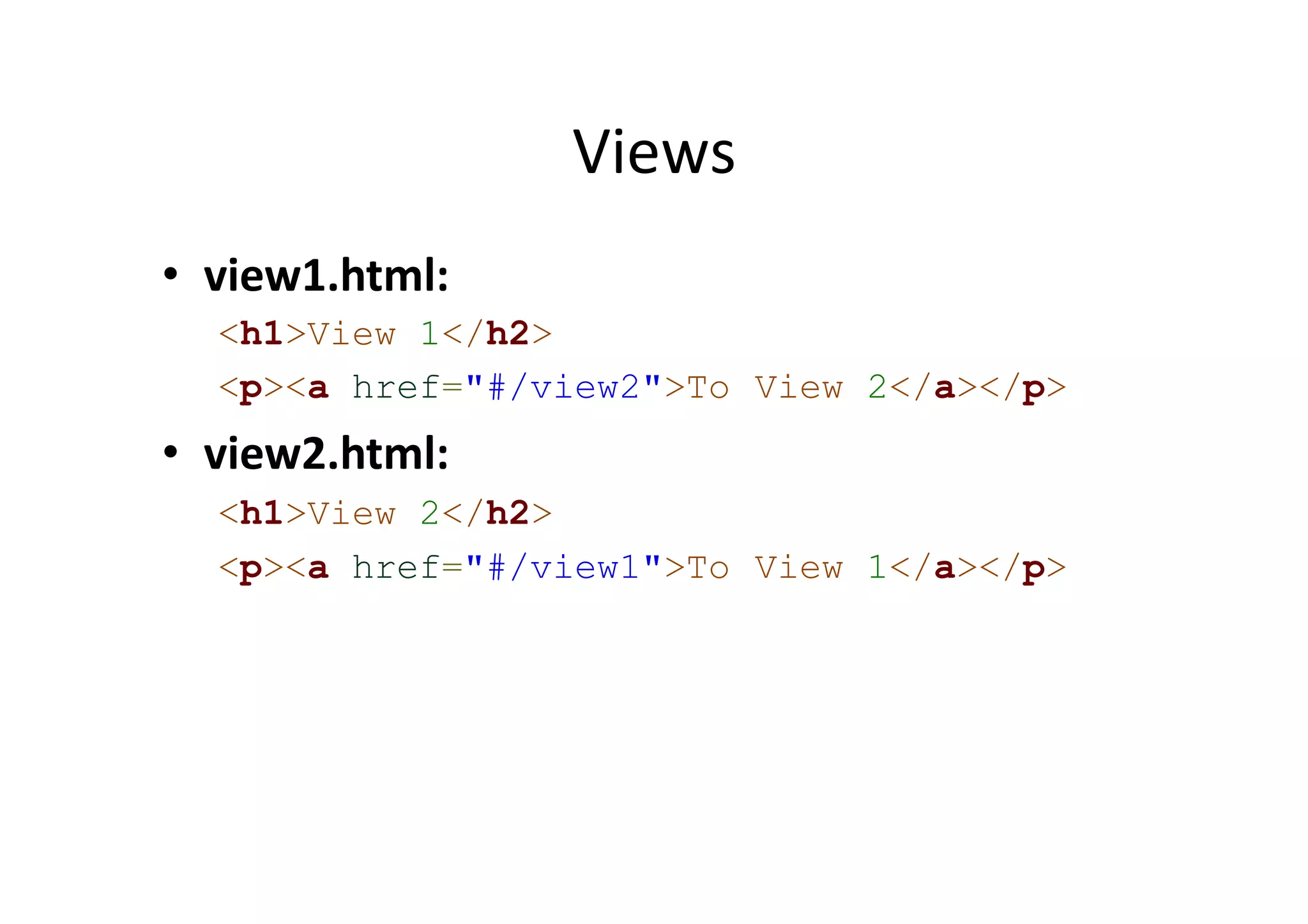
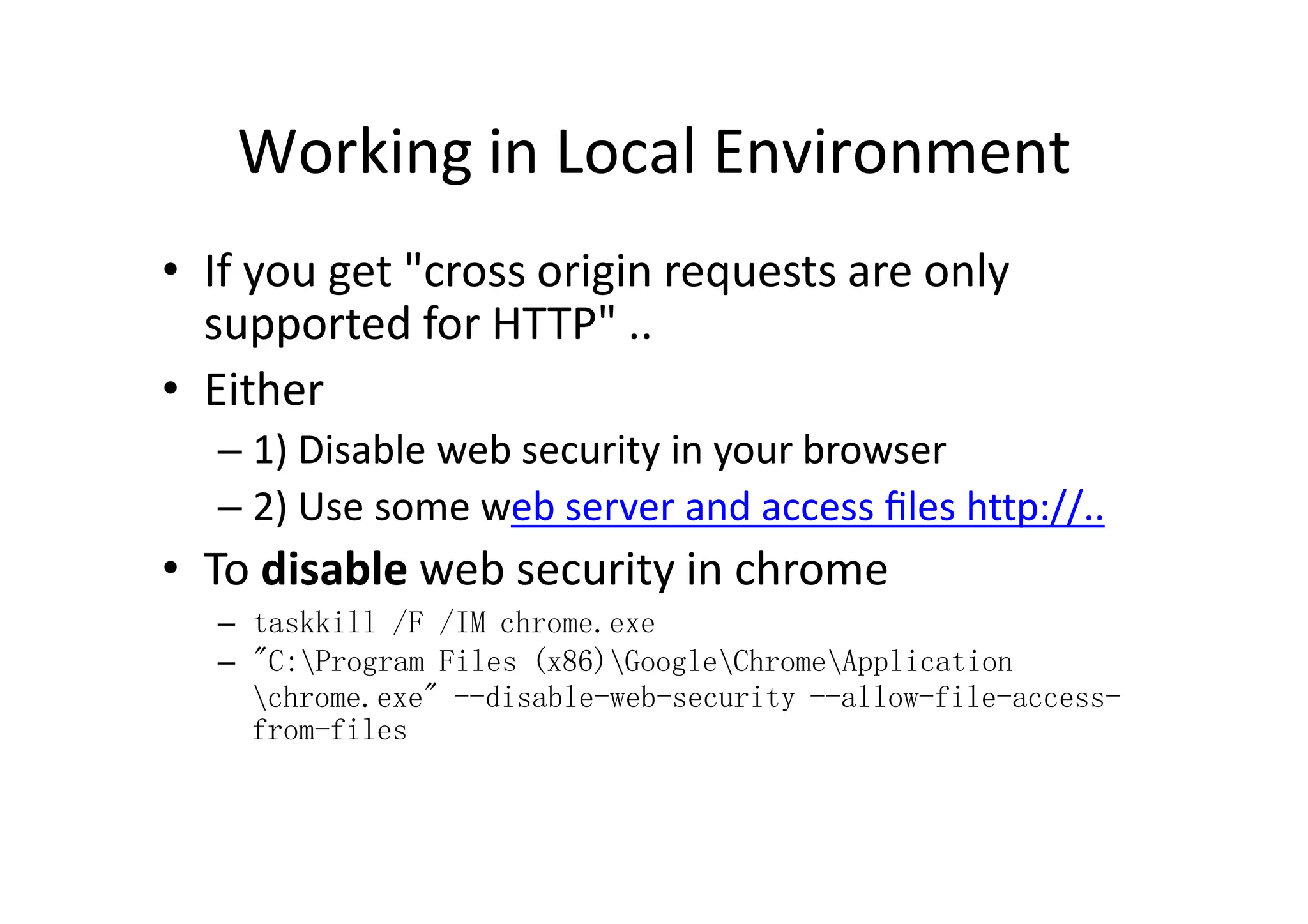
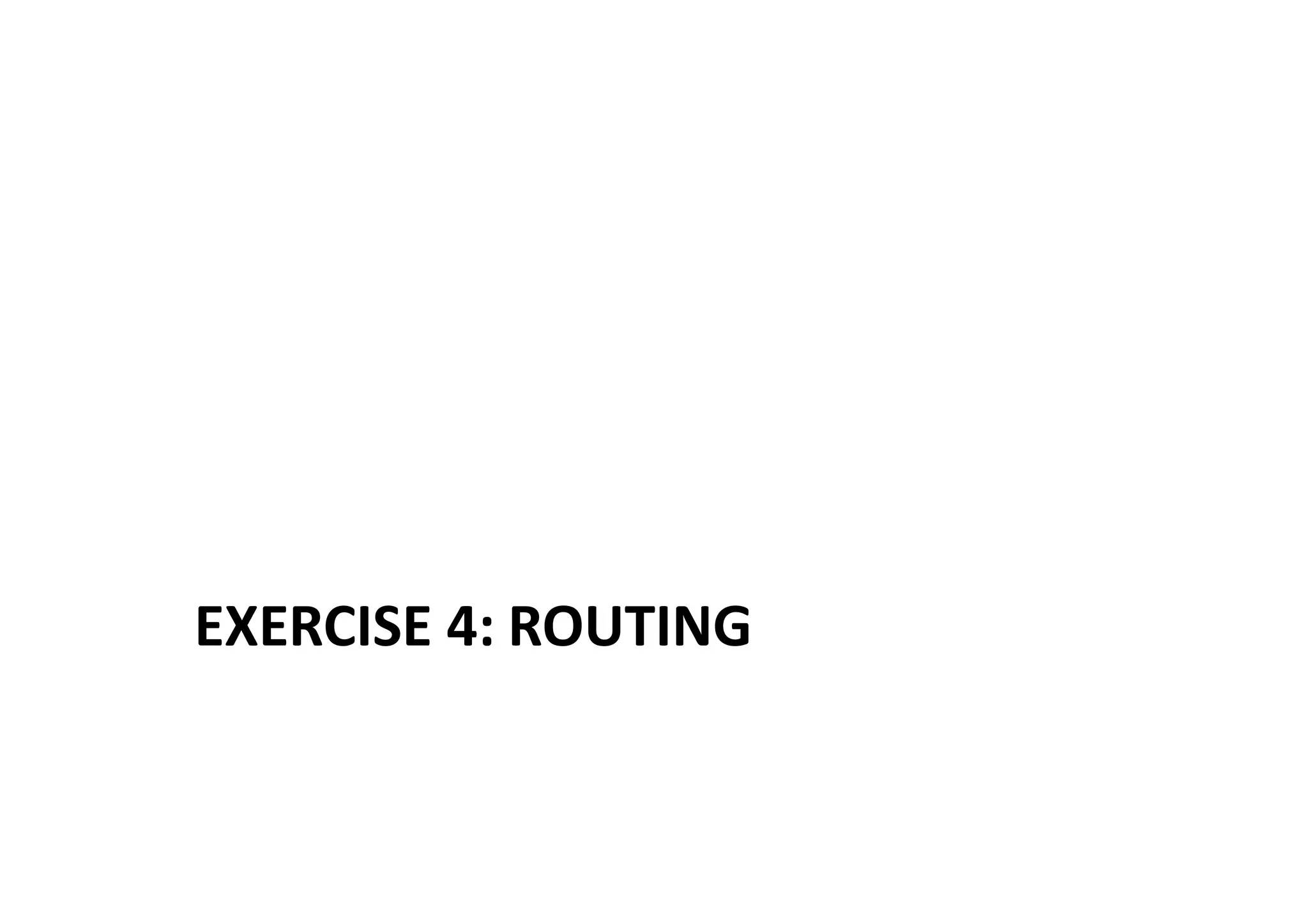
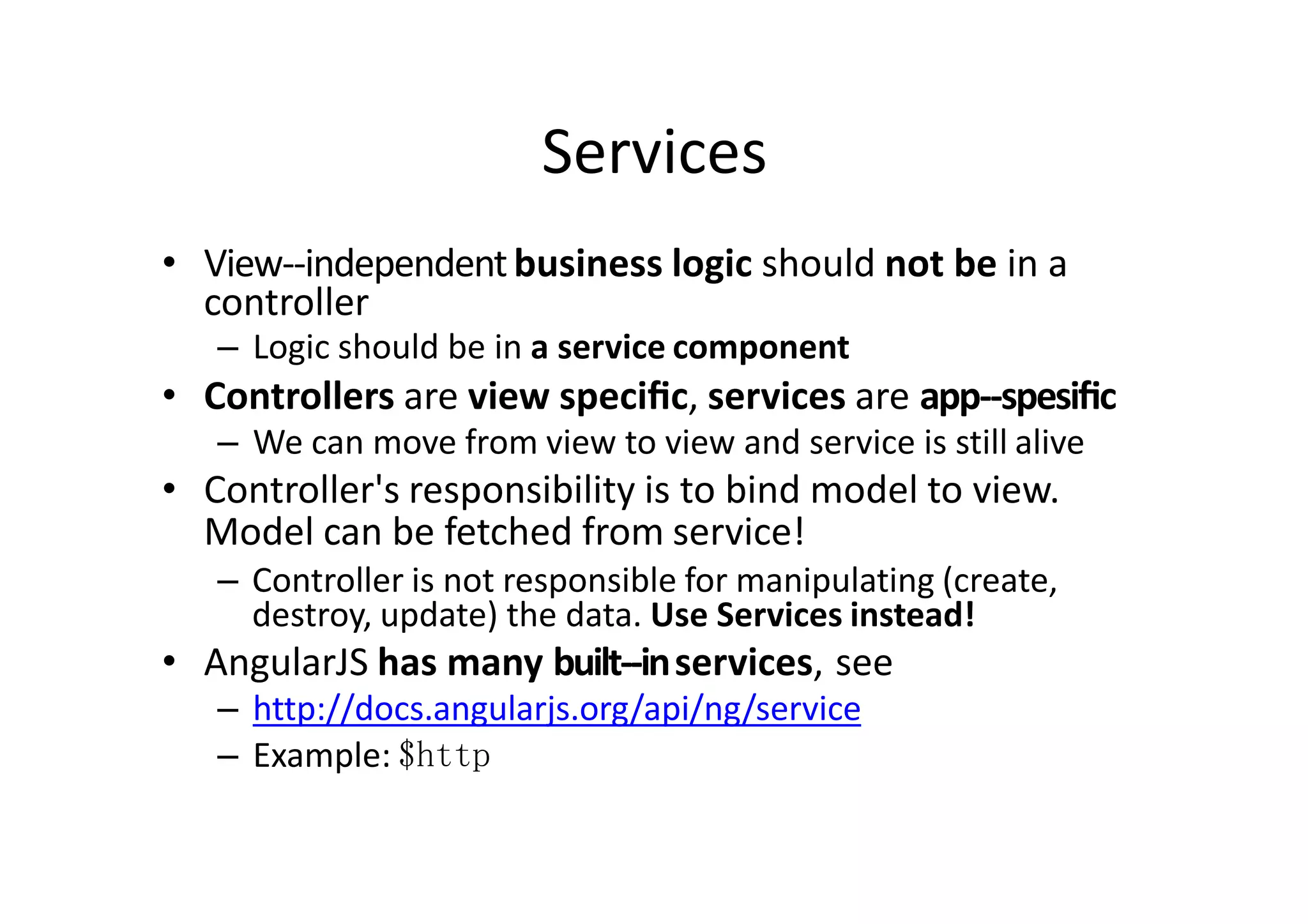

![AngularJS Custom Services using Factory // Let's add a new controller to MyApp. This controller uses Service! myApp.controller('ViewCtrl', function ($scope, CustomerService) { $scope.contacts = CustomerService.contacts; }); // Let's add a new controller to MyApp. This controller uses Service! myApp.controller('ModifyCtrl', function ($scope, CustomerService) { $scope.contacts = CustomerService.contacts; }); // Creating a factory object that contains services for the // controllers. myApp.factory('CustomerService', function() { var factory = {}; factory.contacts = [{name: "Jack", salary: 3000}, {name: "Tina", salary: 5000}, {name: "John", salary: 4000}]; return factory; });](https://image.slidesharecdn.com/angularjs-intro-201215174146/75/Angular-jS-Introduction-by-Google-83-2048.jpg)
![Also Service is instantiated with new – keyword. function can use "this" and the return // Service // Service // value is this. myApp.service('CustomerService', function() { this.contacts = [{name: "Jack", salary: 3000}, {name: {name: "Tina", "John", salary: salary: 5000}, 4000}]; });](https://image.slidesharecdn.com/angularjs-intro-201215174146/75/Angular-jS-Introduction-by-Google-84-2048.jpg)

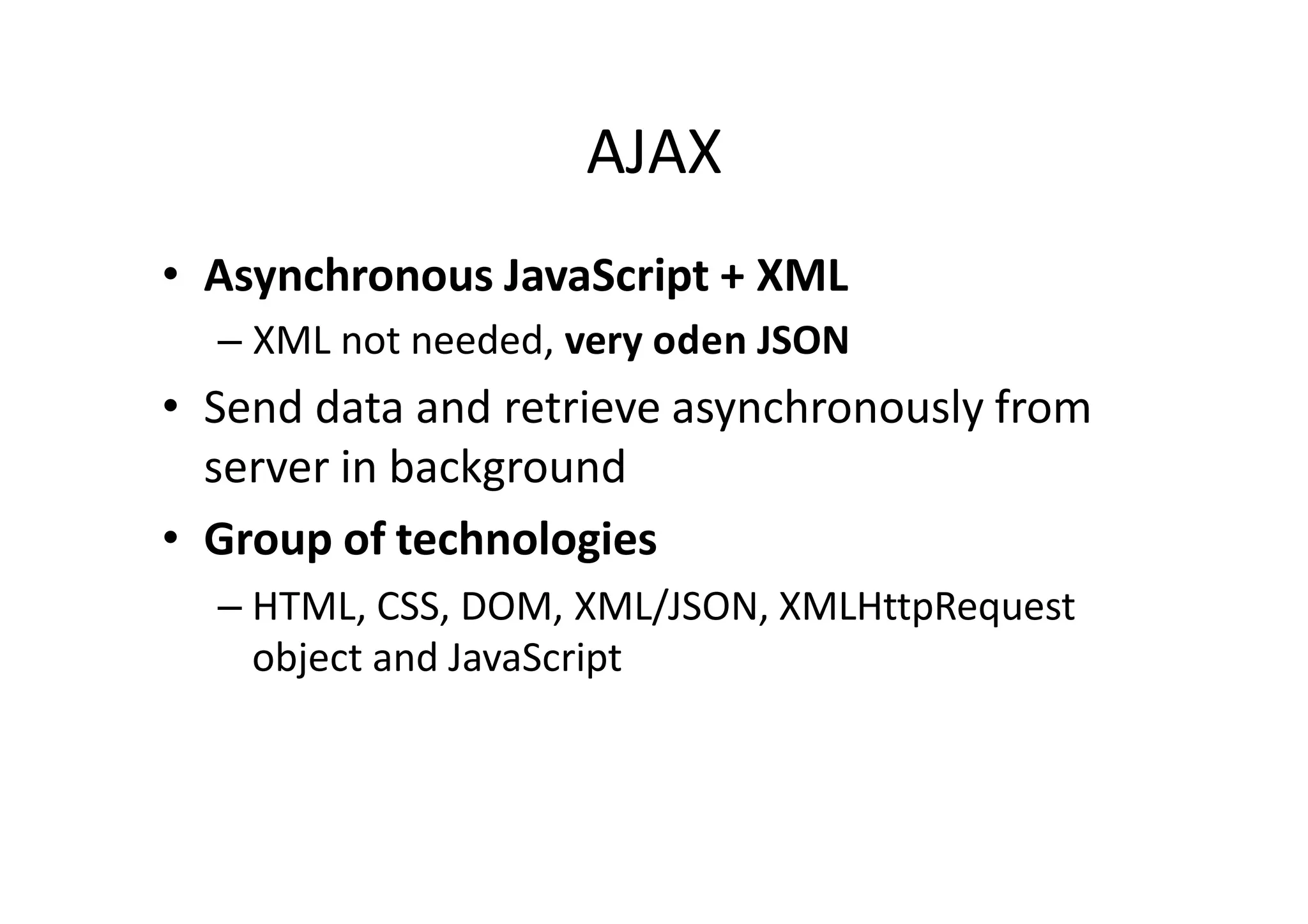
![$http – example (AJAX) and AngularJS <script type="text/javascript"> var myapp = angular.module("myapp", []); myapp.controller("MyController", function($scope, $http) { $scope.myData = {}; $scope.myData.doClick = function(item, event) { var responsePromise = $http.get("text.txt"); responsePromise.success(function(data, status, headers, config) { $scope.myData.fromServer = data; }); responsePromise.error(function(data, status, headers, config) { alert("AJAX failed!"); }); } } ); </script>](https://image.slidesharecdn.com/angularjs-intro-201215174146/75/Angular-jS-Introduction-by-Google-87-2048.jpg)
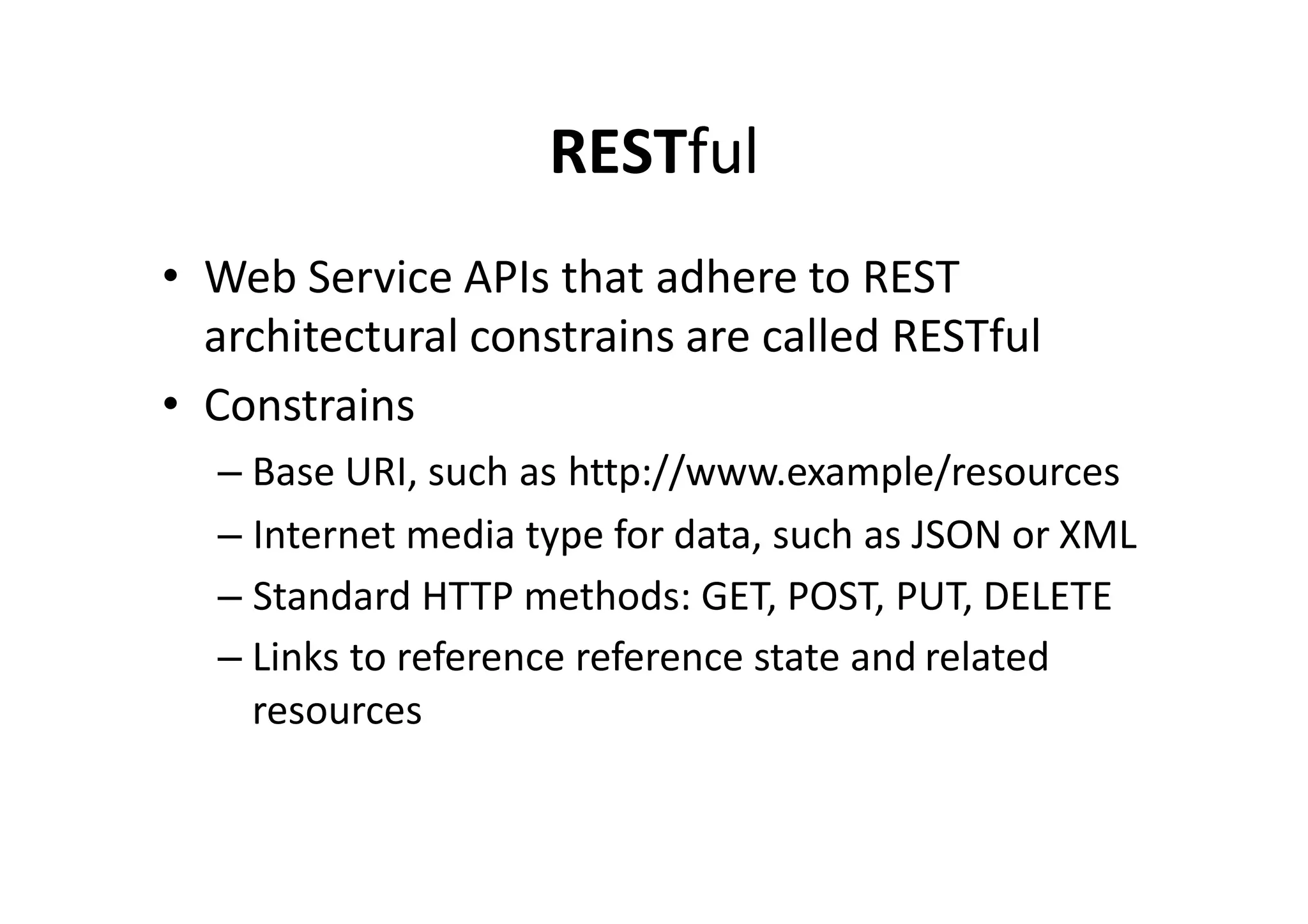

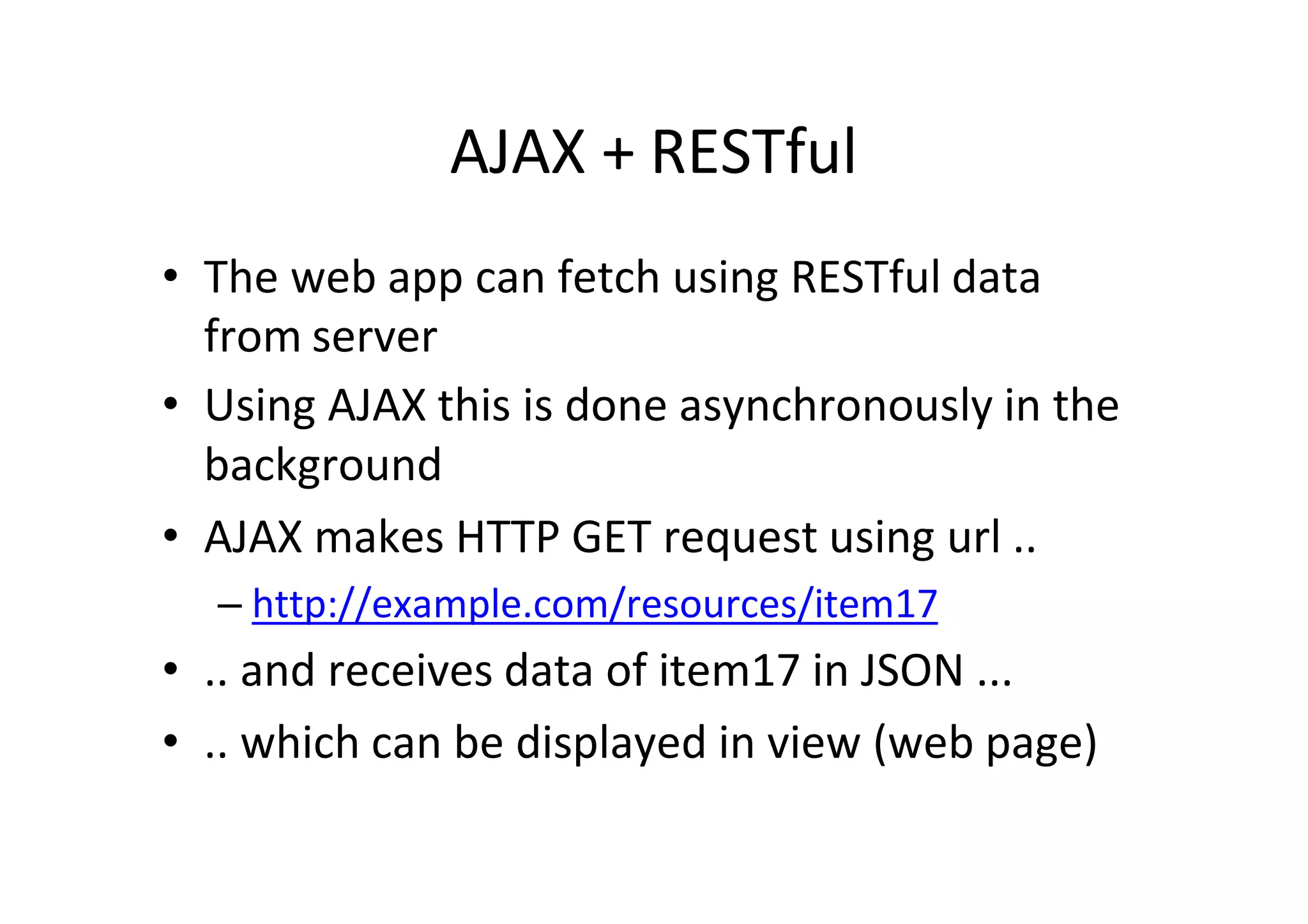
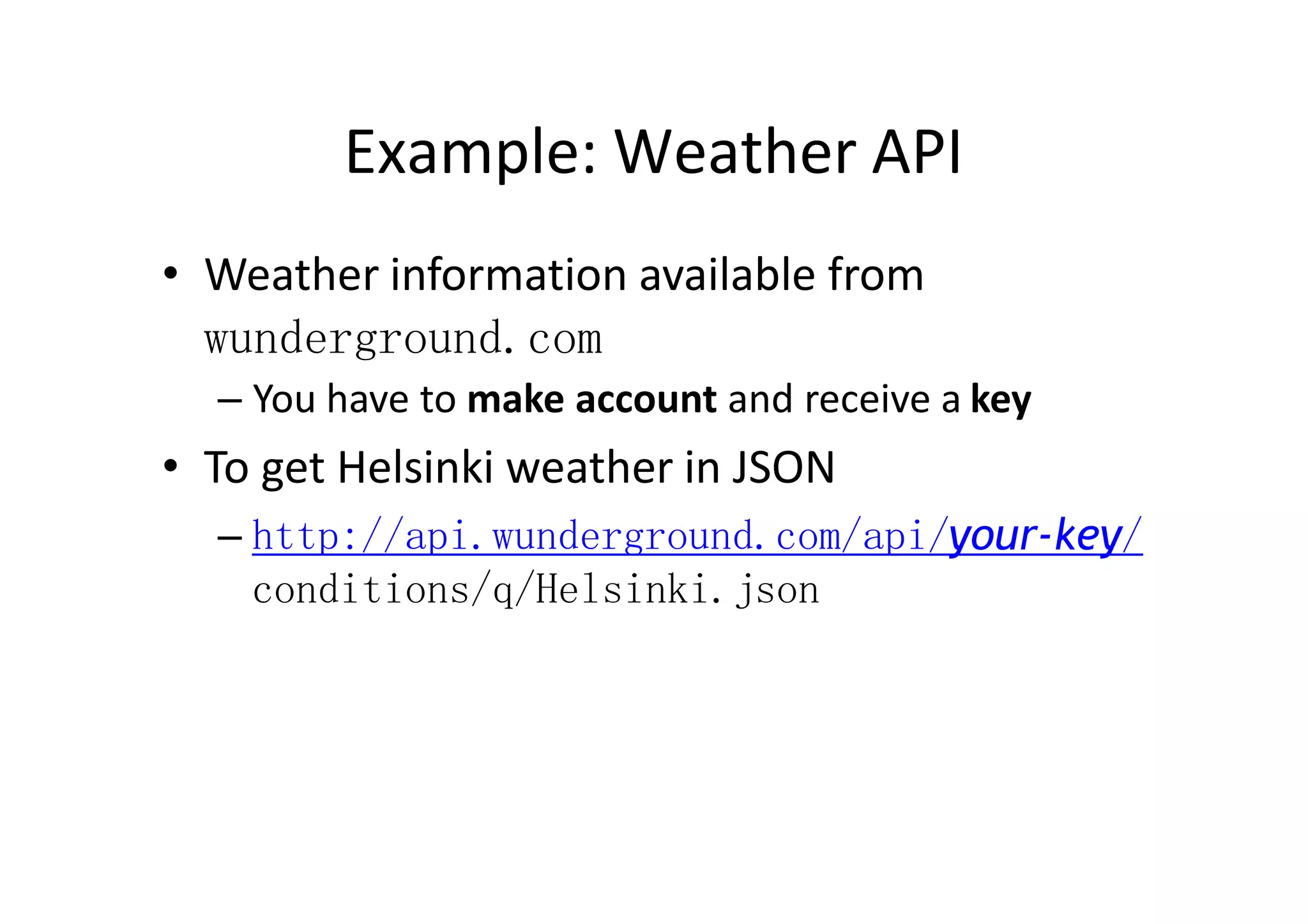
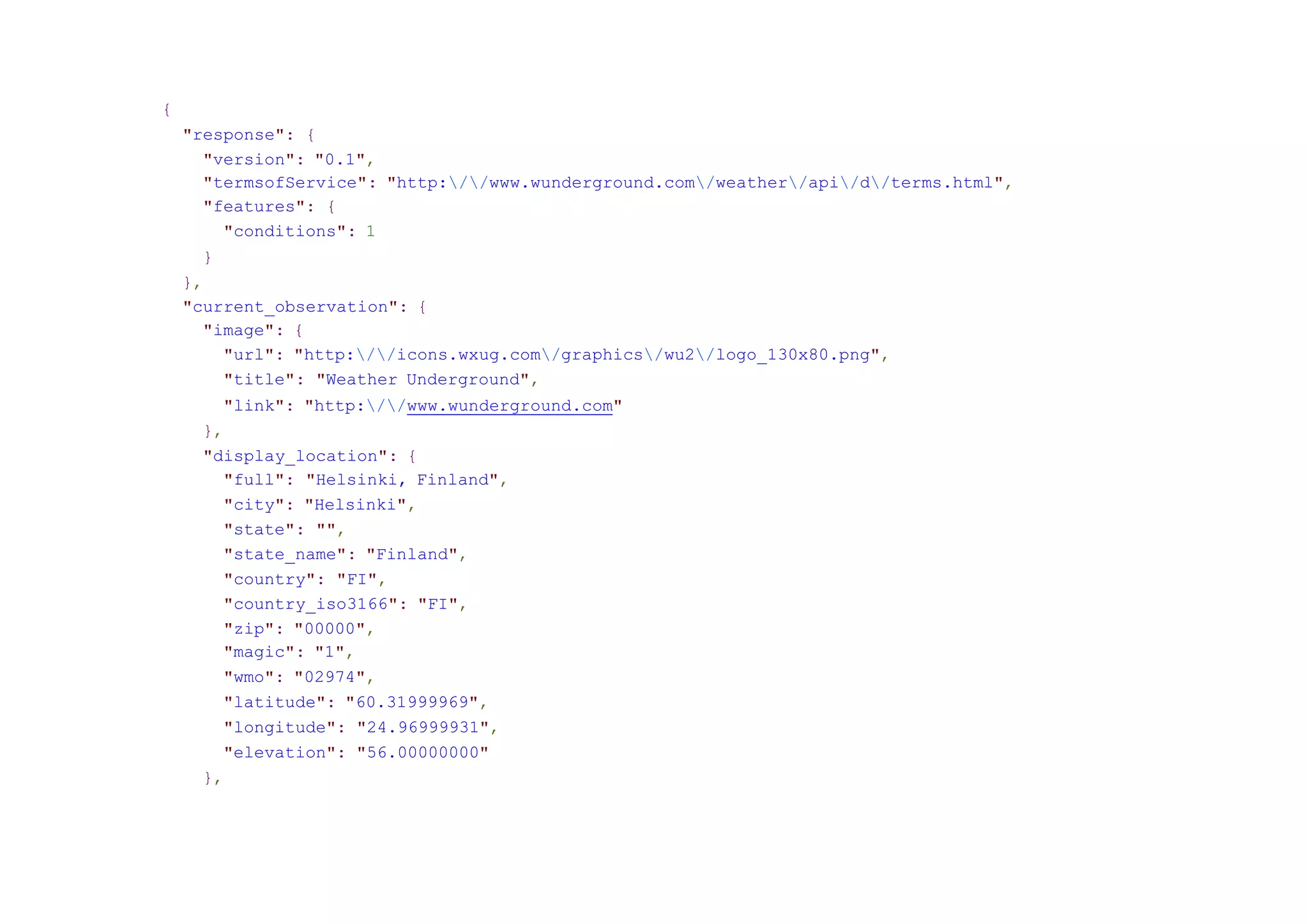
![<!DOCTYPE html> <html> <head> <script src="../angular.min.js" type="text/javascript"></script> <title></title> </head> <body data-ng-app="myapp"> <div data-ng-controller="MyController"> <button data-ng-click="myData.doClick(item, $event)">Get Helsinki Weather</button><br /> Data from server: {{myData.fromServer}} </div> <script type="text/javascript"> var myapp = angular.module("myapp", []); myapp.controller("MyController", function($scope, $http) { $scope.myData = {}; $scope.myData.doClick = function(item, event) { var responsePromise = $http.get("http://api.wunderground.com/api/key/conditions/ q/Helsinki.json"); responsePromise.success(function(data, status, headers, config) { $scope.myData.fromServer = "" + data.current_observation.weather + " " + data.current_observation.temp_c + " c"; }); responsePromise.error(function(data, status, headers, config) { alert("AJAX failed!"); }); } } ); </script> </body> </html> This is JSON object!](https://image.slidesharecdn.com/angularjs-intro-201215174146/75/Angular-jS-Introduction-by-Google-93-2048.jpg)
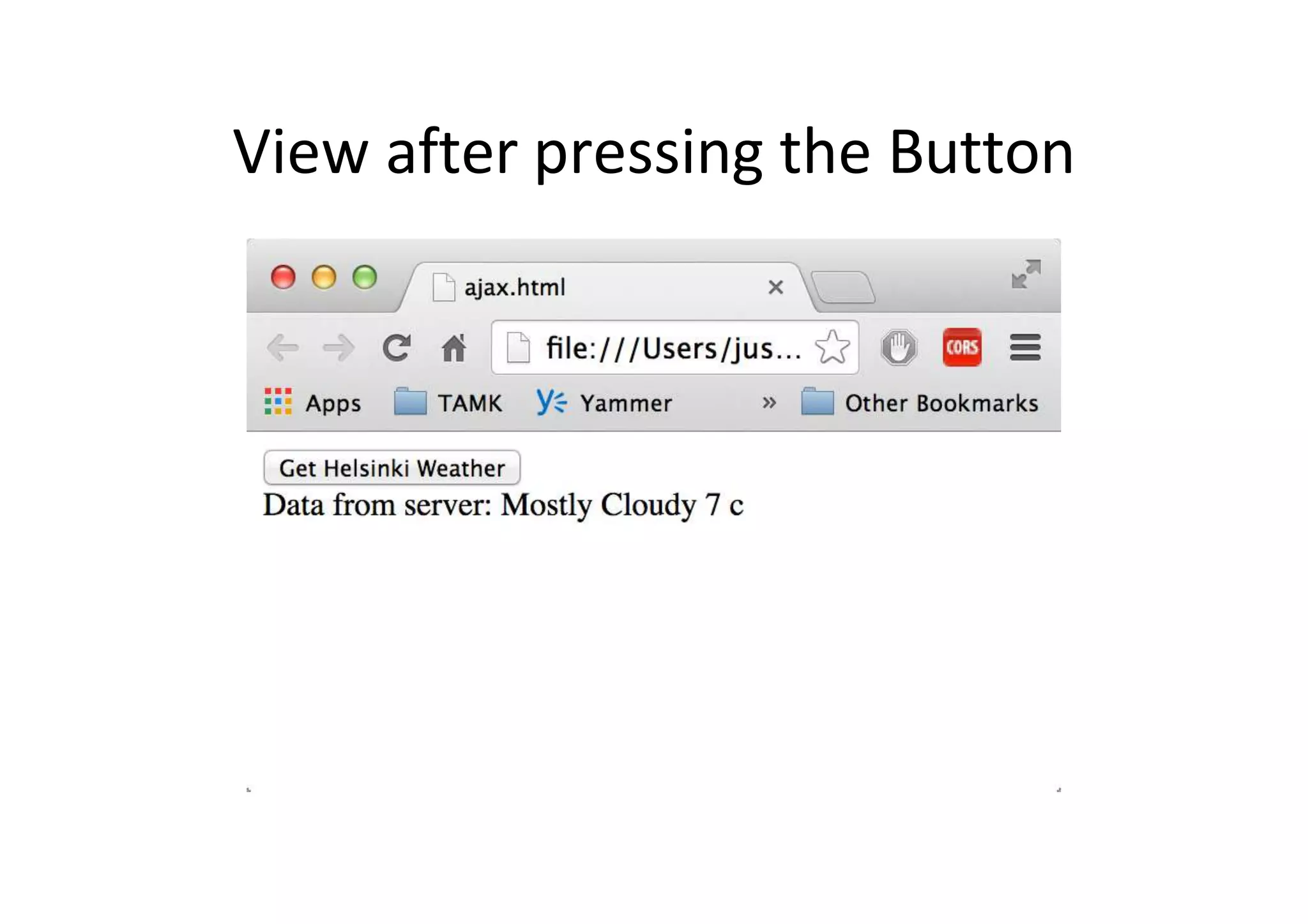
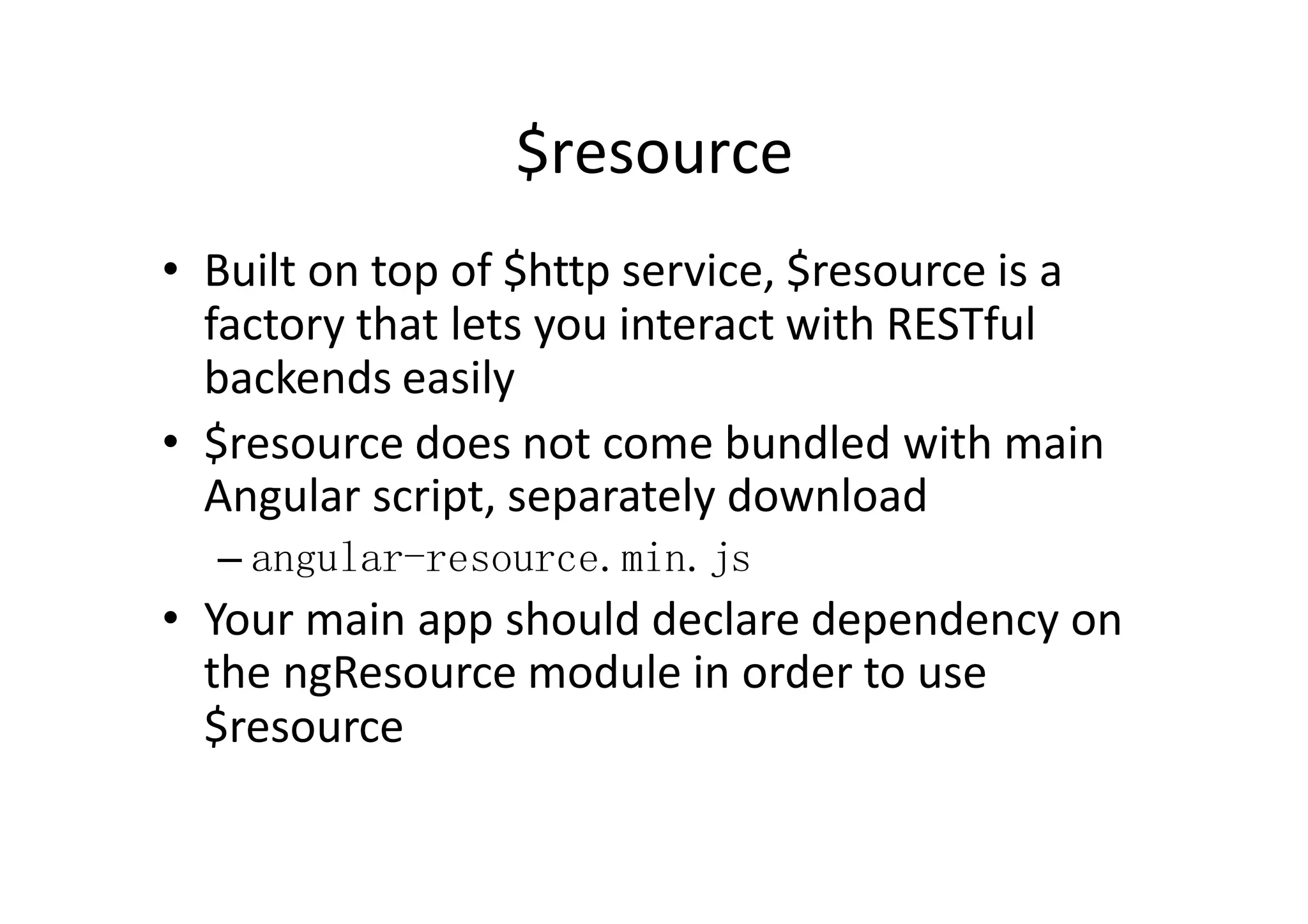
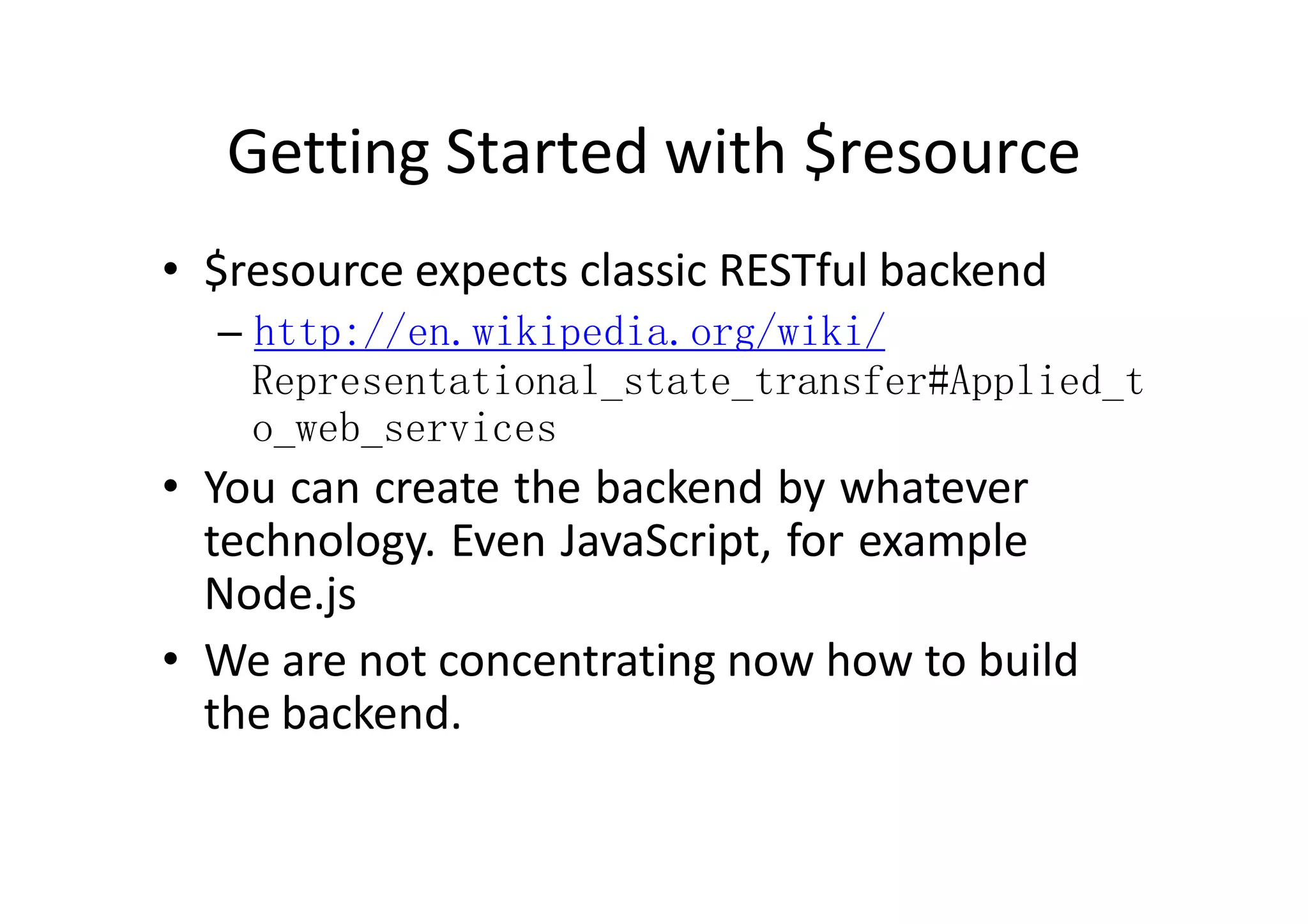
![Using $resource on GET // Load ngResource before this var restApp = angular.module('restApp',['ngResource']); restApp.controller("RestCtrl", function($scope, $resource) { $scope.doClick = function() { var title = $scope.movietitle; var searchString = 'http://api.rottentomatoes.com/api/ public/v1.0/movies.json?apikey=key&q=' + title + '&page_limit=5'; var result = $resource(searchString); // {method:'GET'var root = result.get(function() { $scope.movies = root.movies; }); } });](https://image.slidesharecdn.com/angularjs-intro-201215174146/75/Angular-jS-Introduction-by-Google-97-2048.jpg)

![Passing Parameters // Load ngResource before this var restApp = angular.module('restApp',['ngResource']); restApp.controller("RestCtrl", function($scope, $resource) { $scope.doClick = function() { var searchString = 'http://api.rottentomatoes.com/api/public/ v1.0/movies.json?apikey=key&q=:title&page_limit=5'; var result = $resource(searchString); var root = result.get({title: $scope.movietitle}, function() { $scope.movies = root.movies; }); } }); :title -‐> parametrized URL template Giving the parameter from $scope](https://image.slidesharecdn.com/angularjs-intro-201215174146/75/Angular-jS-Introduction-by-Google-99-2048.jpg)
![Using Services // Load ngResource before this var restApp = angular.module('restApp',['ngResource']); restApp.controller("RestCtrl", function($scope, MovieService) { $scope.doClick = function() { var root = MovieService.resource.get({title: $scope.movietitle}, function() { $scope.movies = root.movies; }); }}); restApp.factory('MovieService', function($resource) { factory = {}; factory.resource = $resource('http://api.rottentomatoes...&q=:title&page_limit=5'); return factory; }); Controller responsible for binding Service responsible for the resource](https://image.slidesharecdn.com/angularjs-intro-201215174146/75/Angular-jS-Introduction-by-Google-100-2048.jpg)
![Simple Version // Load ngResource before this var restApp = angular.module('restApp',['ngResource']); MovieService) { $scope.movietitle}, restApp.controller("RestCtrl", function($scope, $scope.doClick = function() { var root = MovieService.get({title: function() { $scope.movies = root.movies; }); } }); restApp.factory('MovieService', function($resource) { return $resource('http://api.rottentomatoes...&q=:title&page_limit=5');; }); Just call get from MovieService Returns the resource](https://image.slidesharecdn.com/angularjs-intro-201215174146/75/Angular-jS-Introduction-by-Google-101-2048.jpg)

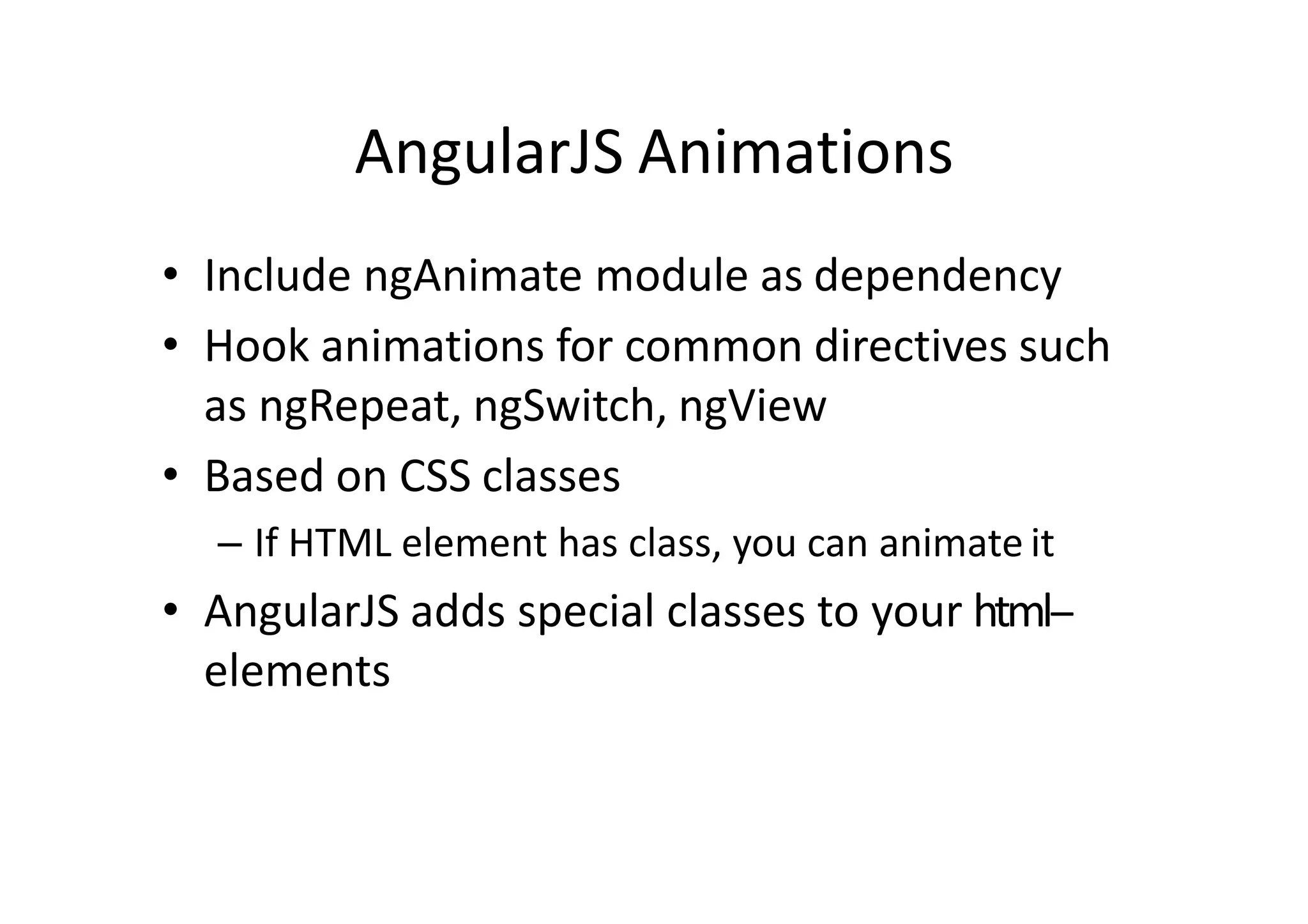
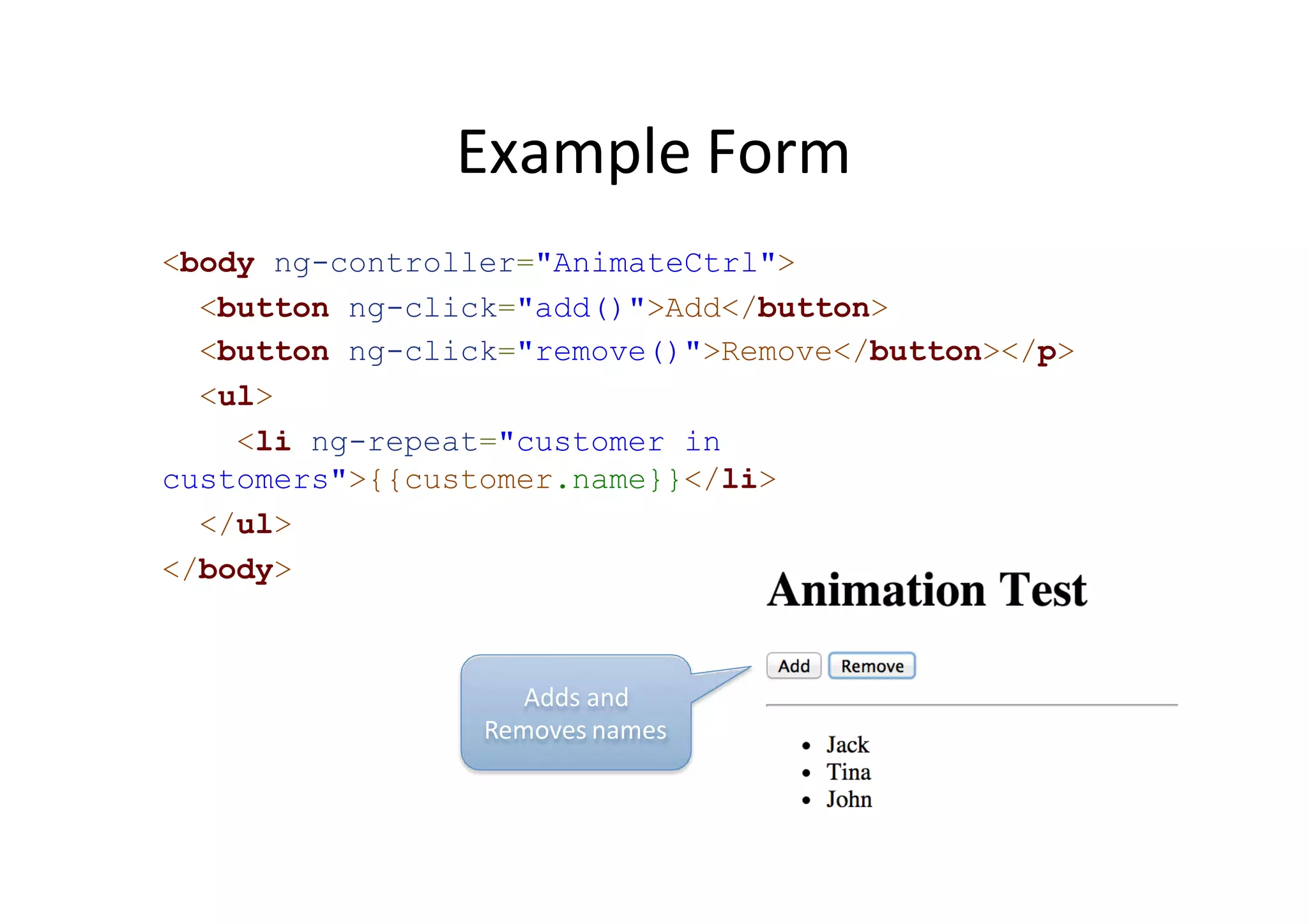

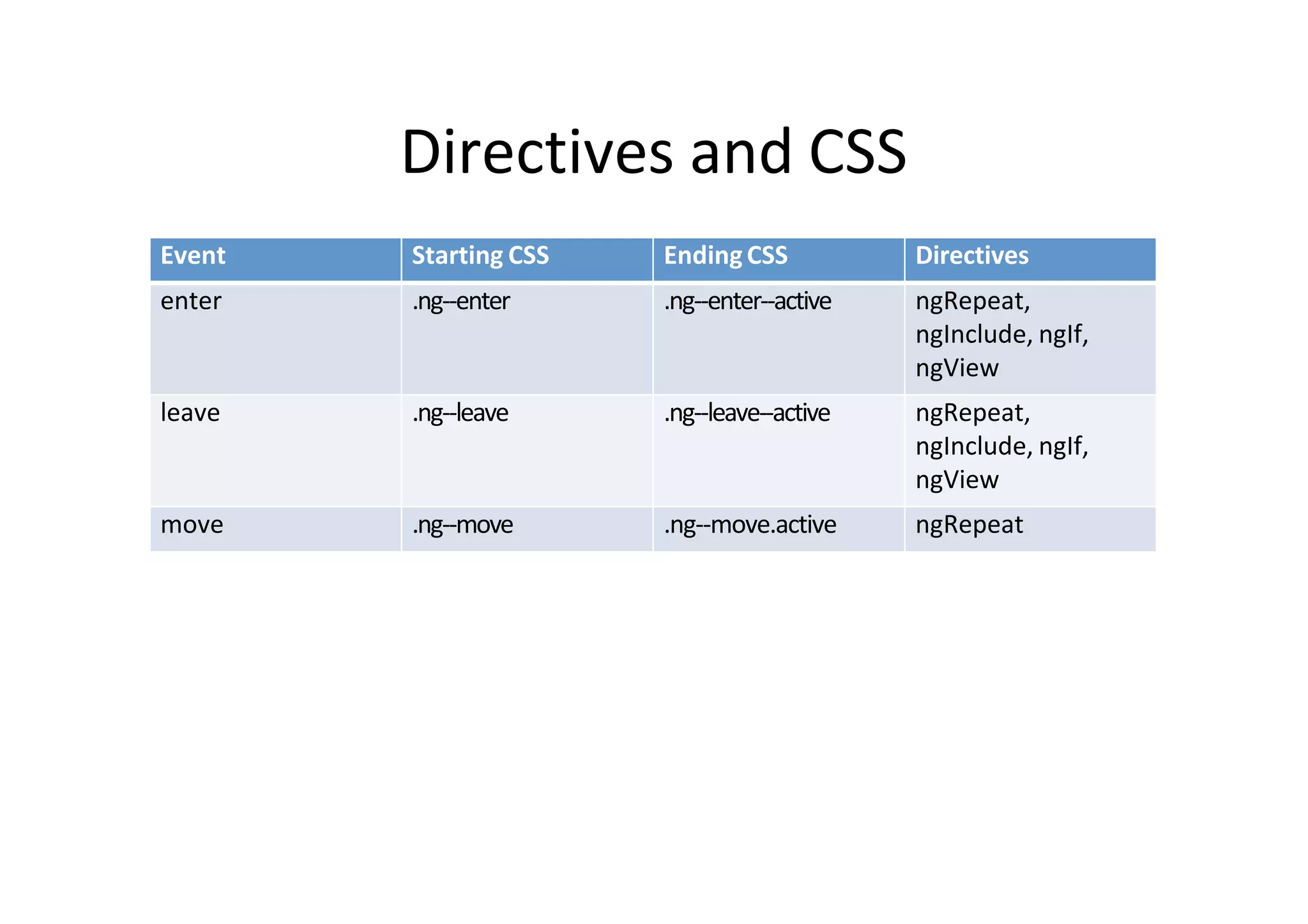
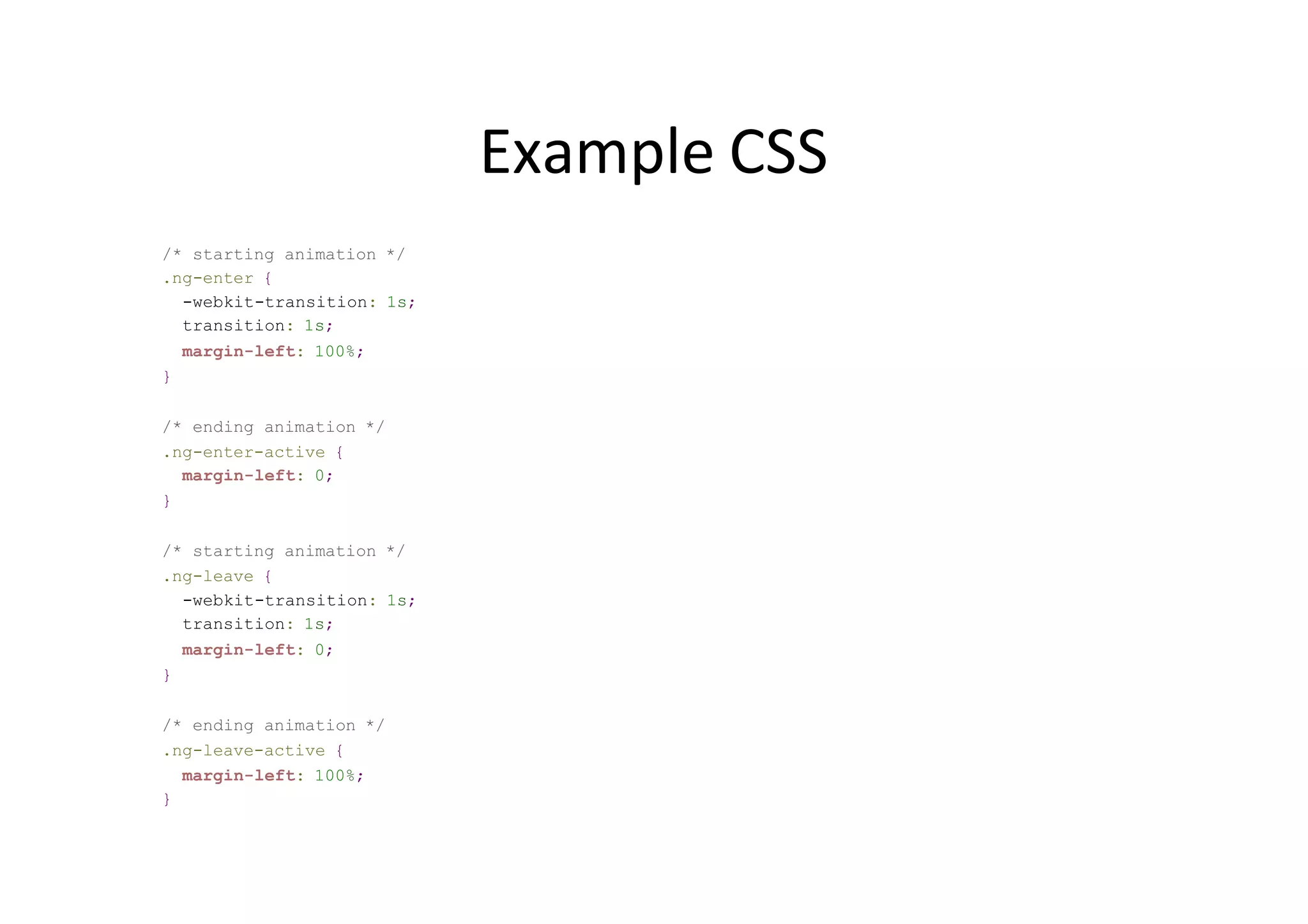
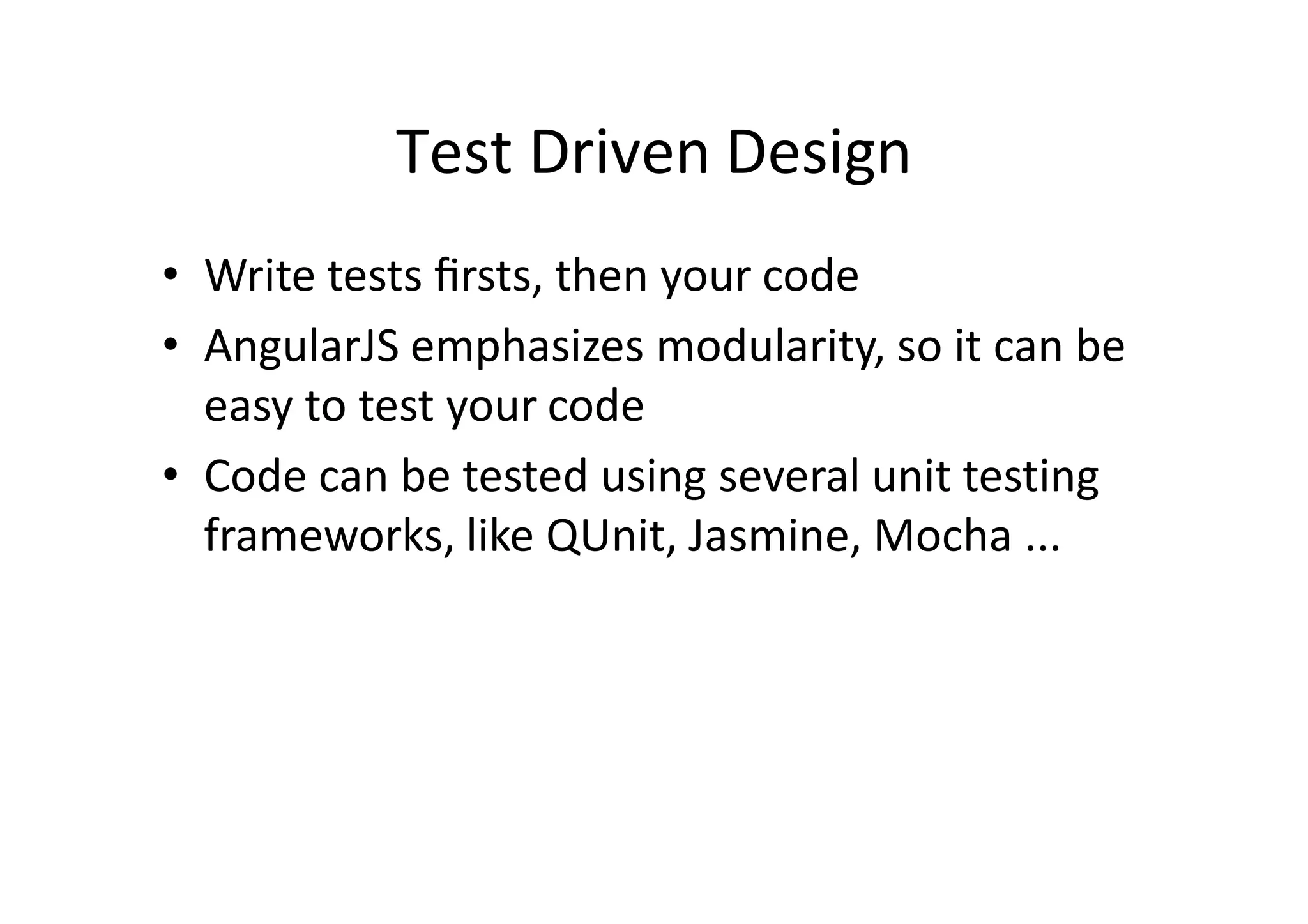

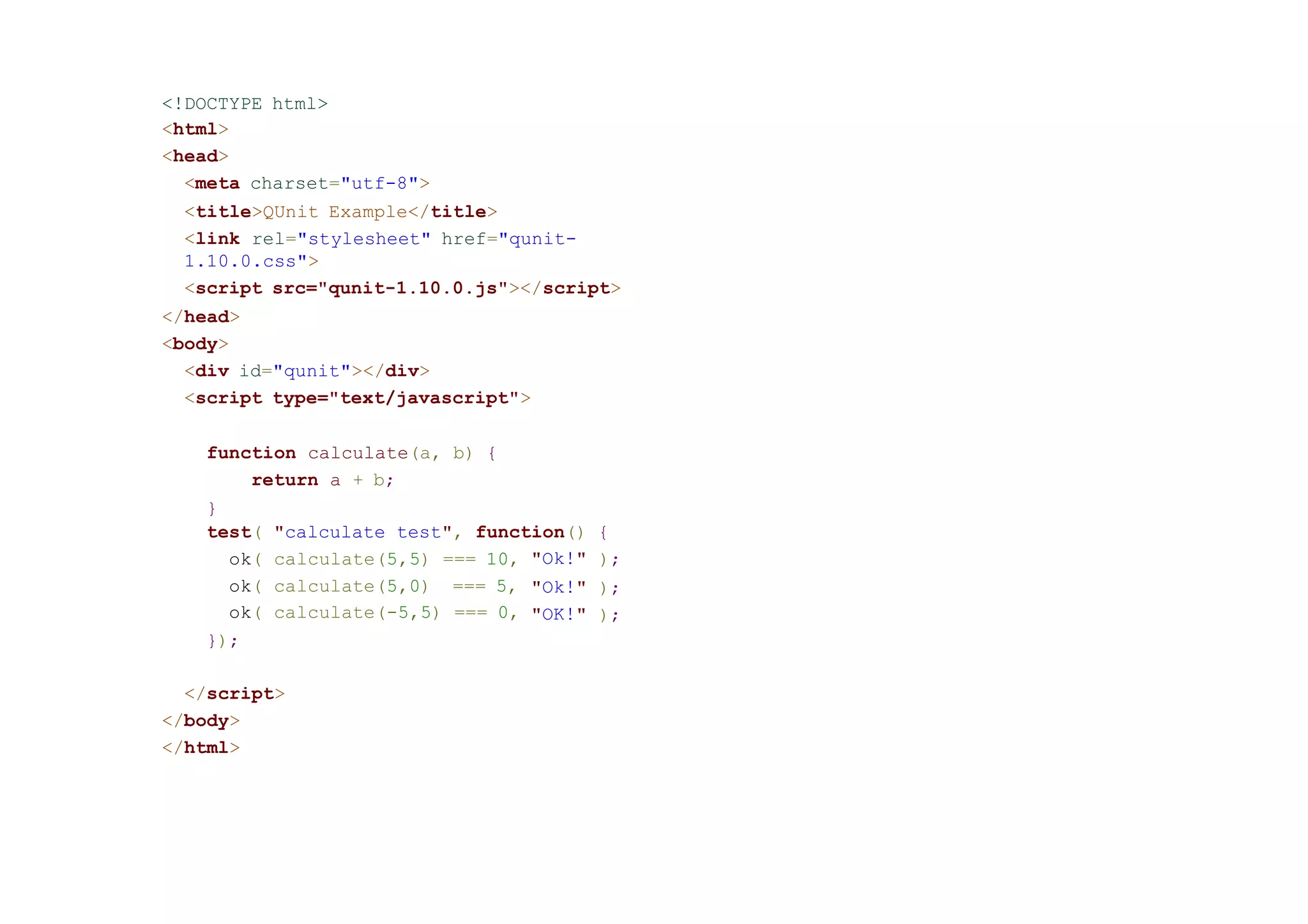
![Three Assertions • Basic – ok( boolean [, message]); • If actual == expected – equal( actual, expected [, message]); • if actual === expected – deepEqual( actual, expected [, message)); • Other – http://qunitjs.com/cookbook/#automating- unit-testing](https://image.slidesharecdn.com/angularjs-intro-201215174146/75/Angular-jS-Introduction-by-Google-111-2048.jpg)
![Testing AngularJS Service var myApp = angular.module('myApp', []); // One service myApp.service('MyService', function() { function(a, b) { a + b; this.add = return }; }); /* TESTS */ var injector = angular.injector(['ng', 'myApp']); QUnit.test('MyService', function() { var MyService = injector.get('MyService'); ok(2== MyService.add(1, 1)); });](https://image.slidesharecdn.com/angularjs-intro-201215174146/75/Angular-jS-Introduction-by-Google-112-2048.jpg)

